
Chapter 8 Introduction and Overview of Hematology and Immunology
...

Chapter 8.1 Word Parts Associated with the Hematological/Immunological Systems
Word Roots of the Hematological System Part 1
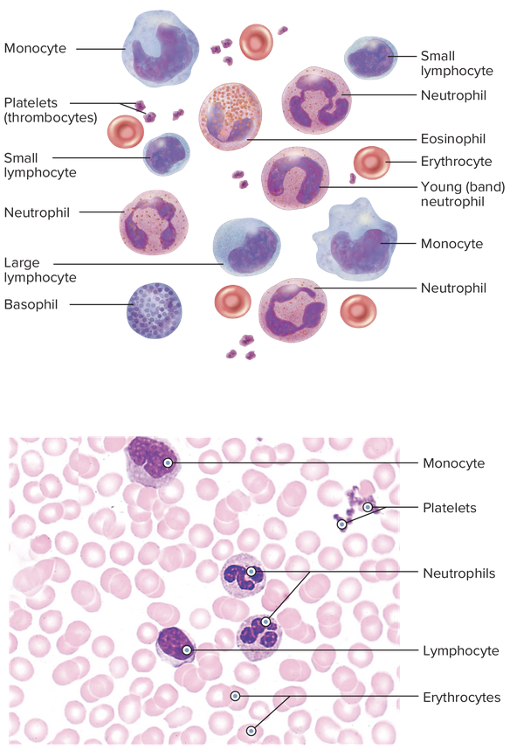
Chapter 8.1 Word Parts Associated with the Hematological/Immunological Systems
Word Roots of the Hematological System Part 2

Chapter 8.1 Word Parts Associated with the Hematological/Immunological Systems
Word Roots of the Hematological System Part 3
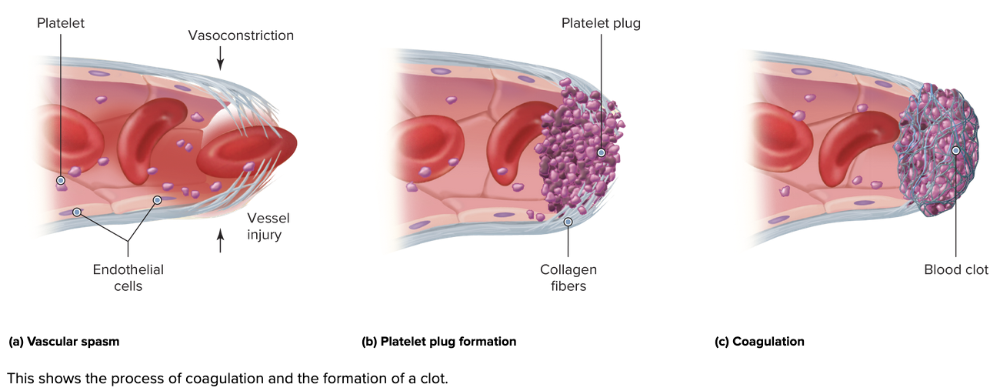
Chapter 8.1 Word Parts Associated with the Hematological/Immunological Systems
Word Roots of the Hematological System Part 4
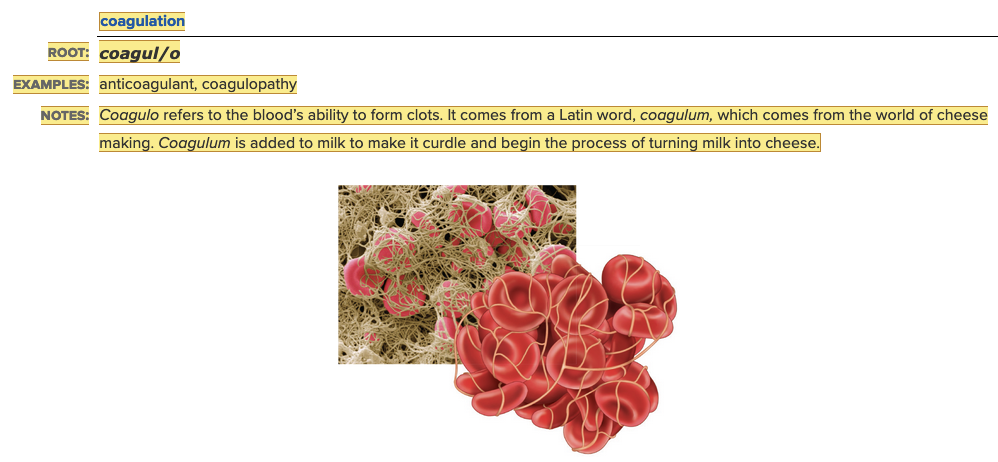
Chapter 8.1 Word Parts Associated with the Hematological/Immunological Systems
Word Roots of the Hematological System
- Word Roots for Blood Table Part 1
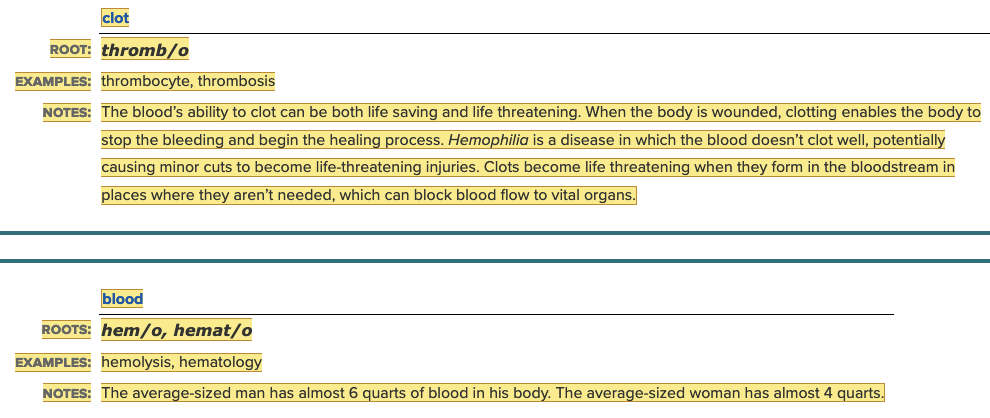
Chapter 8.1 Word Parts Associated with the Hematological/Immunological Systems
Word Roots of the Hematological System
- Word Roots for Blood Table Part 2
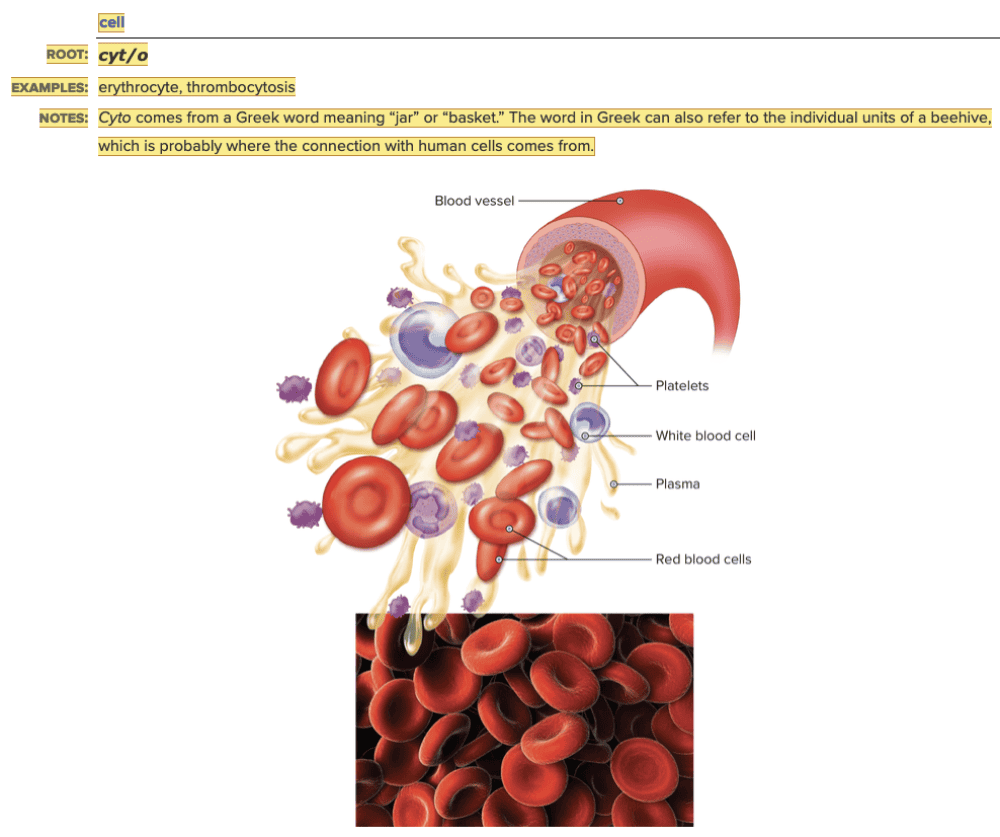
Chapter 8.1 Word Parts Associated with the Hematological/Immunological Systems
Word Roots of the Hematological System
- Word Roots for Blood Table Part 3
...
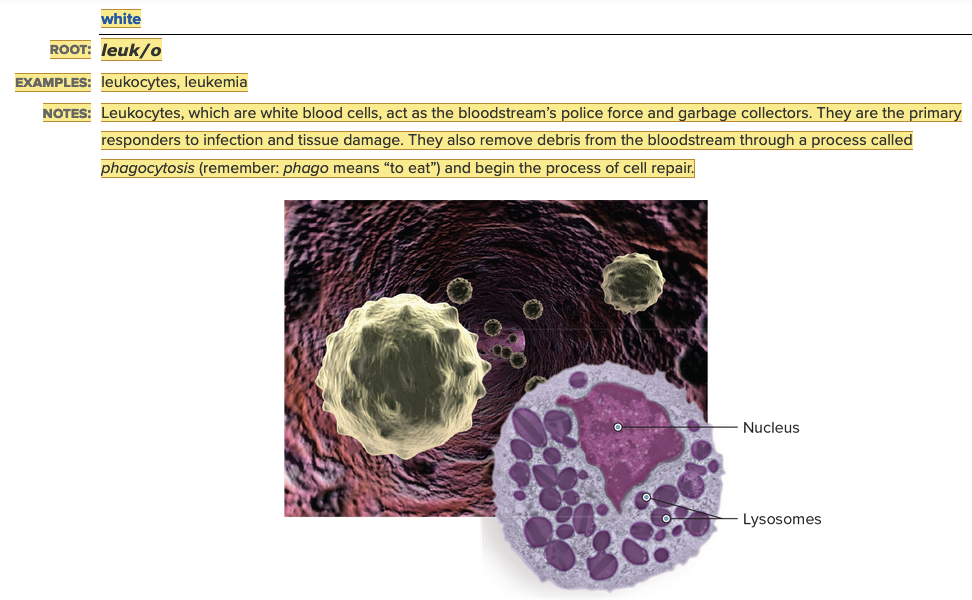
Chapter 8.1 Word Parts Associated with the Hematological/Immunological Systems
Word Roots of the Hematological System
- Word Roots for Blood Table Part 4a
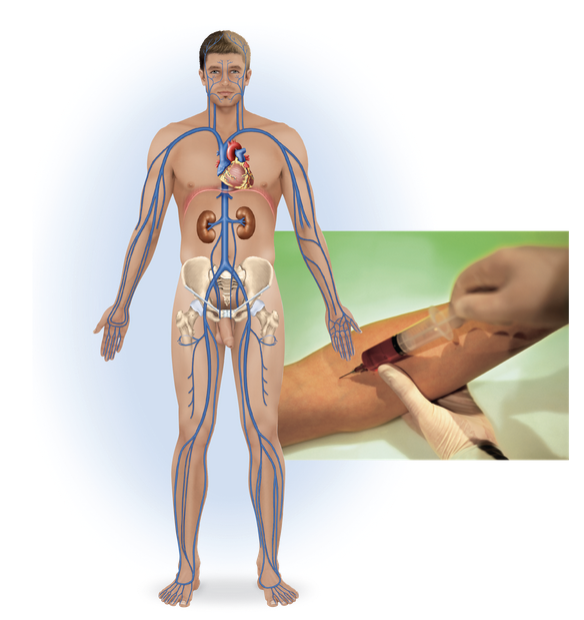
Chapter 8.1 Word Parts Associated with the Hematological/Immunological Systems
Word Roots of the Hematological System
- Word Roots for Blood Table Part 4b

Chapter 8.1 Word Parts Associated with the Hematological/Immunological Systems
Word Roots of the Hematological System
- Word Roots for Blood Table Part 5
...
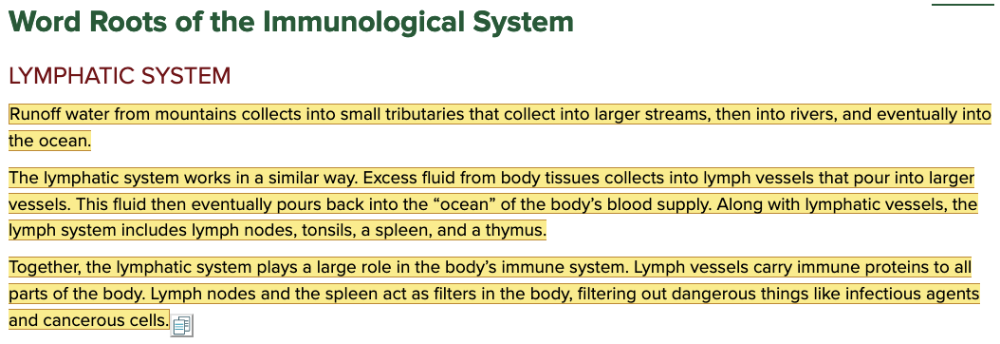
Chapter 8.1 Word Parts Associated with the Hematological/Immunological Systems
Word Roots of the Immunological System
- Lymphatic System Part 1
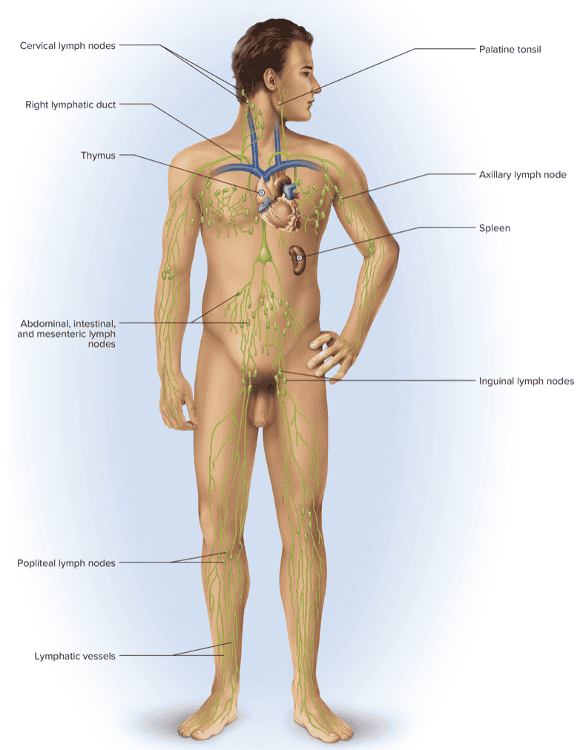
Chapter 8.1 Word Parts Associated with the Hematological/Immunological Systems
Word Roots of the Immunological System
- Lymphatic System Part 2
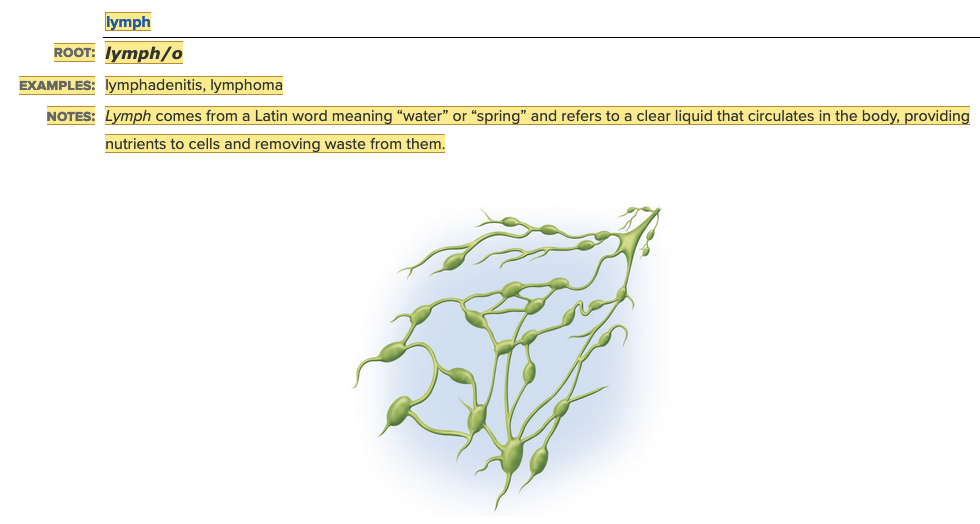
Chapter 8.1 Word Parts Associated with the Hematological/Immunological Systems
Word Roots of the Immunological System
- Word Roots for Lymphatic System Table Part 1
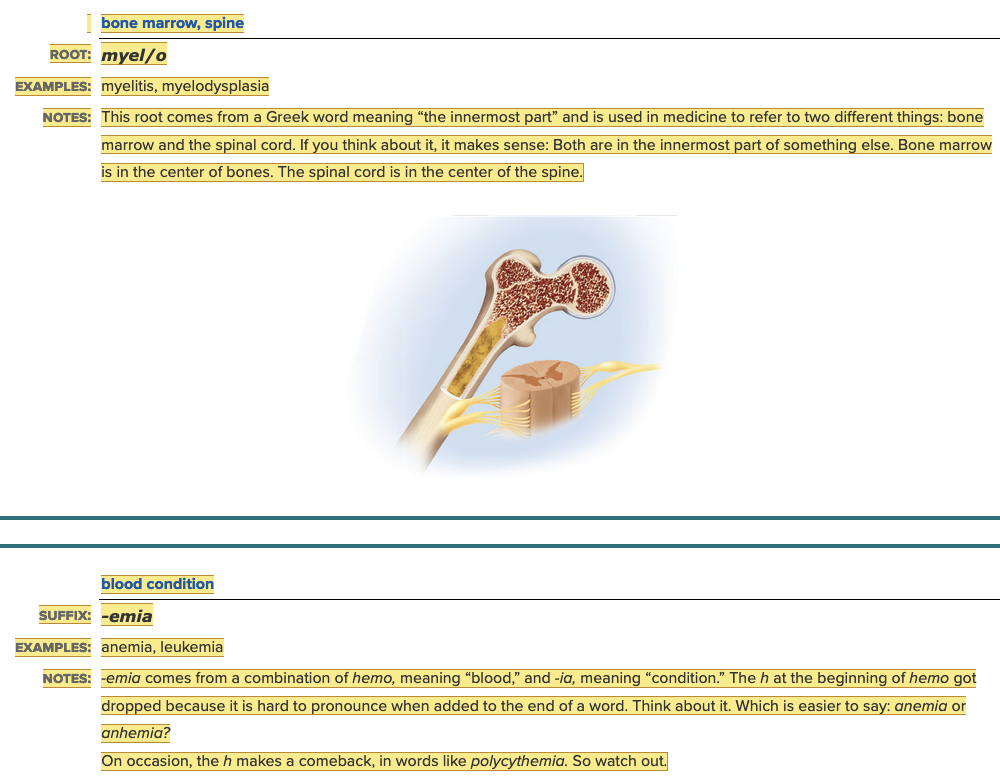
Chapter 8.1 Word Parts Associated with the Hematological/Immunological Systems
Word Roots of the Immunological System
- Word Roots for Lymphatic System Table Part 2
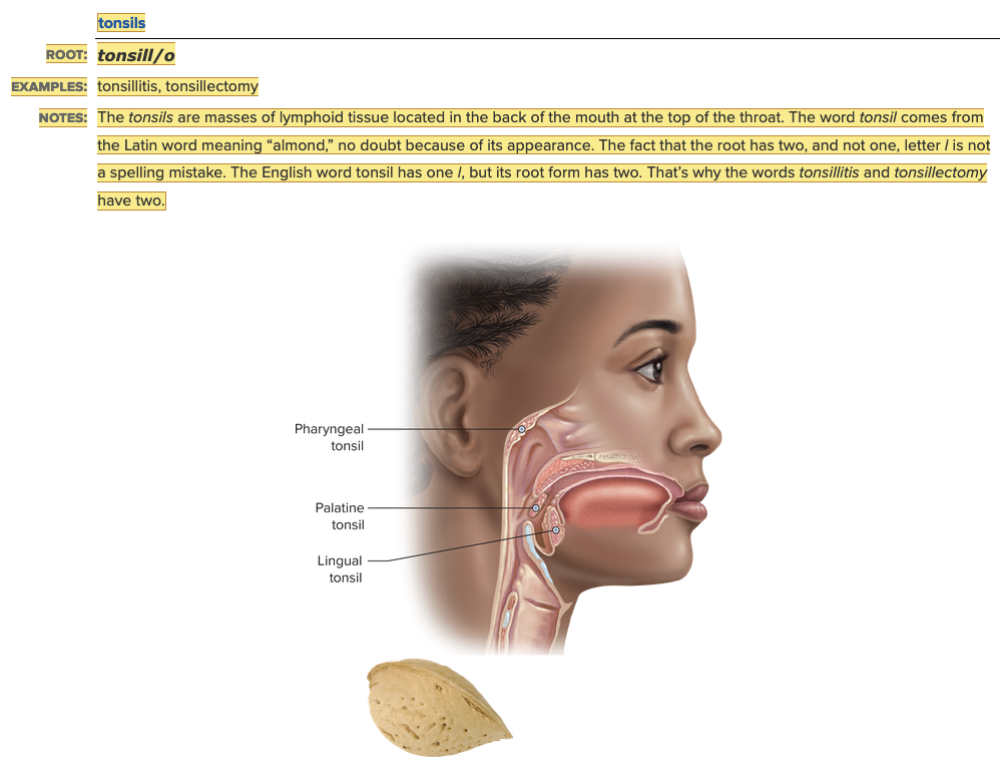
Chapter 8.1 Word Parts Associated with the Hematological/Immunological Systems
Word Roots of the Immunological System
- Word Roots for Lymphatic System Table Part 3
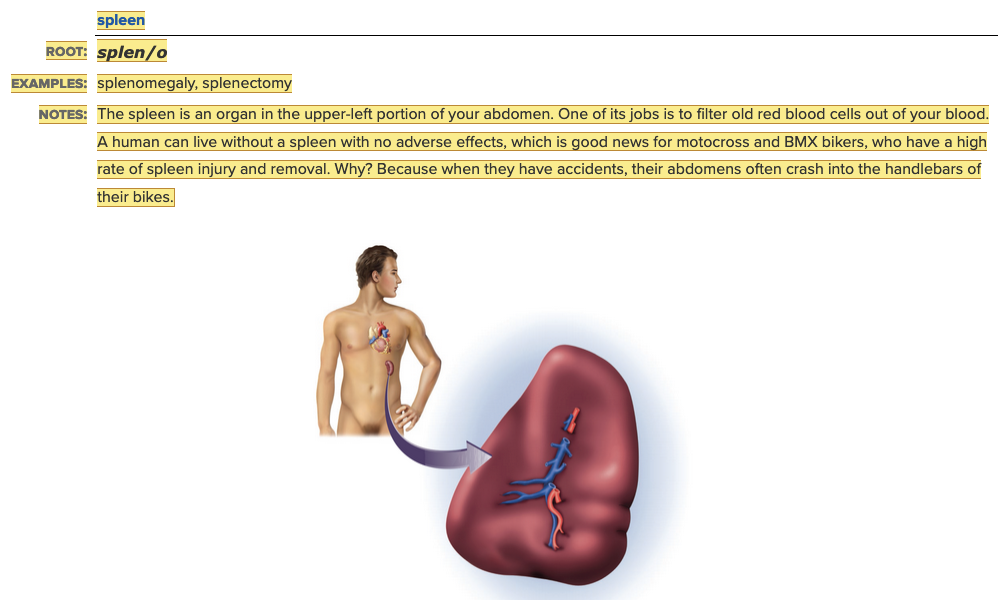
Chapter 8.1 Word Parts Associated with the Hematological/Immunological Systems
Word Roots of the Immunological System
- Word Roots for Lymphatic System Table Part 4
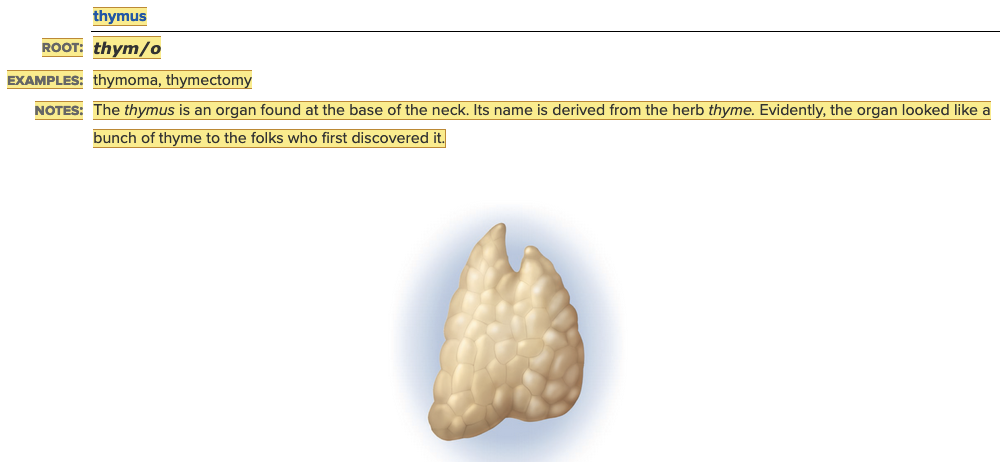
Chapter 8.1 Word Parts Associated with the Hematological/Immunological Systems
Word Roots of the Immunological System
- Word Roots for Lymphatic System Table Part 5
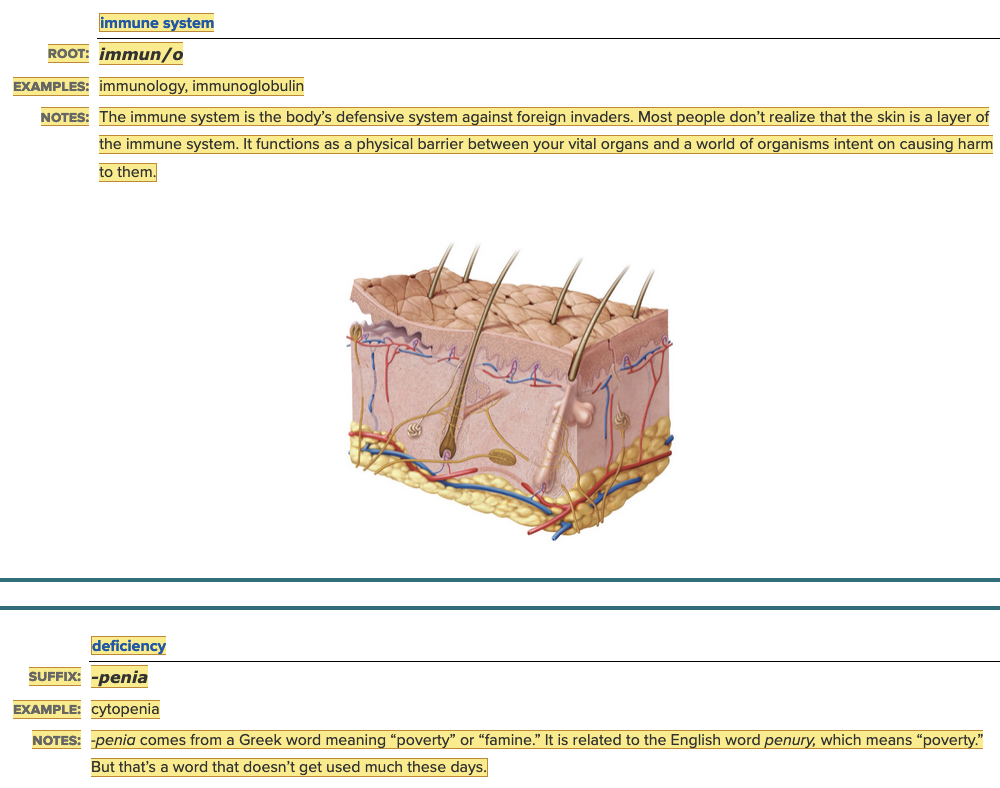
Chapter 8.1 Word Parts Associated with the Hematological/Immunological Systems
Word Roots of the Immunological System
- Word Roots for Lymphatic System Table Part 6
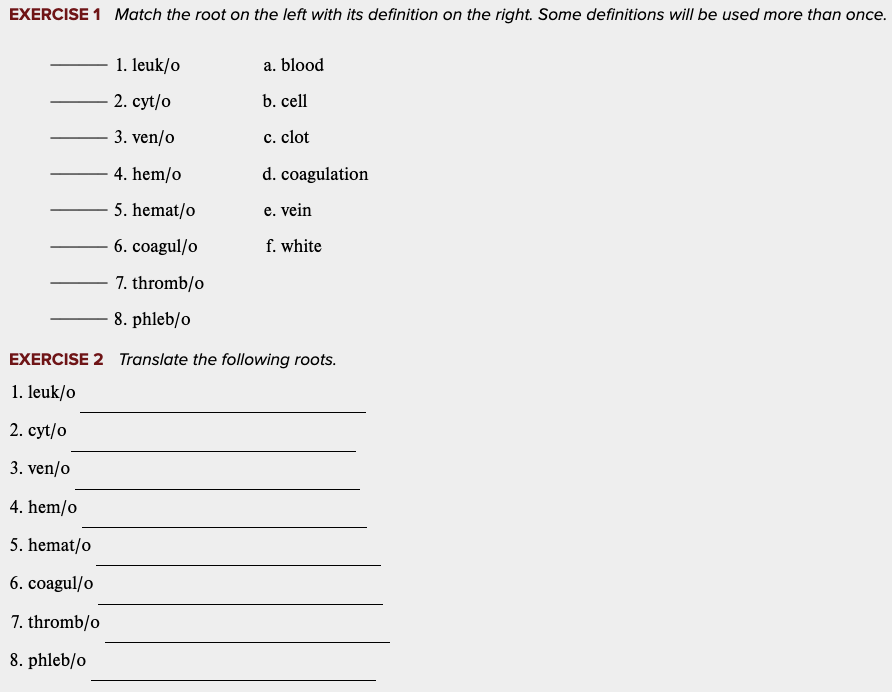
Learning Outcome 8.1 Exercises: Exercise 1, 2.
...
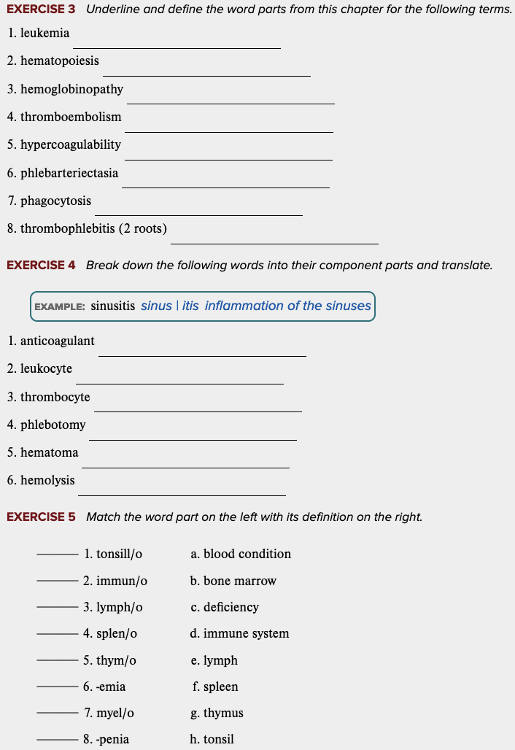
Learning Outcome 8.1 Exercises: Exercise 3, 4, 5.
...
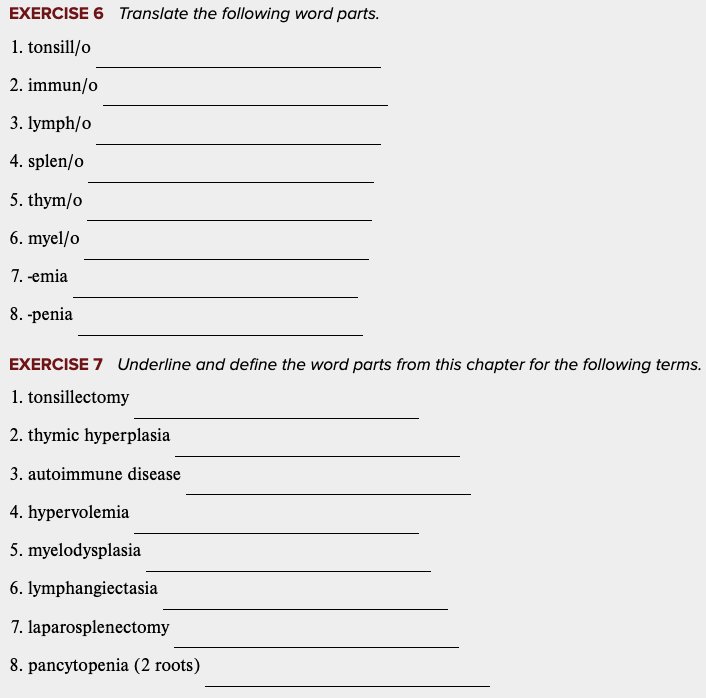
Learning Outcome 8.1 Exercises: Exercise 6, 7.
...
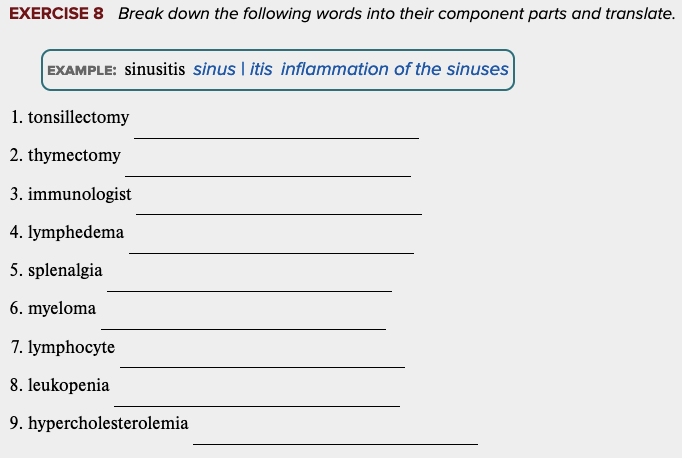
Learning Outcome 8.1 Exercises: Exercise 8.
...
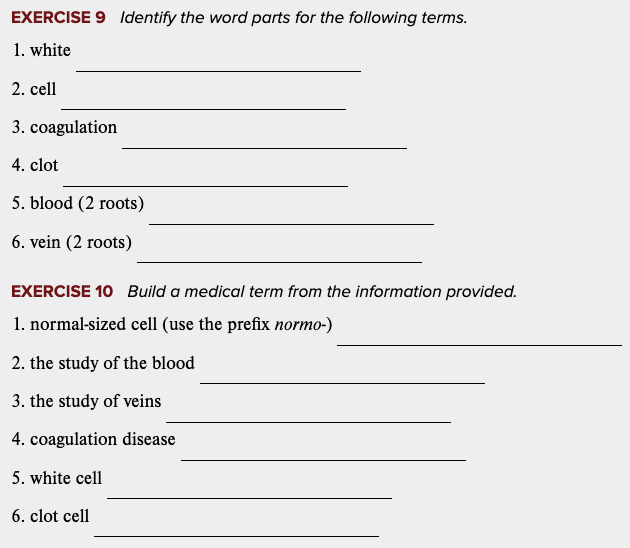
Learning Outcome 8.1 Exercises: Exercise 9, 10.
...
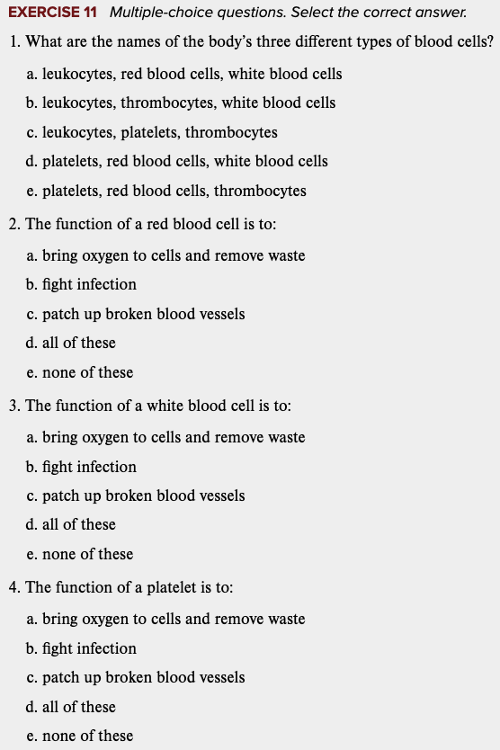
Learning Outcome 8.1 Exercises: Exercise 11 part 1.
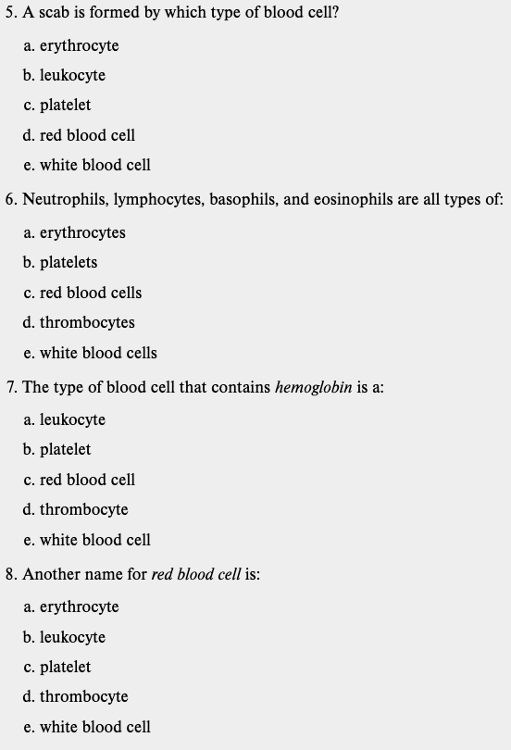
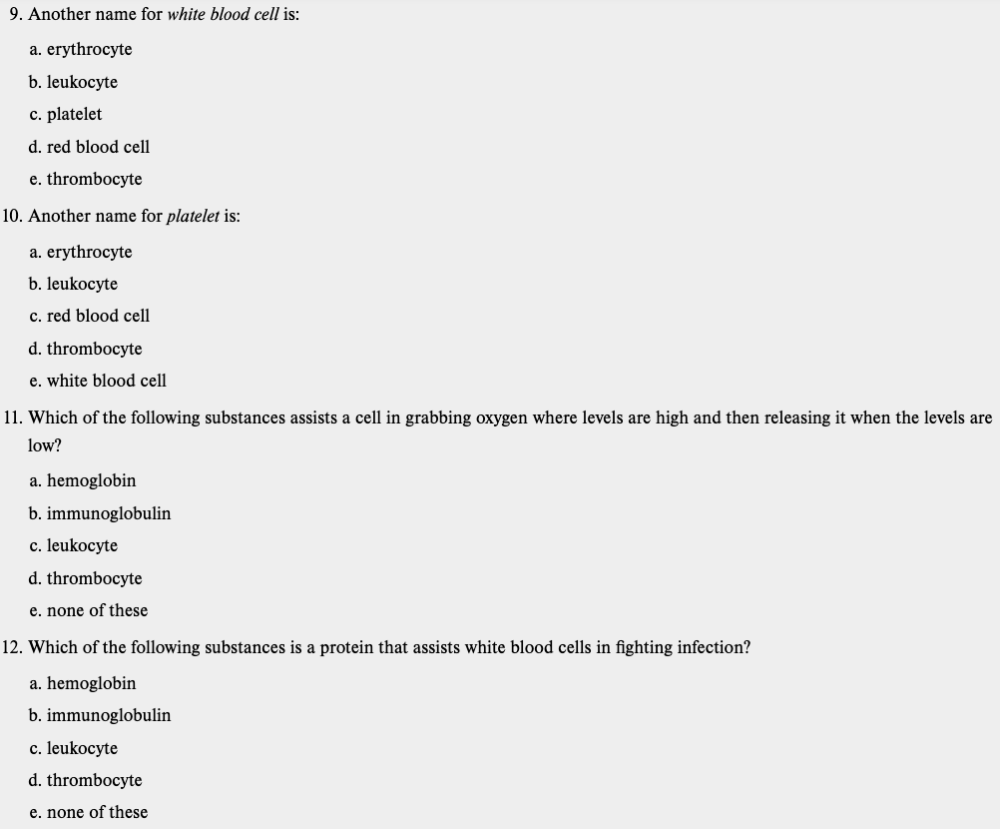
Learning Outcome 8.1 Exercises: Exercise 11 part 2.
...
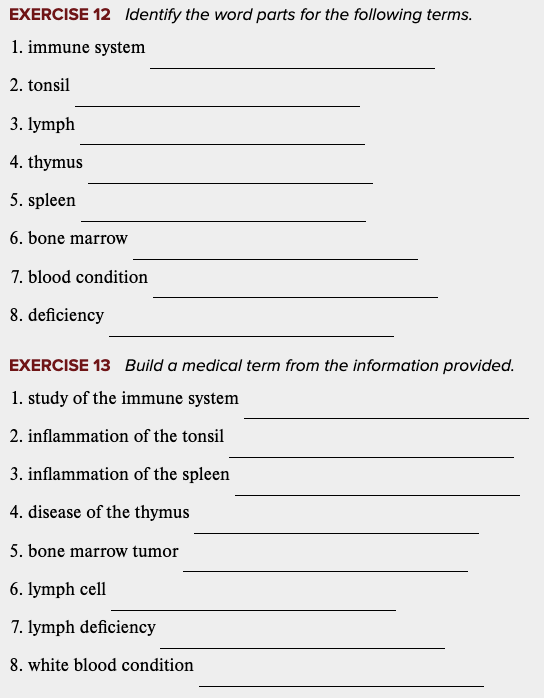
Learning Outcome 8.1 Exercises: Exercise 12, 13.
...
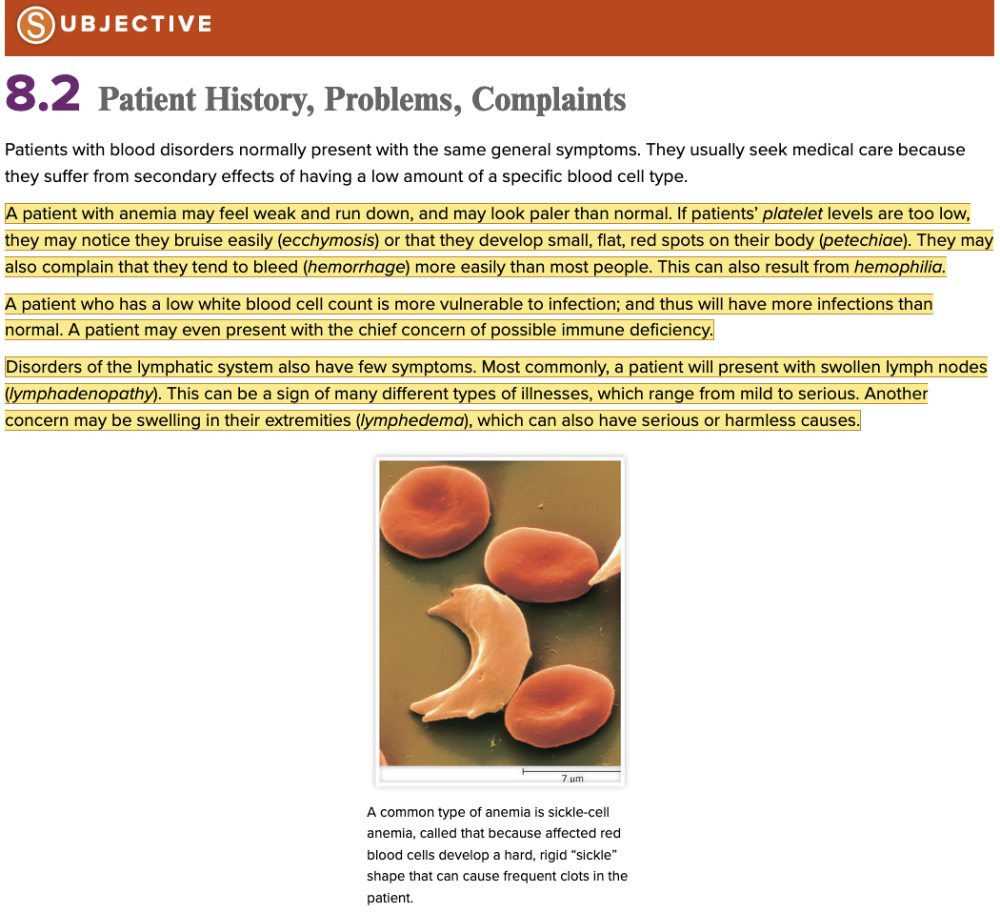
Chapter 8.2 Patient History, Problems, Complaints
- Subjective Part 1
...
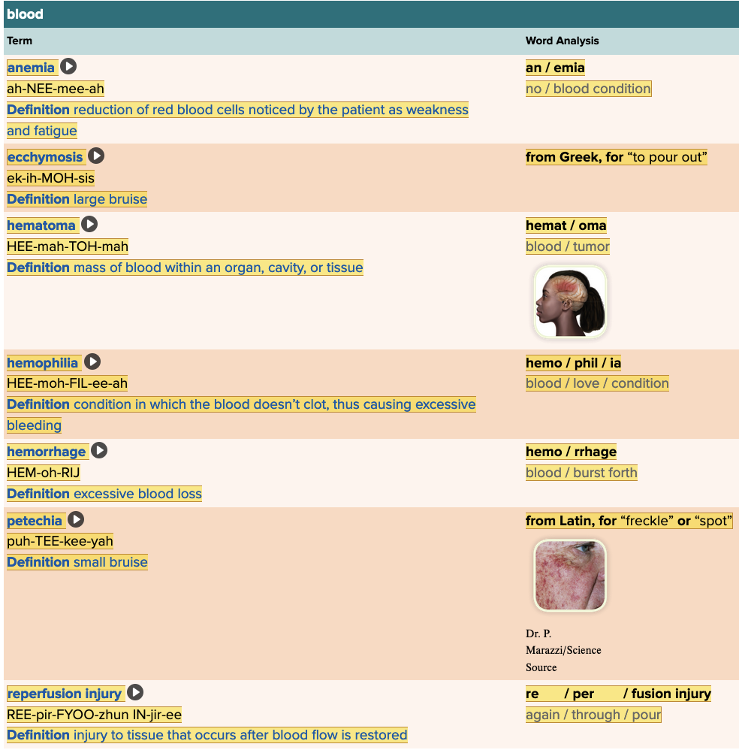
Chapter 8.2 Patient History, Problems, Complaints
- Subjective: Blood Table
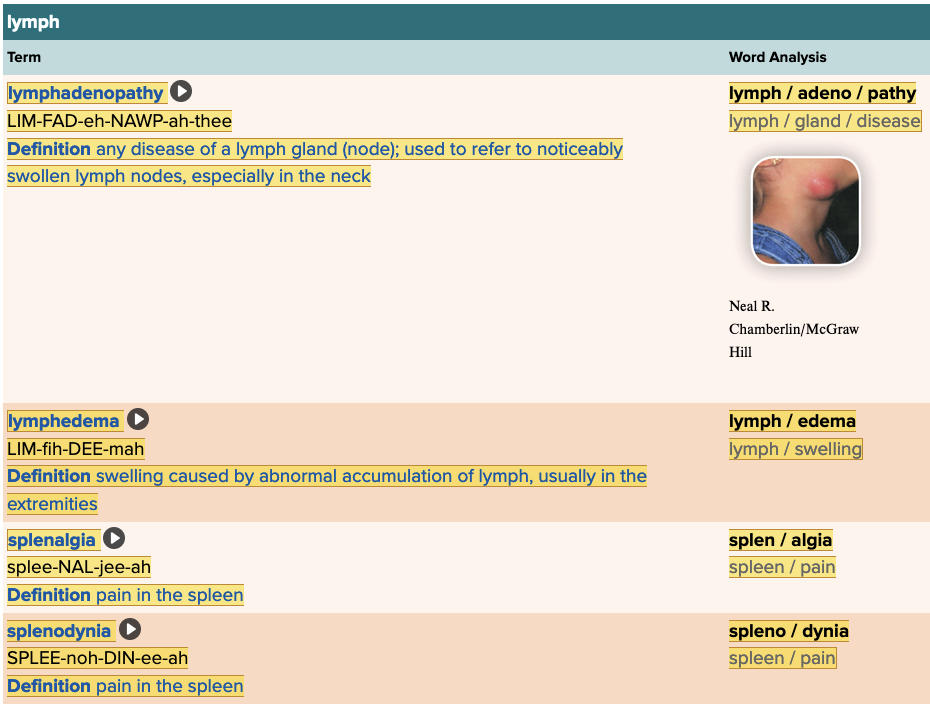
Chapter 8.2 Patient History, Problems, Complaints
- Subjective: Lymph Table
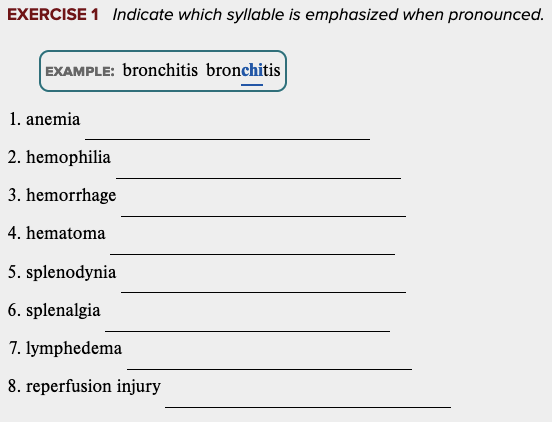
Learning Outcome 8.2 Exercises: Exercise 1.
...
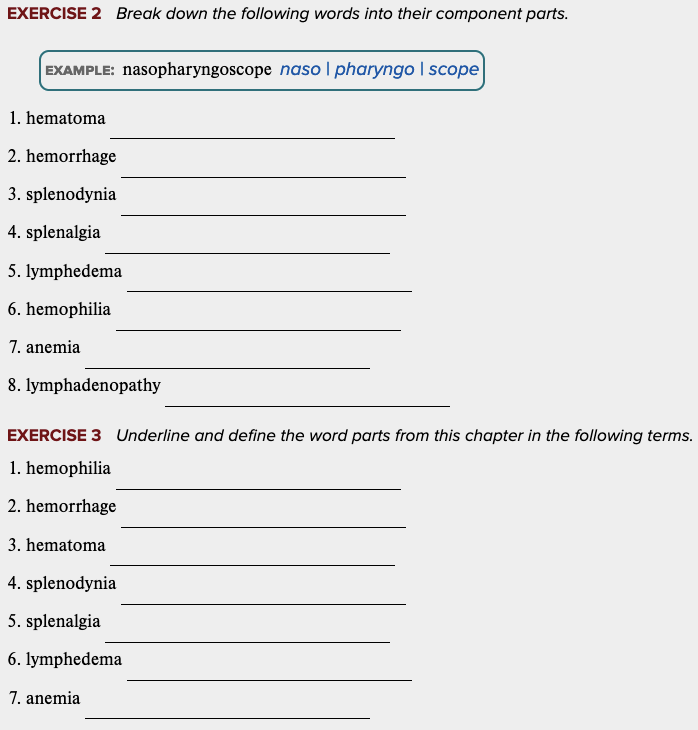
Learning Outcome 8.2 Exercises: Exercise 2, 3.
...
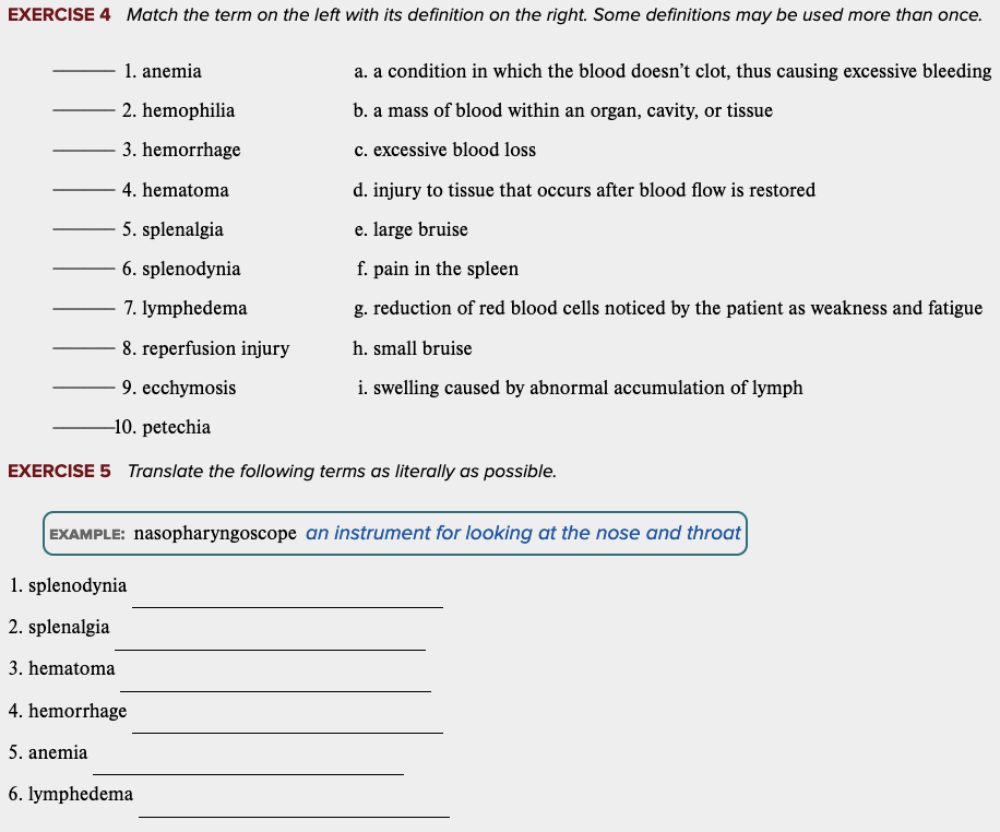
Learning Outcome 8.2 Exercises: Exercise 4, 5.
...
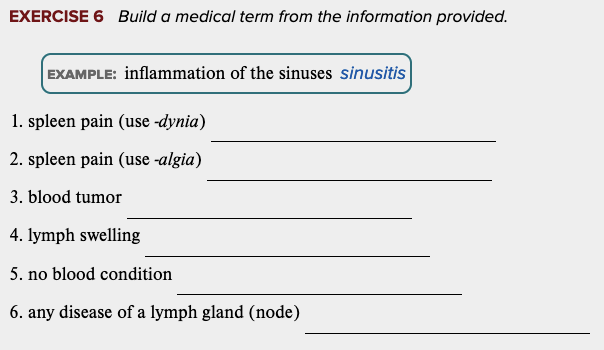
Learning Outcome 8.2 Exercises: Exercise 6.
...
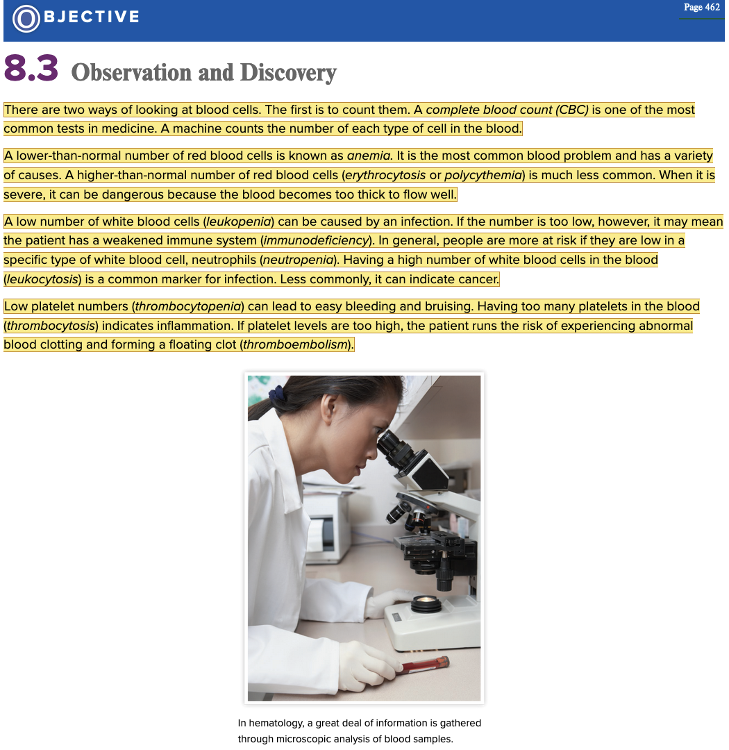
Chapter 8.3 Observation and Discovery
- Objective Part 1
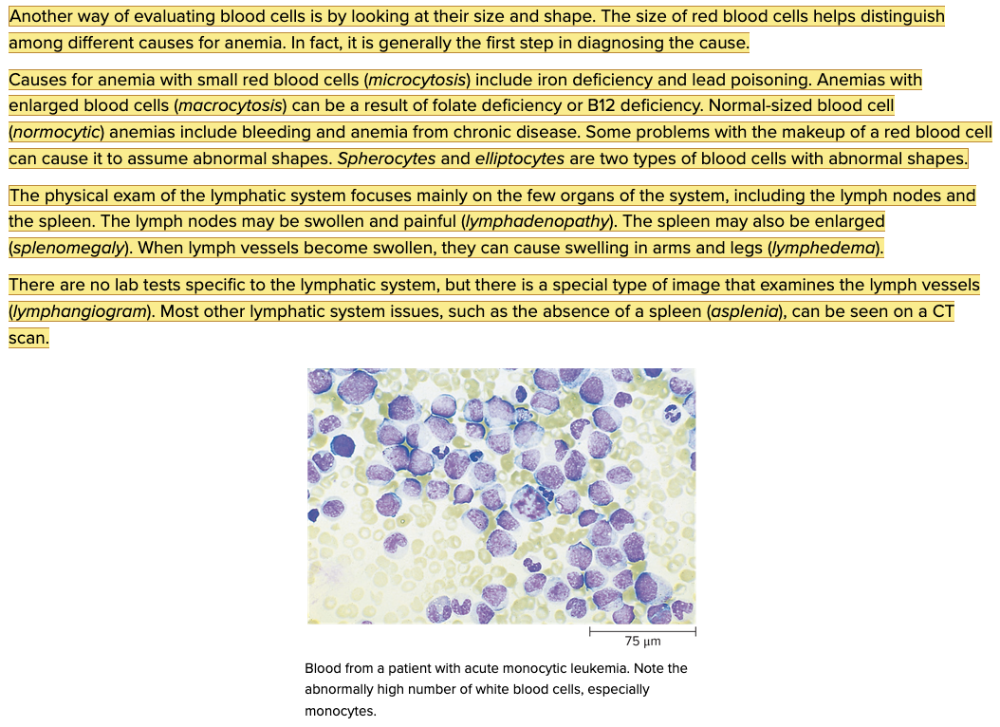
Chapter 8.3 Observation and Discovery
- Objective Part 2
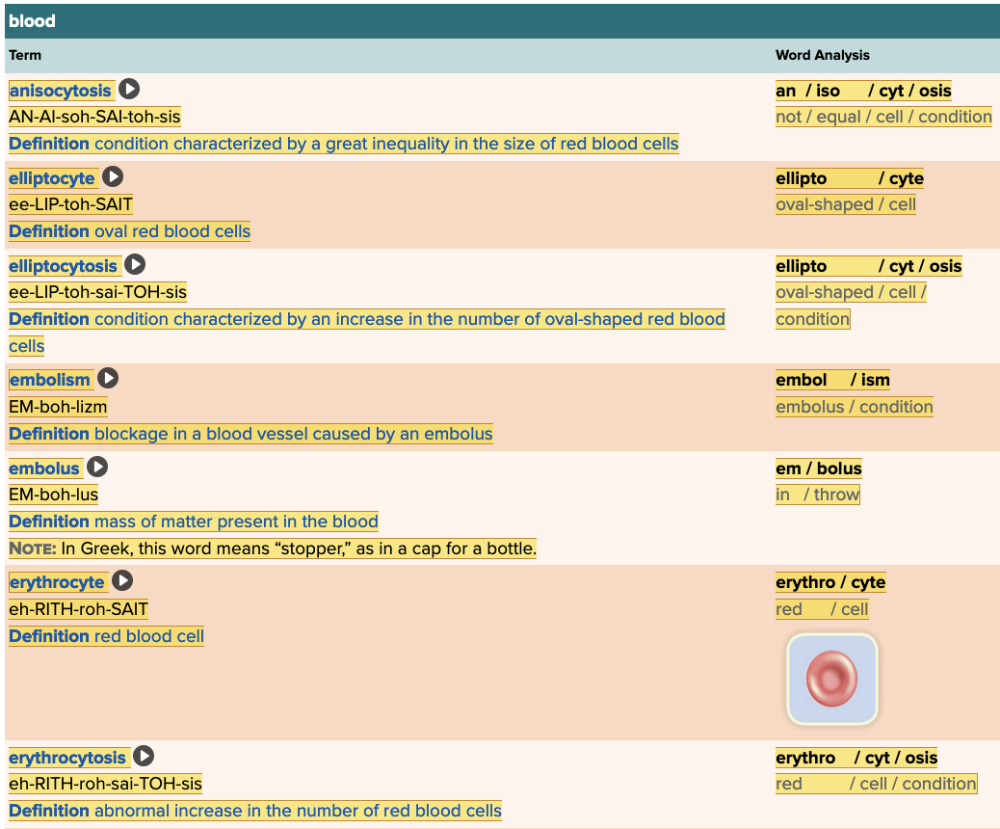
Chapter 8.3 Observation and Discovery
- Objective: Blood Table Part 1
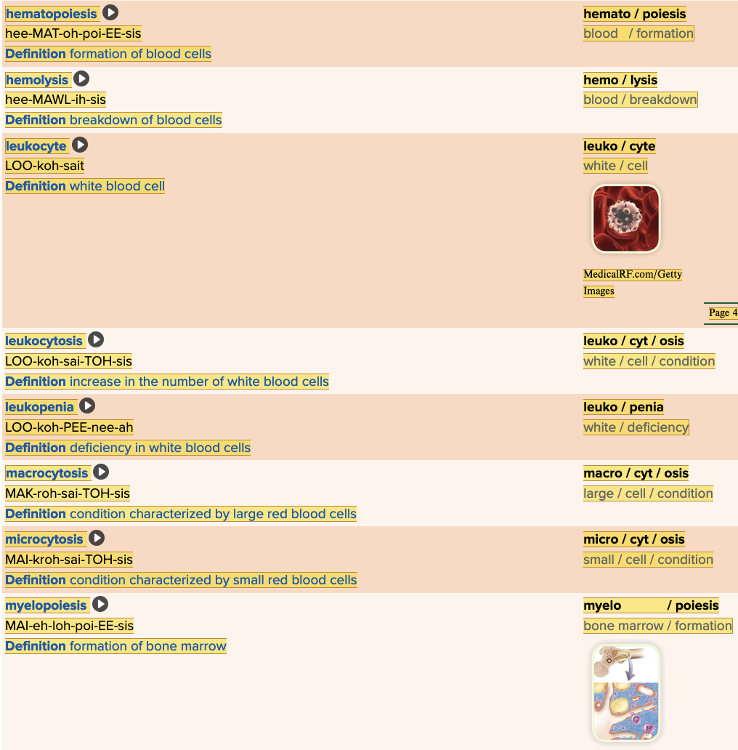
Chapter 8.3 Observation and Discovery
- Objective: Blood Table Part 2
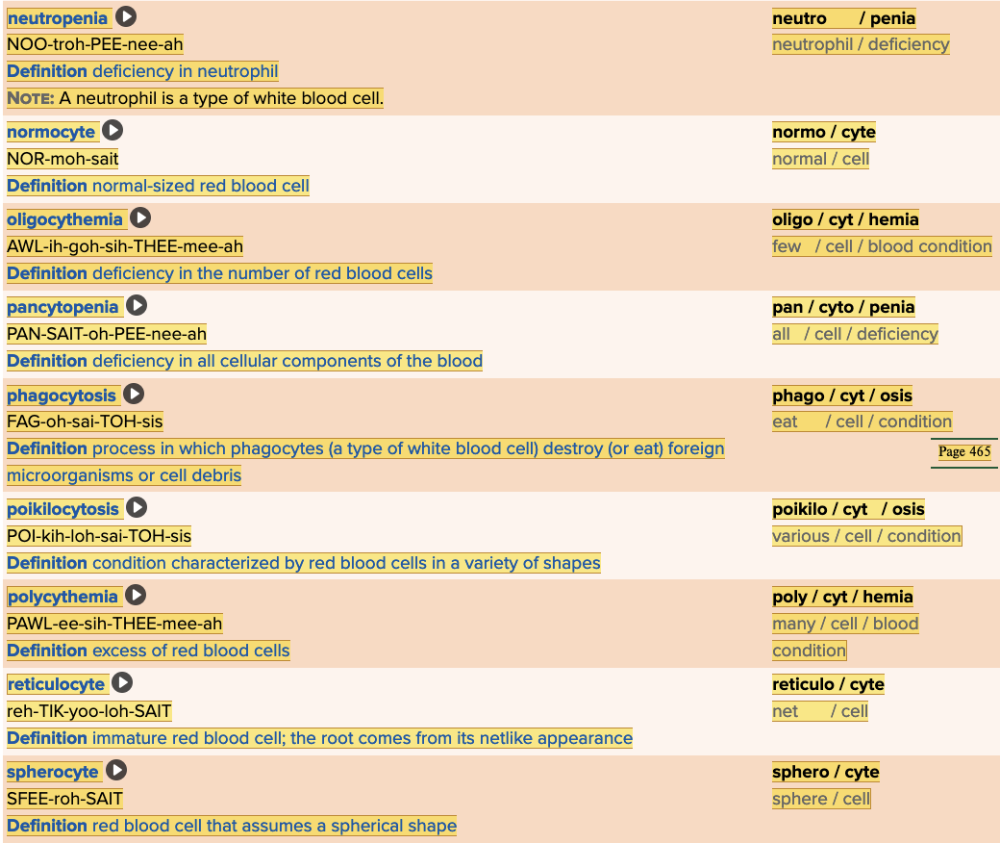
Chapter 8.3 Observation and Discovery
- Objective: Blood Table Part 3
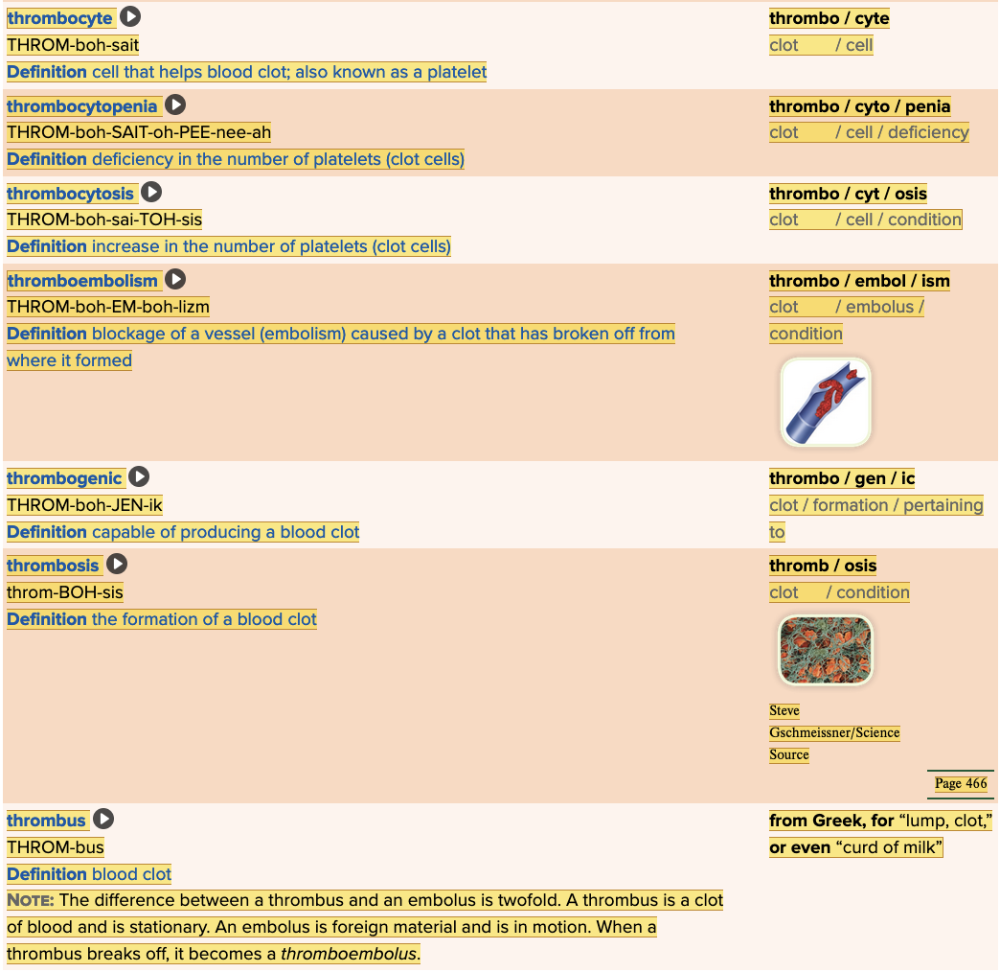
Chapter 8.3 Observation and Discovery
- Objective: Blood Table Part 4
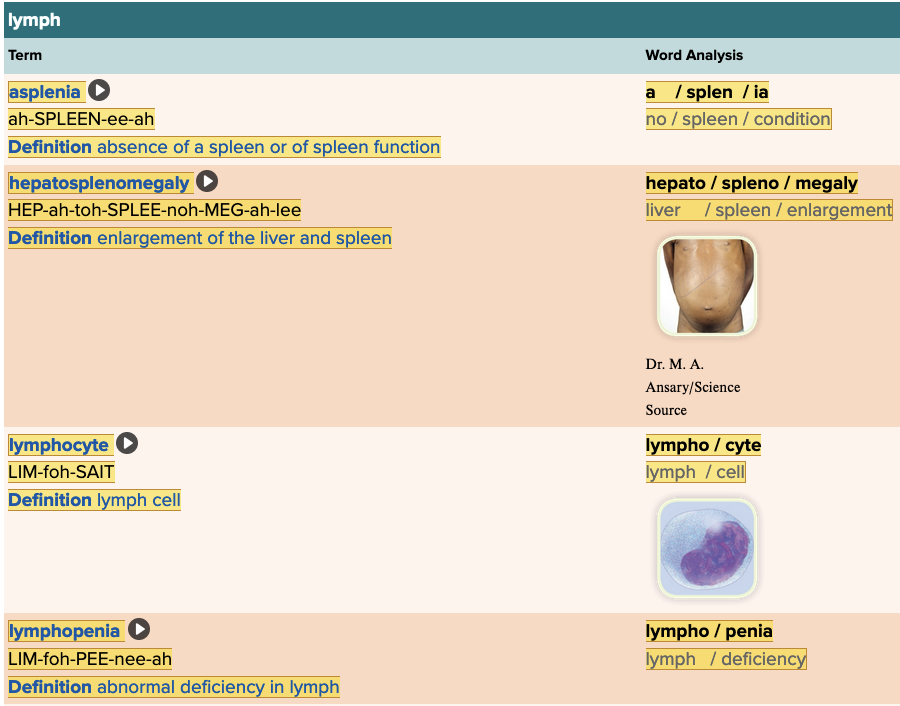
Chapter 8.3 Observation and Discovery
- Objective: Lymph Table Part 1
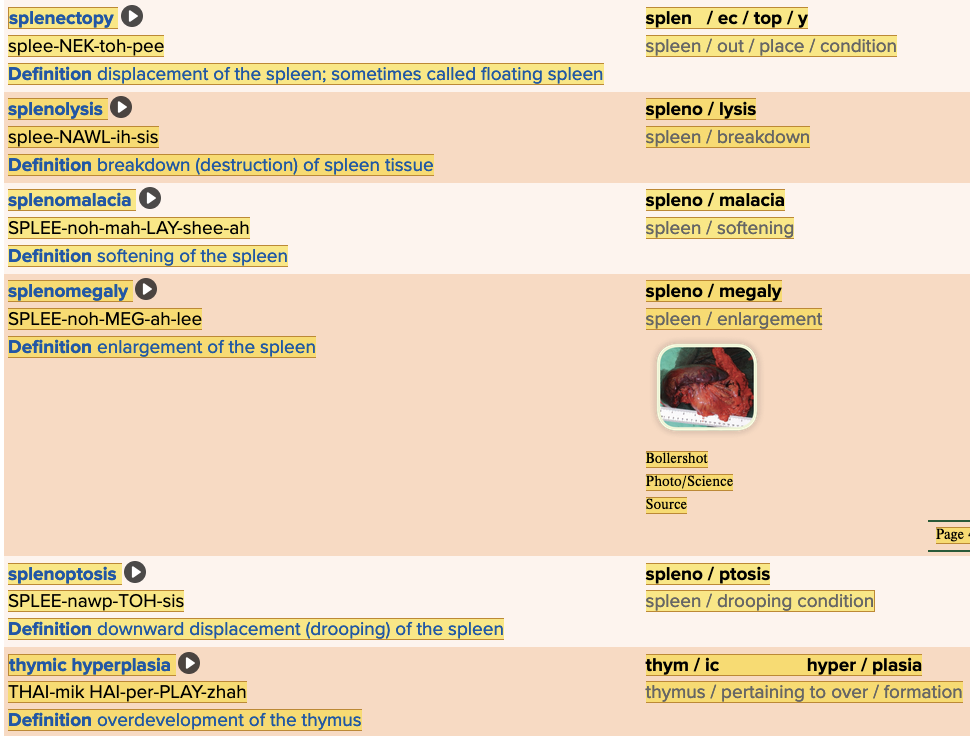
Chapter 8.3 Observation and Discovery
- Objective: Lymph Table Part 2
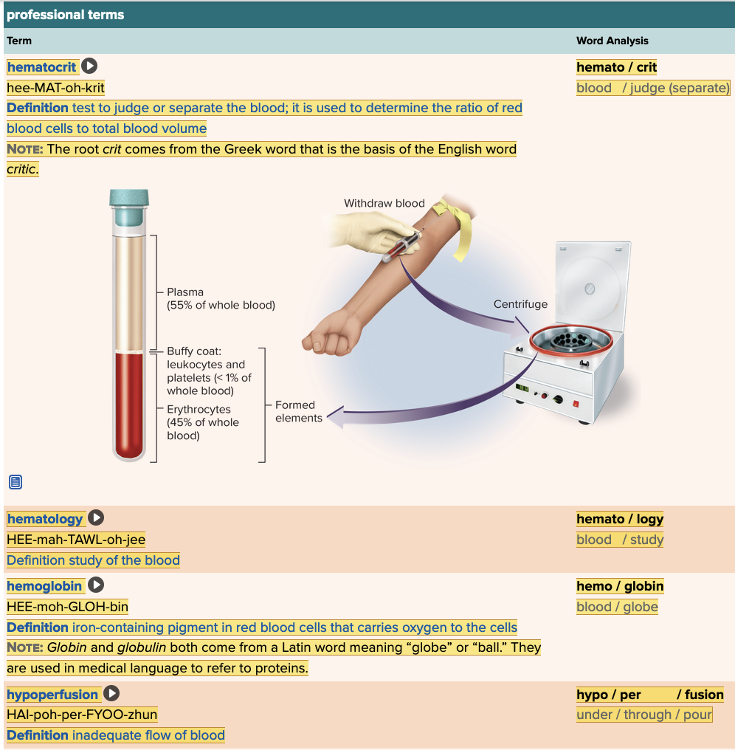
Chapter 8.3 Observation and Discovery
- Objective: Professional Terms Table Part 1
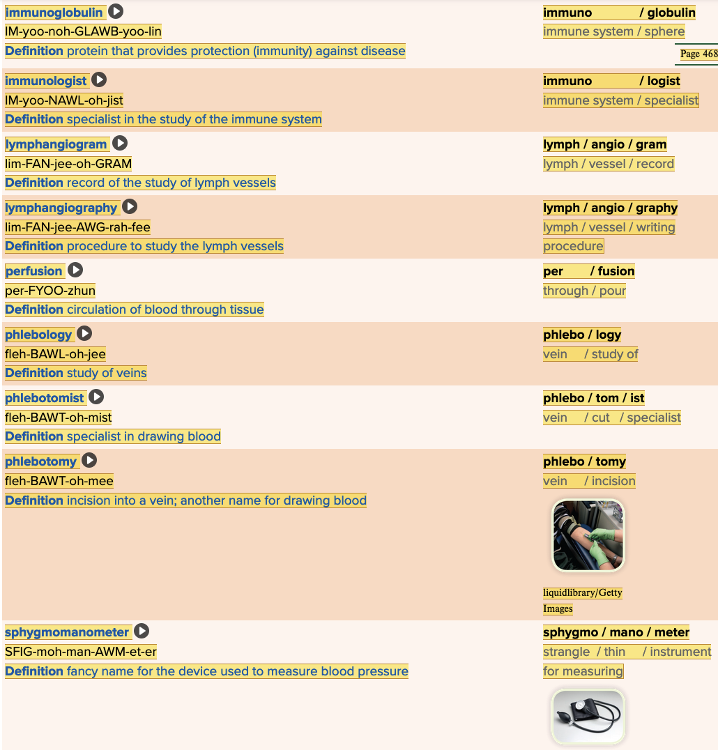
Chapter 8.3 Observation and Discovery
- Objective: Professional Terms Table Part 1
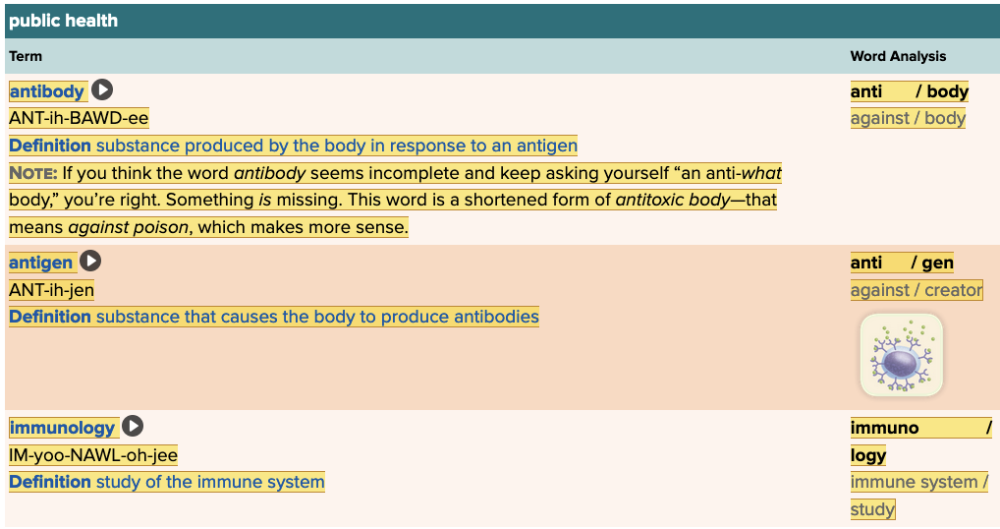
Chapter 8.3 Observation and Discovery
- Objective: Public Health Table
...
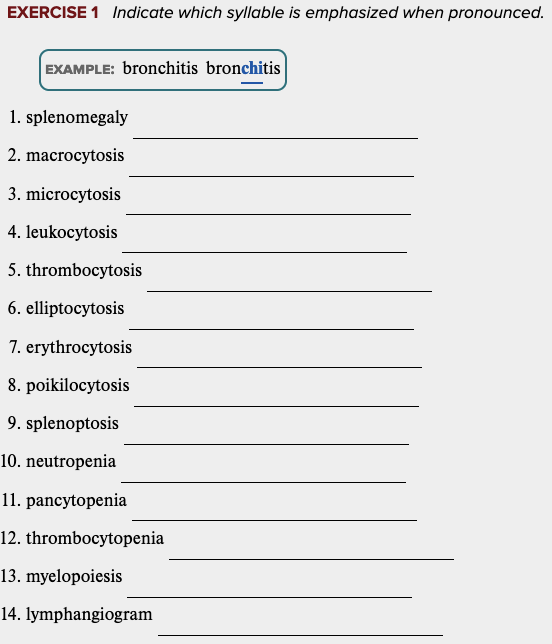
Learning Outcome 8.3 Exercises: Exercise 1.
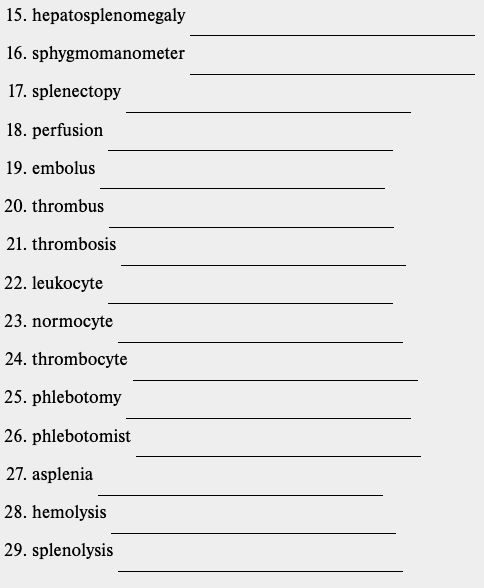
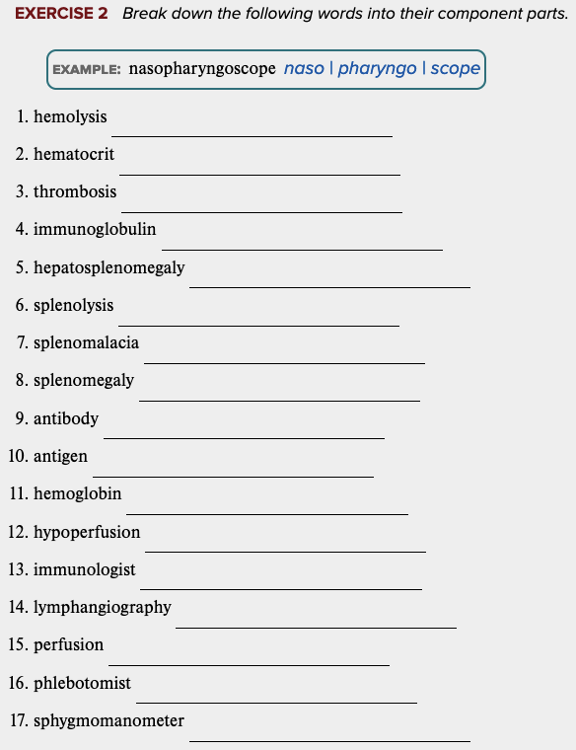
Learning Outcome 8.3 Exercises: Exercise 2.
...
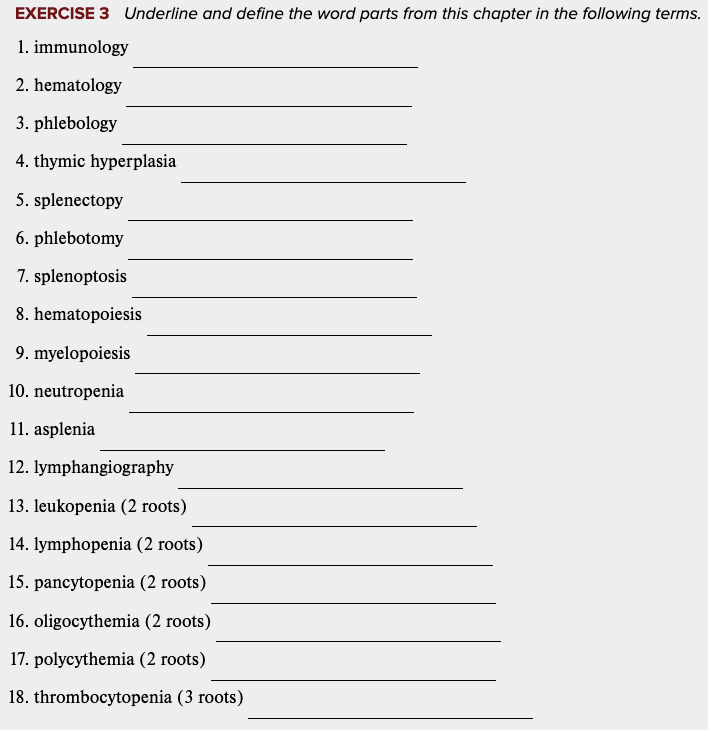
Learning Outcome 8.3 Exercises: Exercise 3.
...
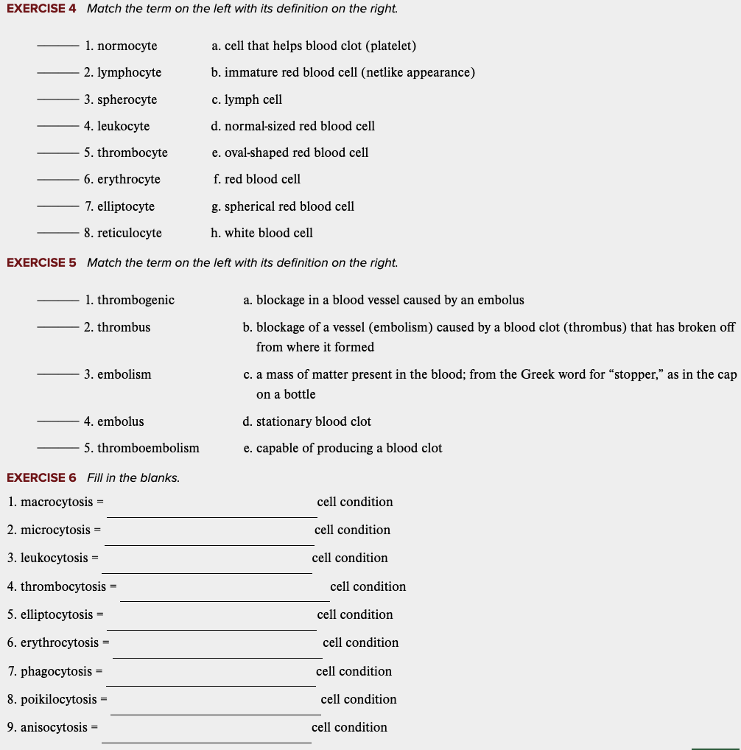
Learning Outcome 8.3 Exercises: Exercise 4, 5, 6.
...
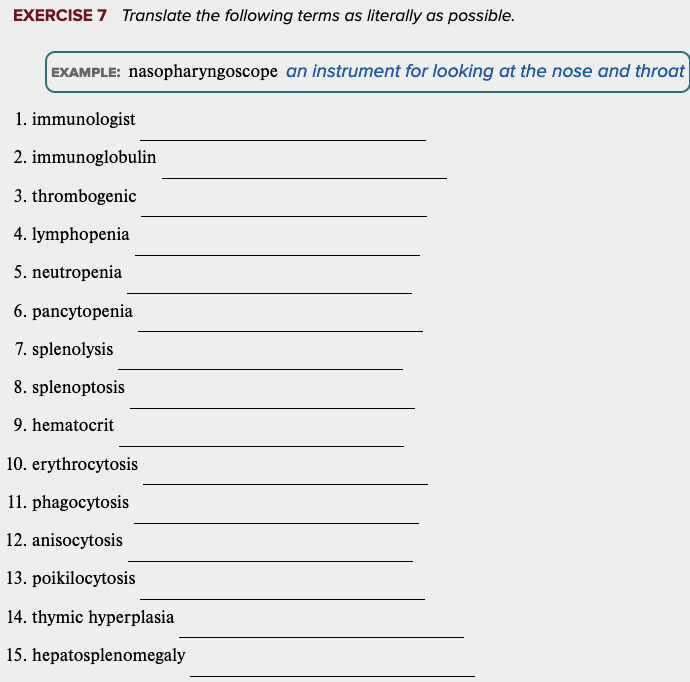
Learning Outcome 8.3 Exercises: Exercise 7.
...
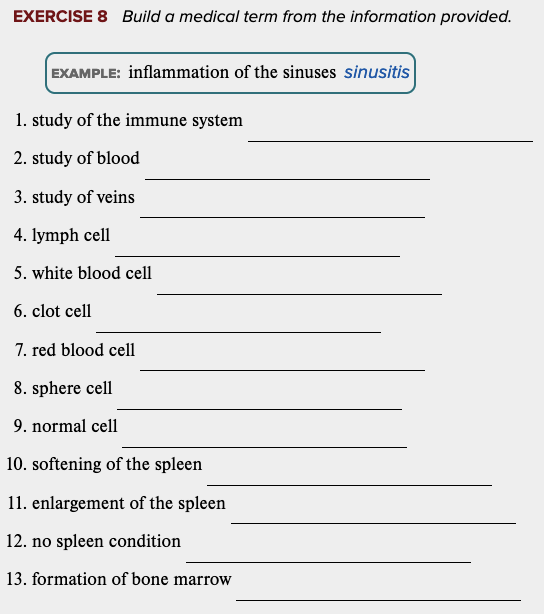
Learning Outcome 8.3 Exercises: Exercise 8.
...
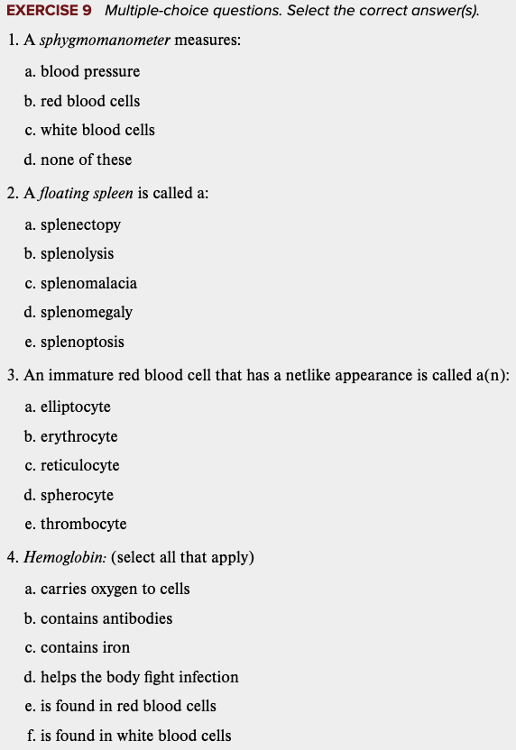
Learning Outcome 8.3 Exercises: Exercise 9.
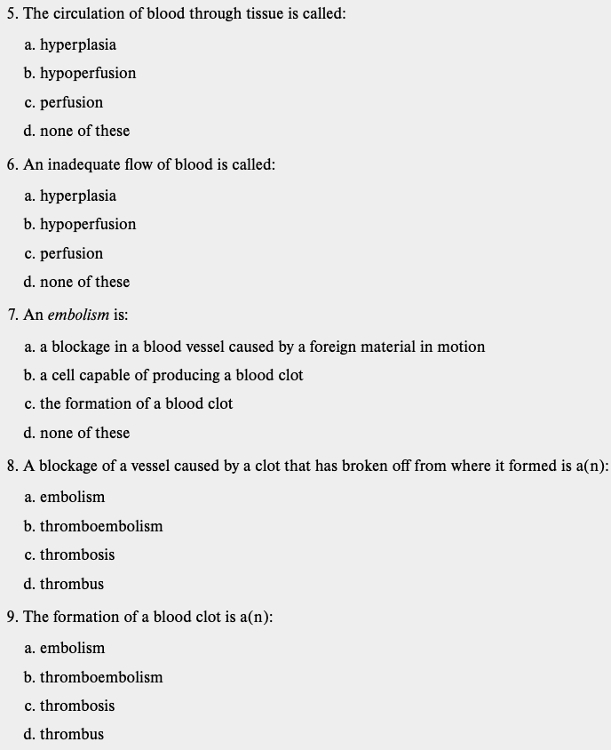
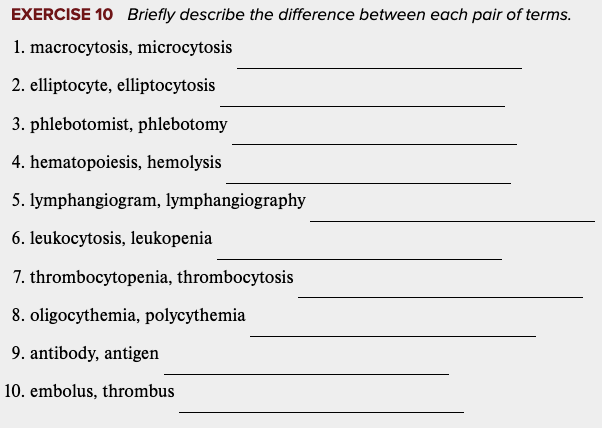
Learning Outcome 8.3 Exercises: Exercise 10.
...
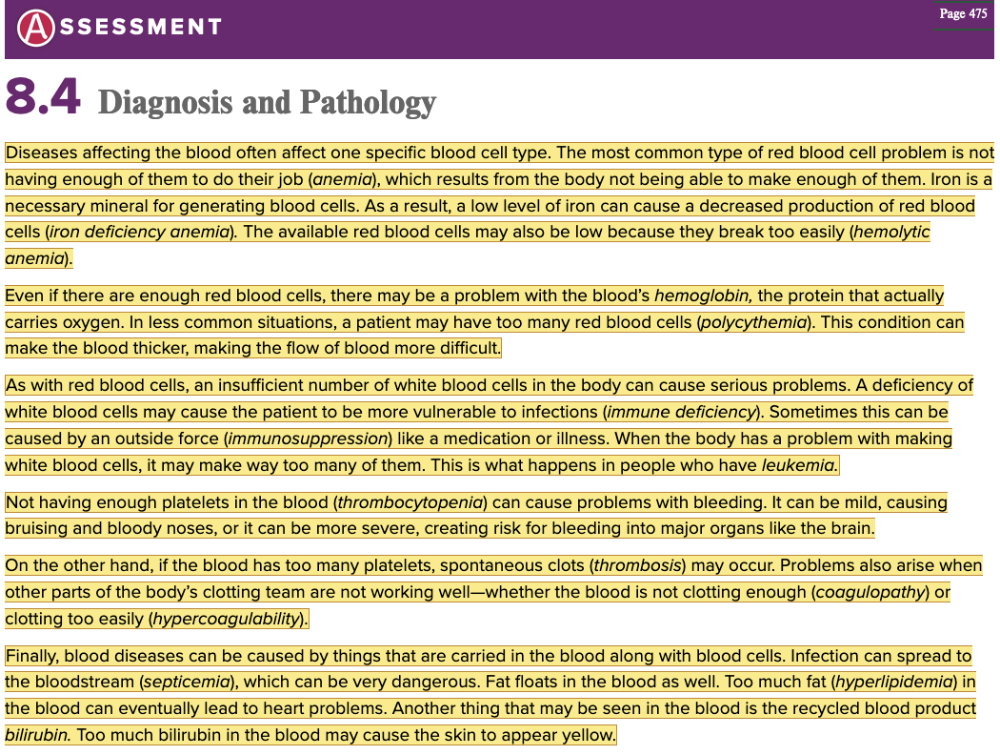
Chapter 8.4 Diagnosis and Pathology
- Assessment Part 1
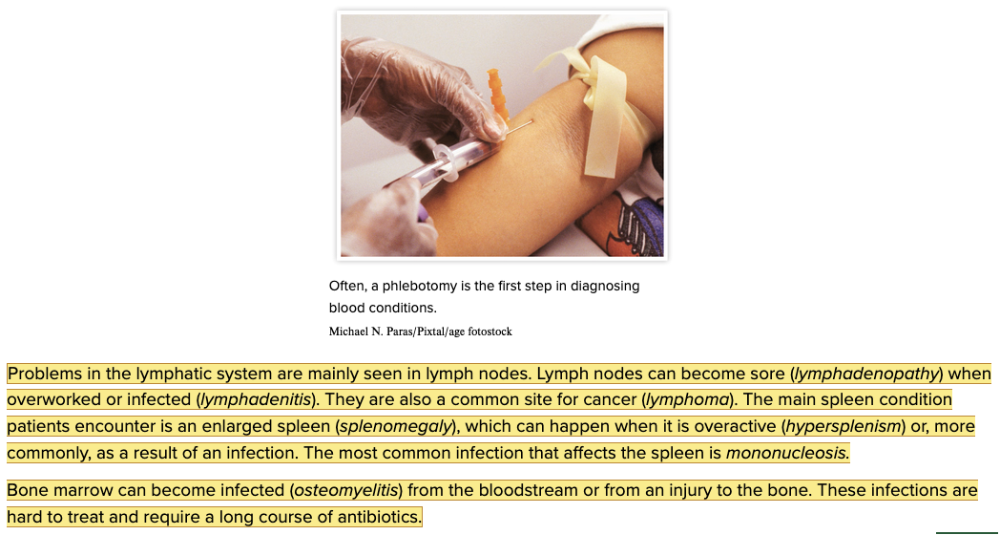
Chapter 8.4 Diagnosis and Pathology
- Assessment Part 2
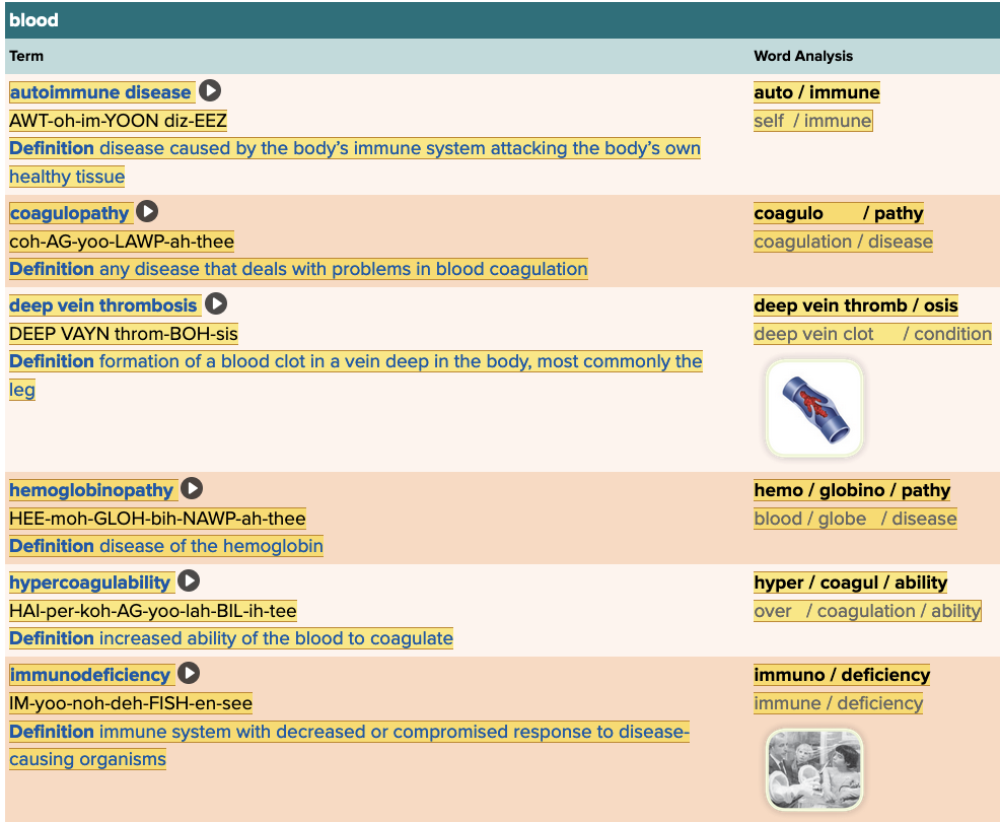
Chapter 8.4 Diagnosis and Pathology
- Assessment: Blood Table Part 1
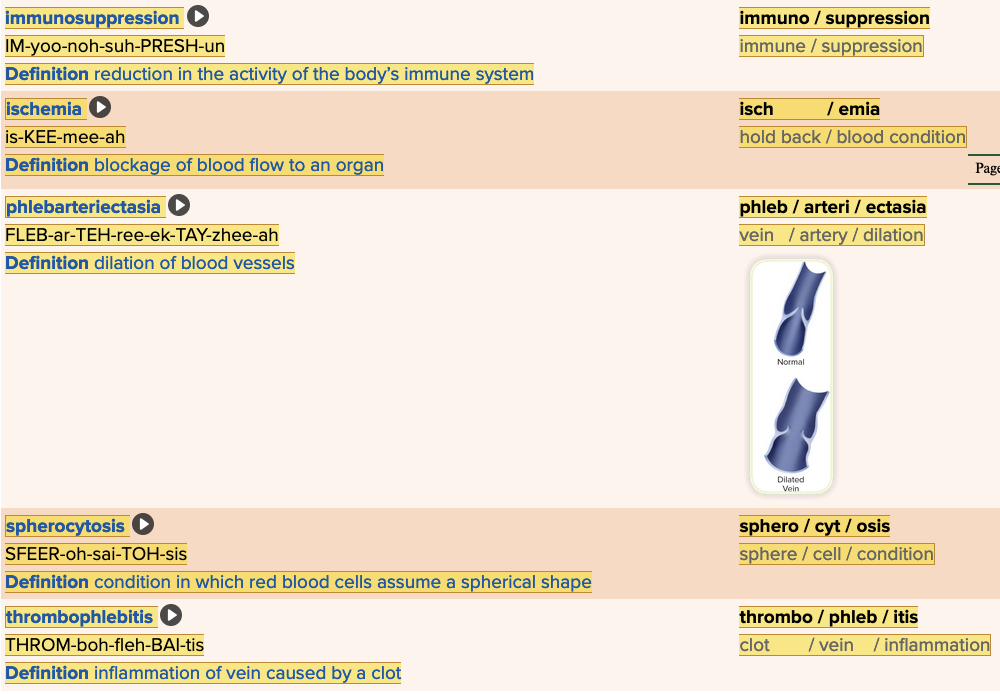
Chapter 8.4 Diagnosis and Pathology
- Assessment: Blood Table Part 2
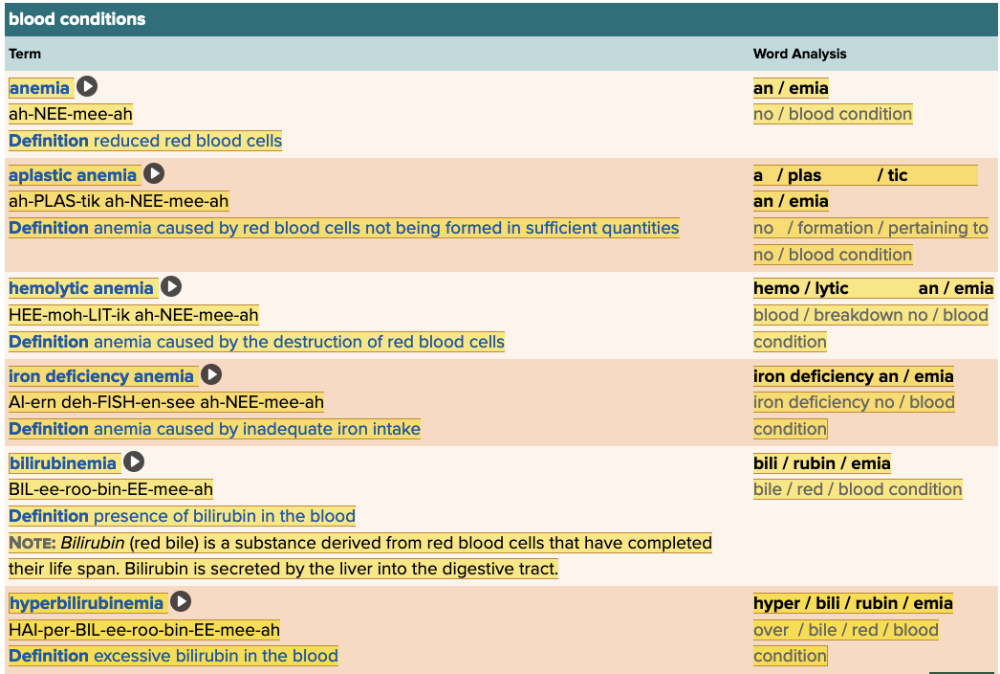
Chapter 8.4 Diagnosis and Pathology
- Assessment: Blood Conditions Table Part 1
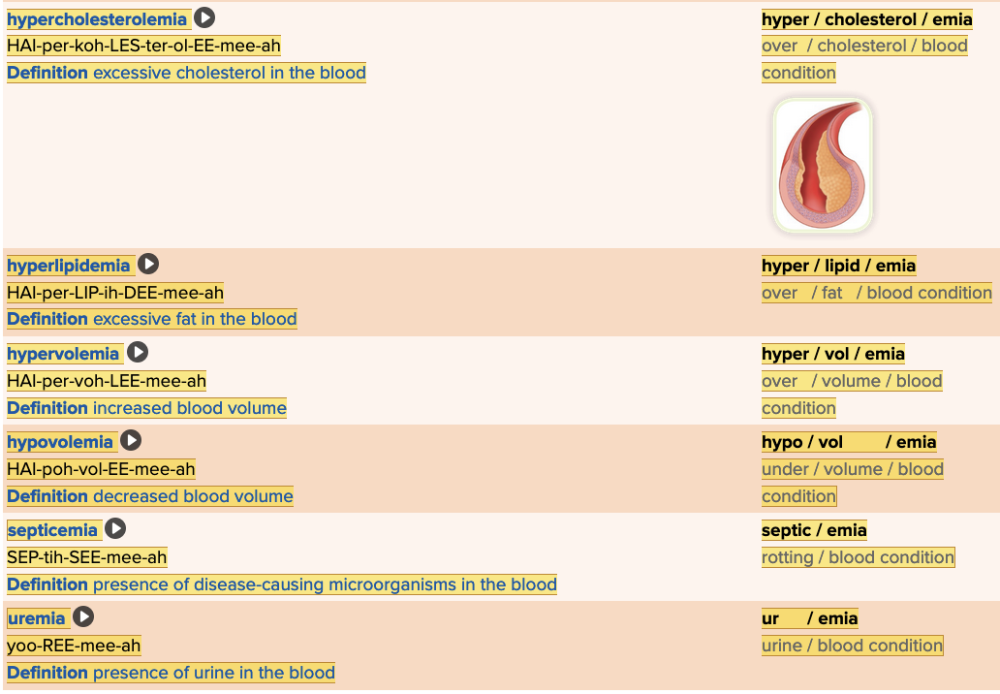
Chapter 8.4 Diagnosis and Pathology
- Assessment: Blood Conditions Table Part 2
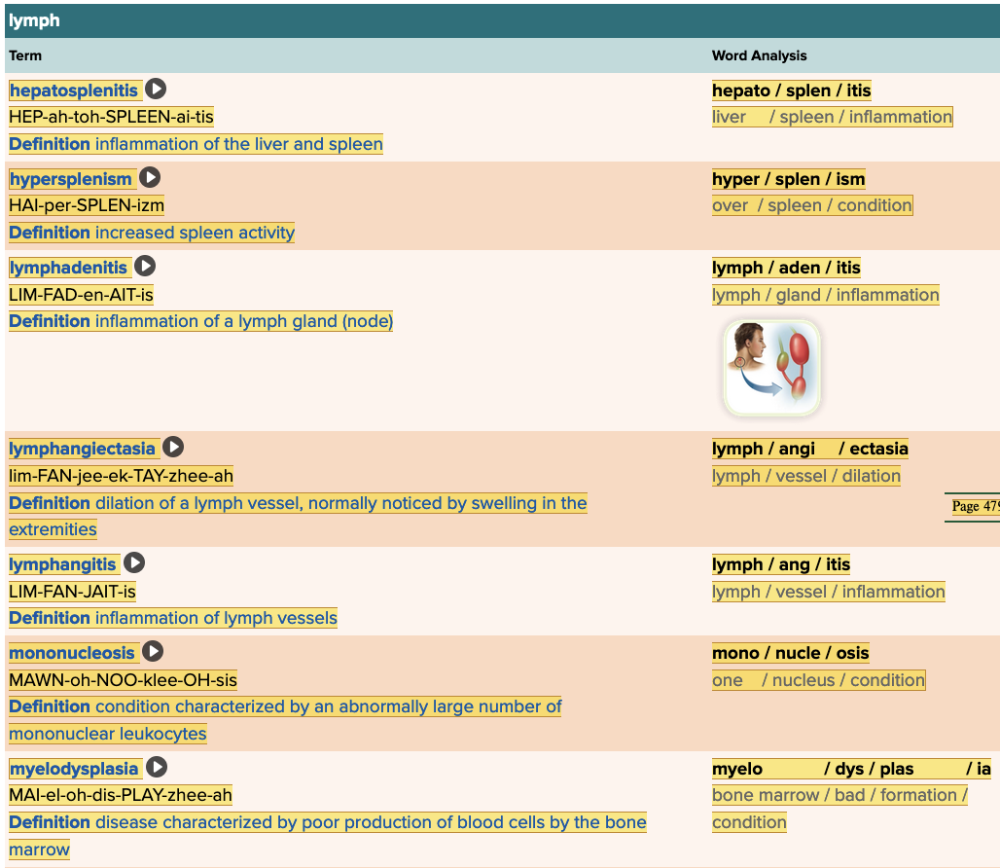
Chapter 8.4 Diagnosis and Pathology
- Assessment: Lymph Table Part 1
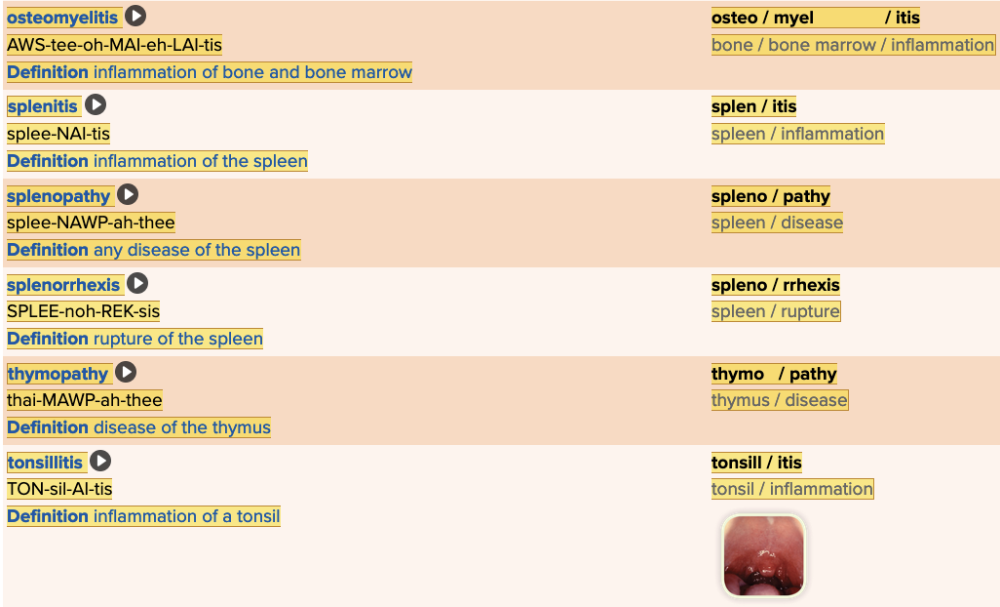
Chapter 8.4 Diagnosis and Pathology
- Assessment: Lymph Table Part 2
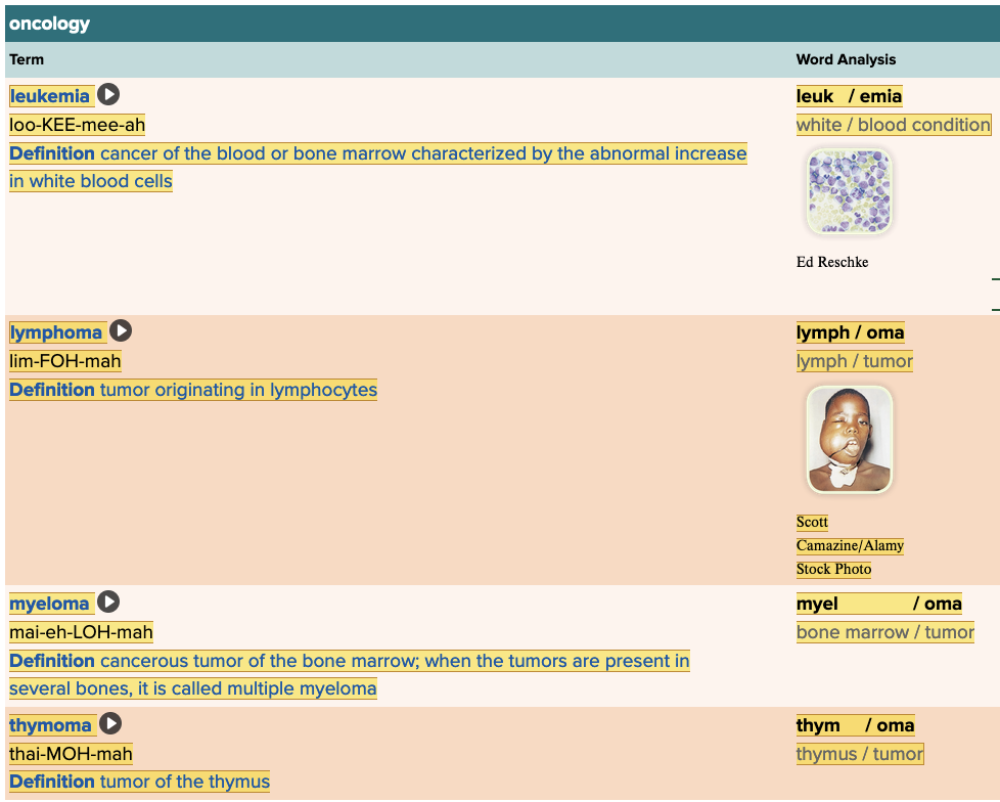
Chapter 8.4 Diagnosis and Pathology
- Assessment: Oncology Table

Chapter 8.4 Diagnosis and Pathology
- Assessment: Public Health Table
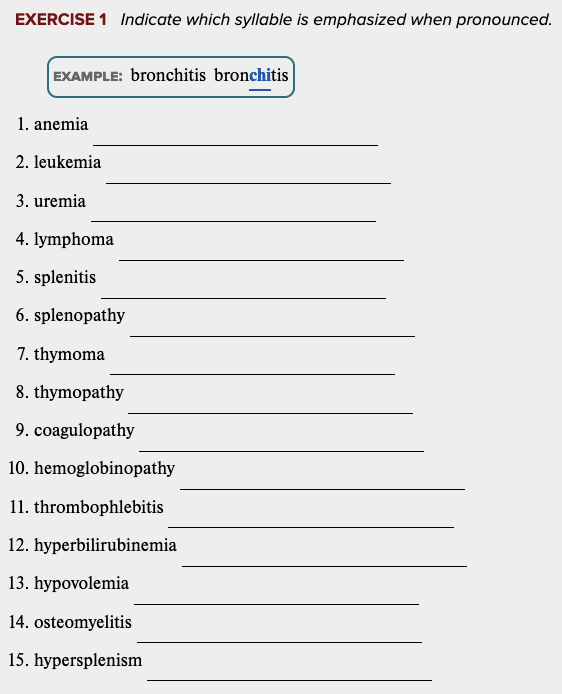
Learning Outcome 8.4 Exercises: Exercise 1.
...
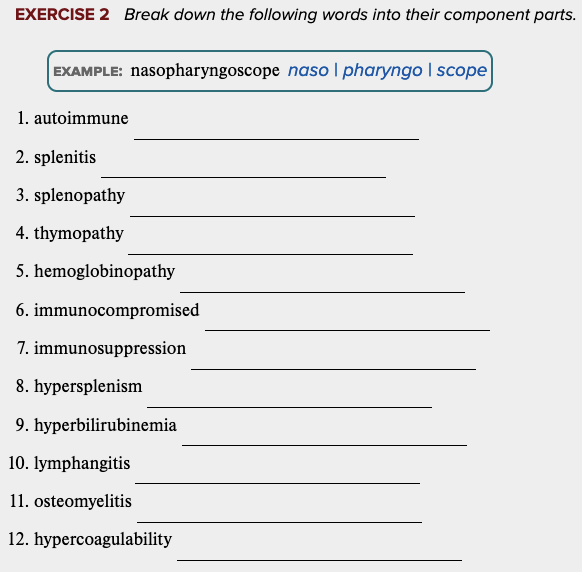
Learning Outcome 8.4 Exercises: Exercise 2.
...
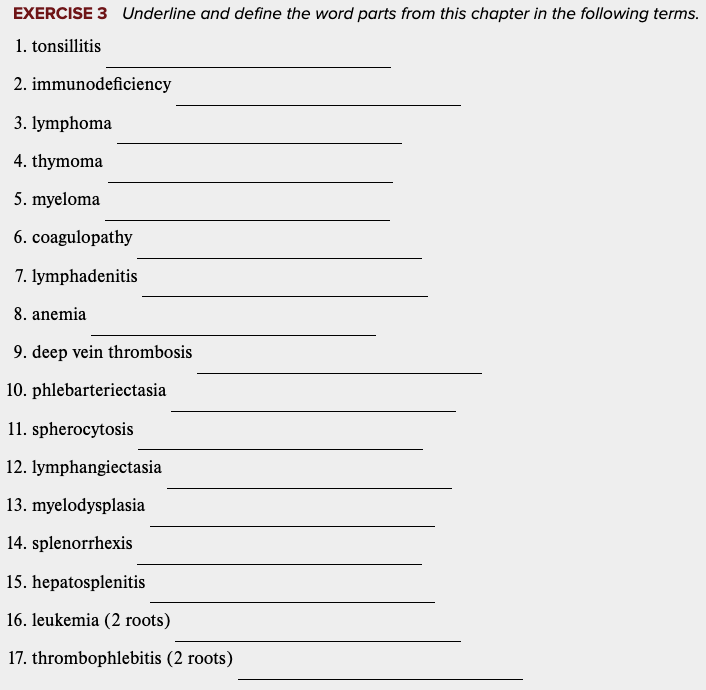
Learning Outcome 8.4 Exercises: Exercise 3.
...
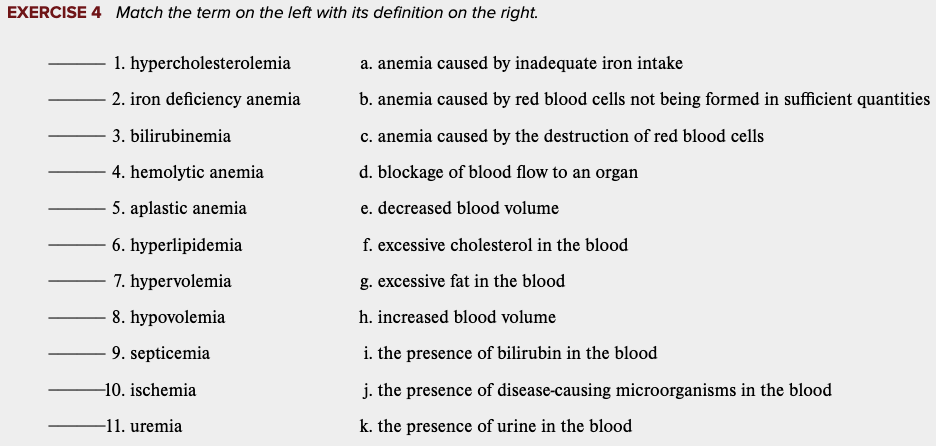
Learning Outcome 8.4 Exercises: Exercise 4.
...
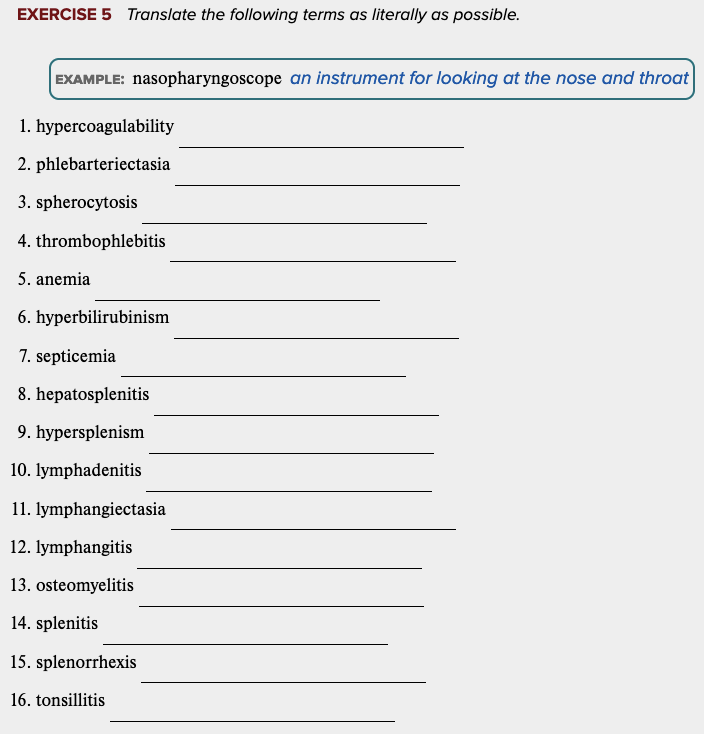
Learning Outcome 8.4 Exercises: Exercise 5.
...
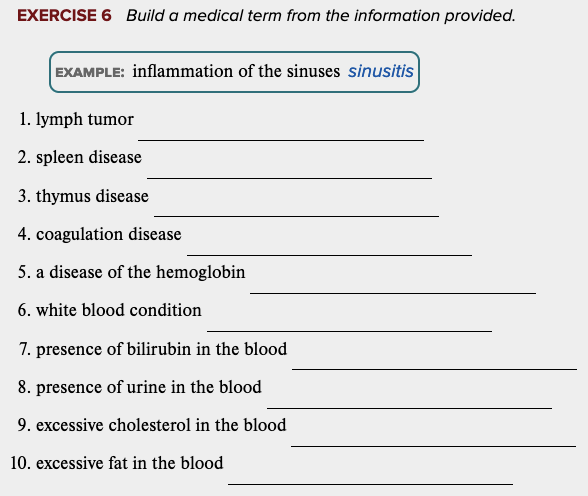
Learning Outcome 8.4 Exercises: Exercise 6.
...
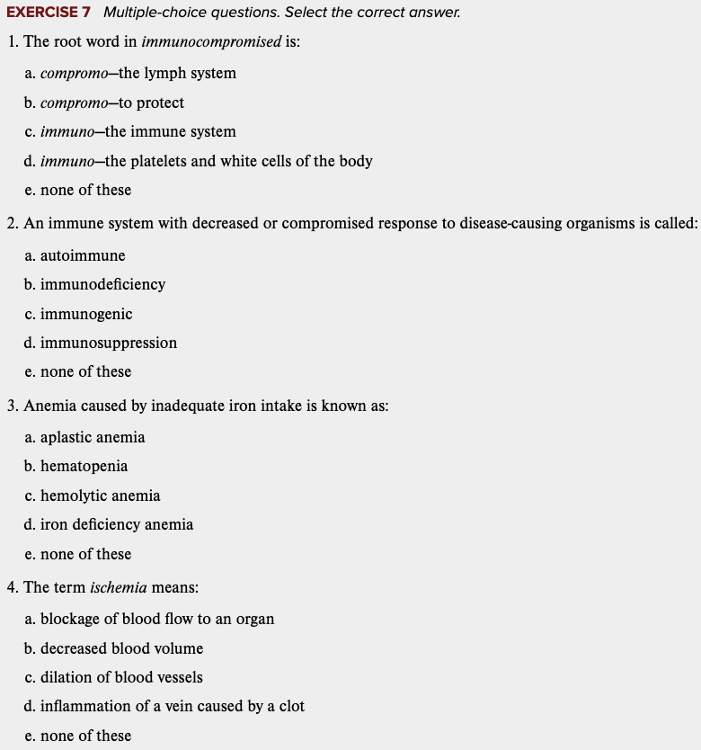
Learning Outcome 8.4 Exercises: Exercise 7.
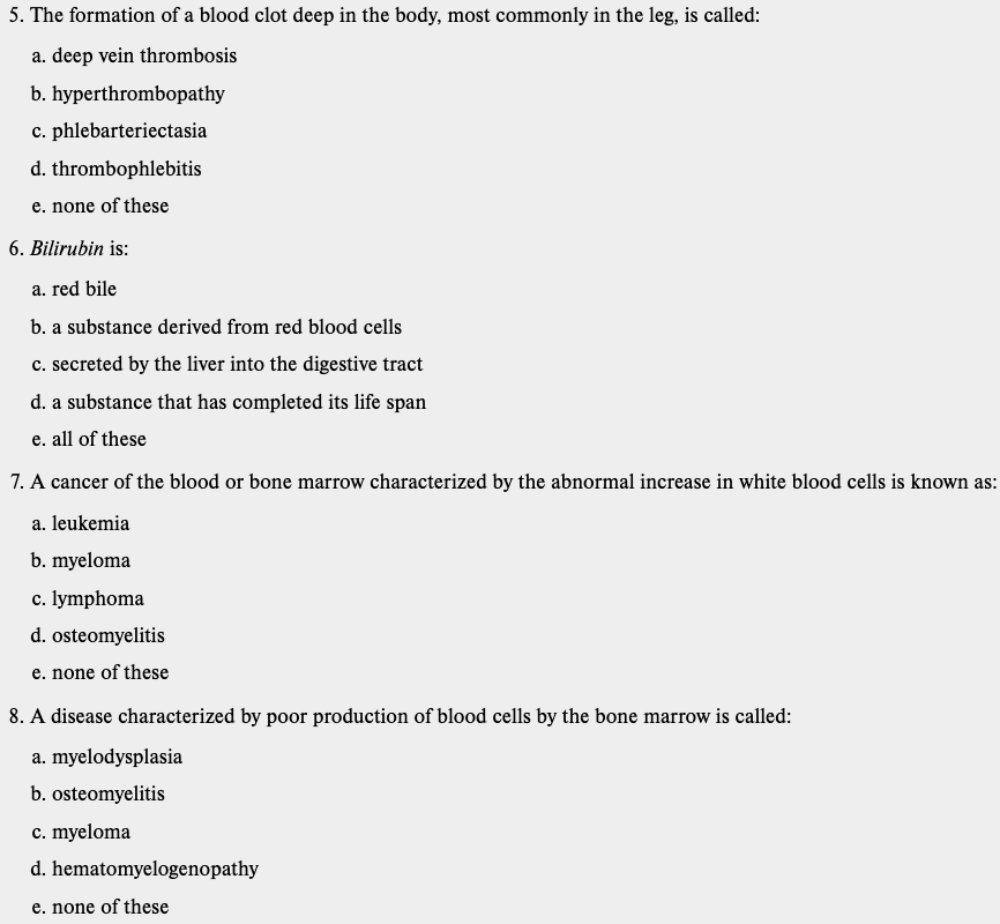

Learning Outcome 8.4 Exercises: Exercise 8.
...
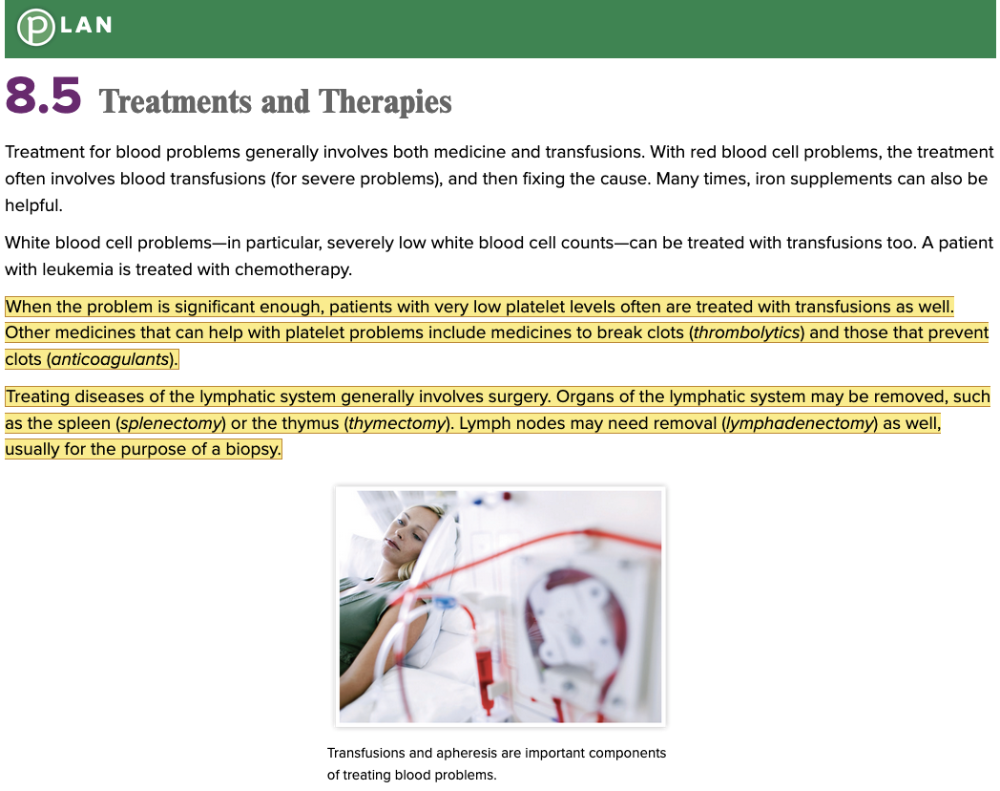
Chapter 8.5 Treatments and Therapies
- Plan
...
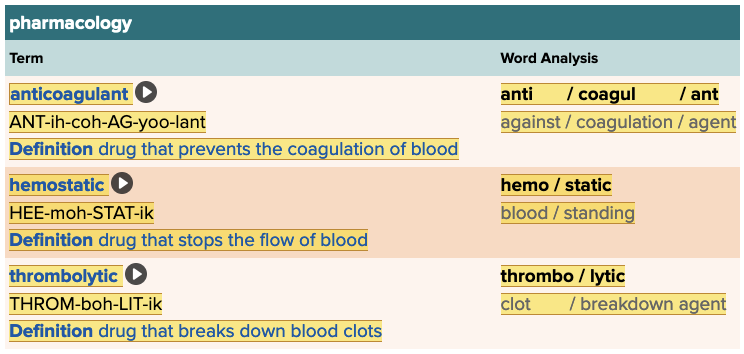
Chapter 8.5 Treatments and Therapies
- Plan: Pharmacology Table
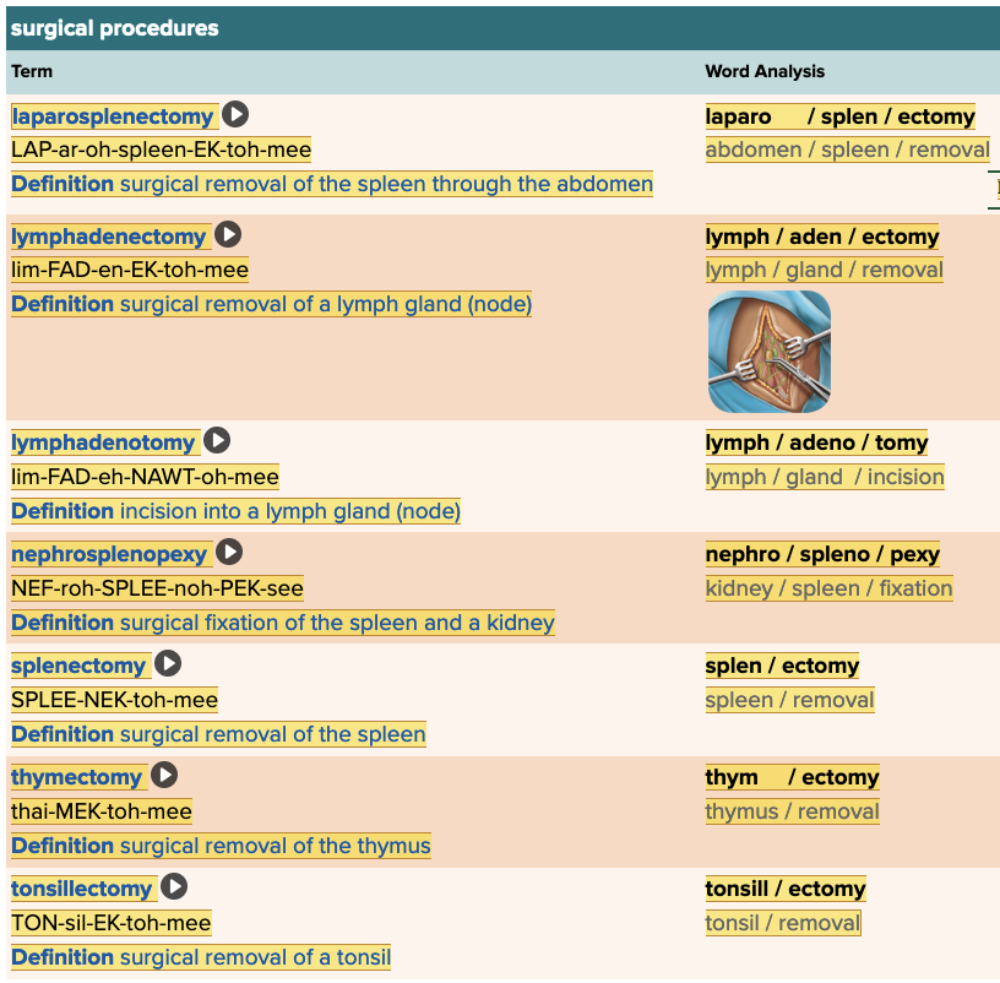
Chapter 8.5 Treatments and Therapies
- Plan: Surgical Procedures Table
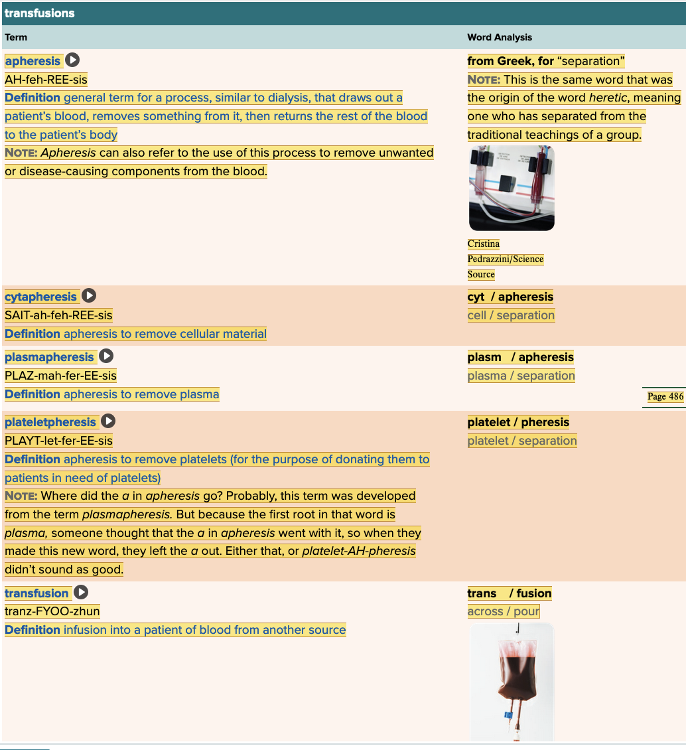
Chapter 8.5 Treatments and Therapies
- Plan: Transfusions Table
...
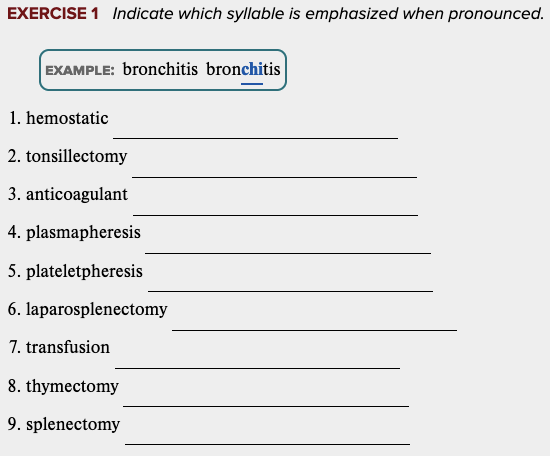
Learning Outcome 8.5 Exercises: Exercise 1.
...
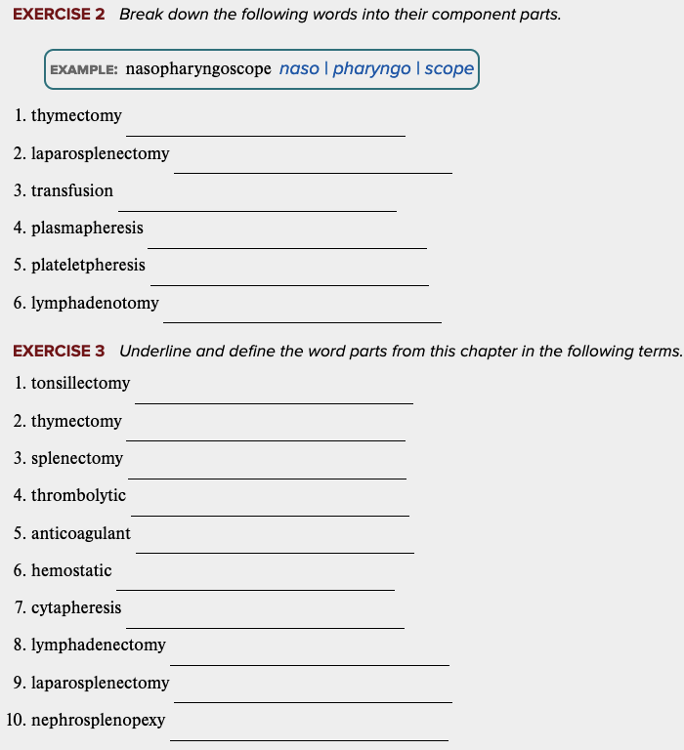
Learning Outcome 8.5 Exercises: Exercise 2, 3.
...
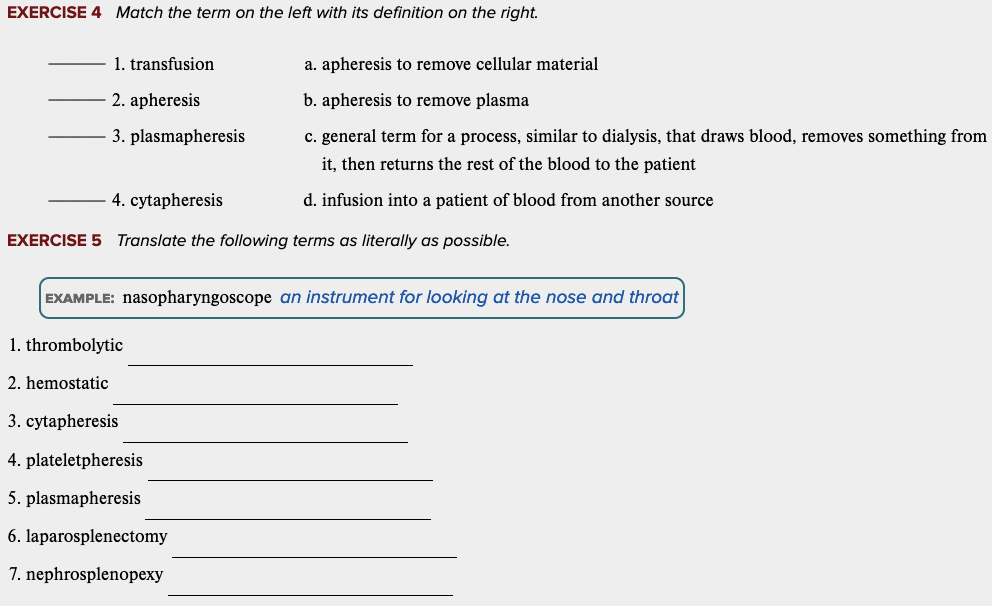
Learning Outcome 8.5 Exercises: Exercise 4, 5.
...
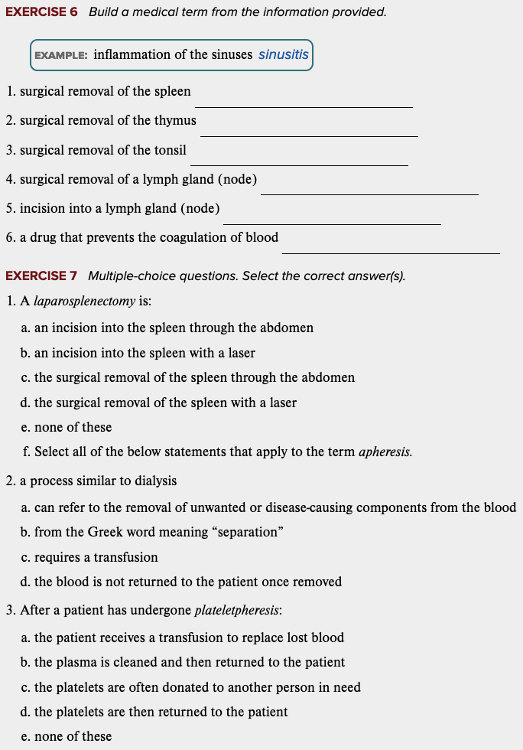
Learning Outcome 8.5 Exercises: Exercise 6, 7.
...

Chapter 8.6 Abbreviations
...
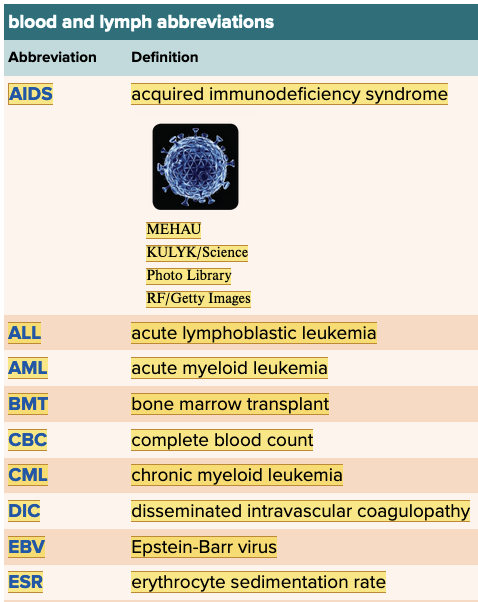
Chapter 8.6 Abbreviations
- Blood and Lymph Abbreviations Table Part 1
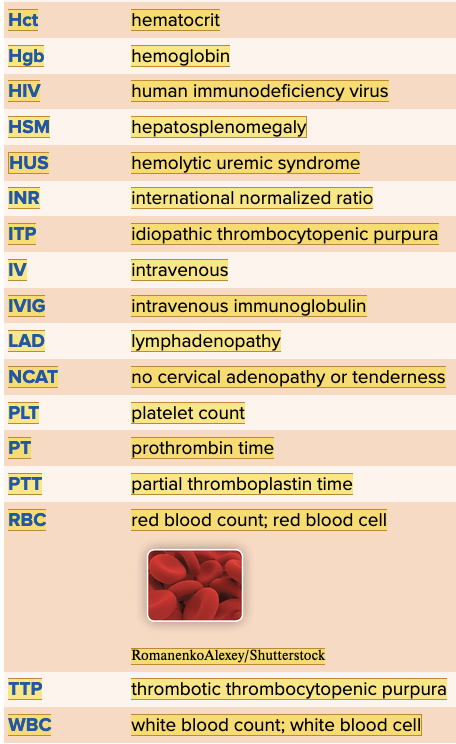
Chapter 8.6 Abbreviations
- Blood and Lymph Abbreviations Table Part 2
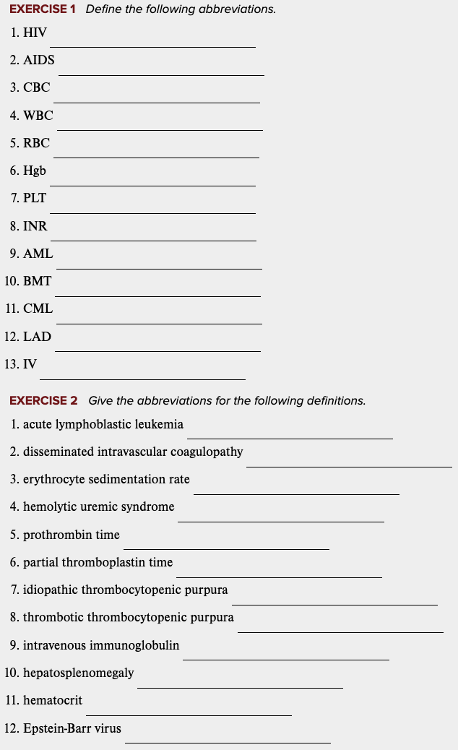
Learning Outcome 8.6 Exercises: Exercise 1, 2.
...
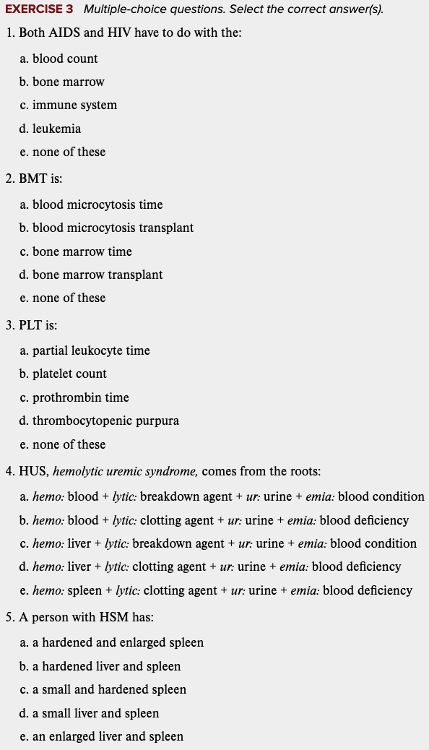
Learning Outcome 8.6 Exercises: Exercise 3.
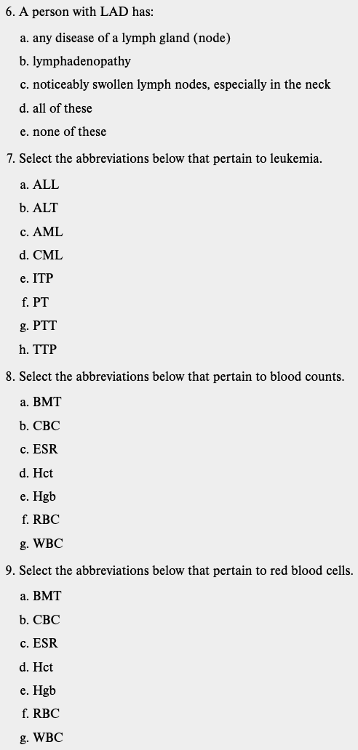
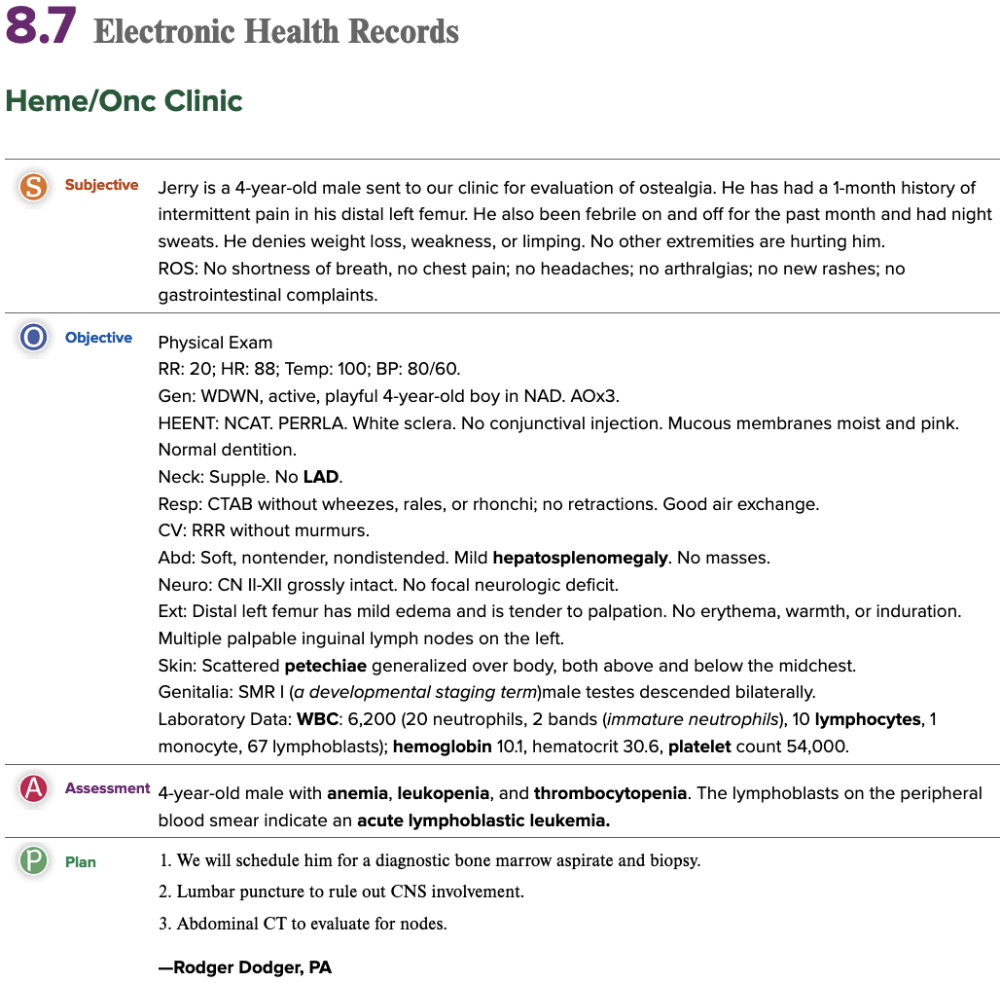
Chapter 8.7 Electronic Health Records
Heme/Onc Clinic
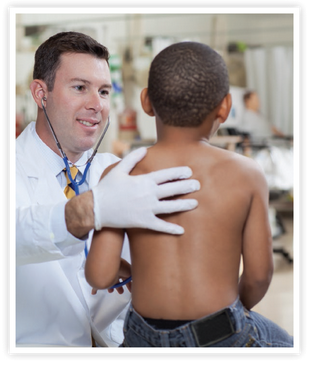
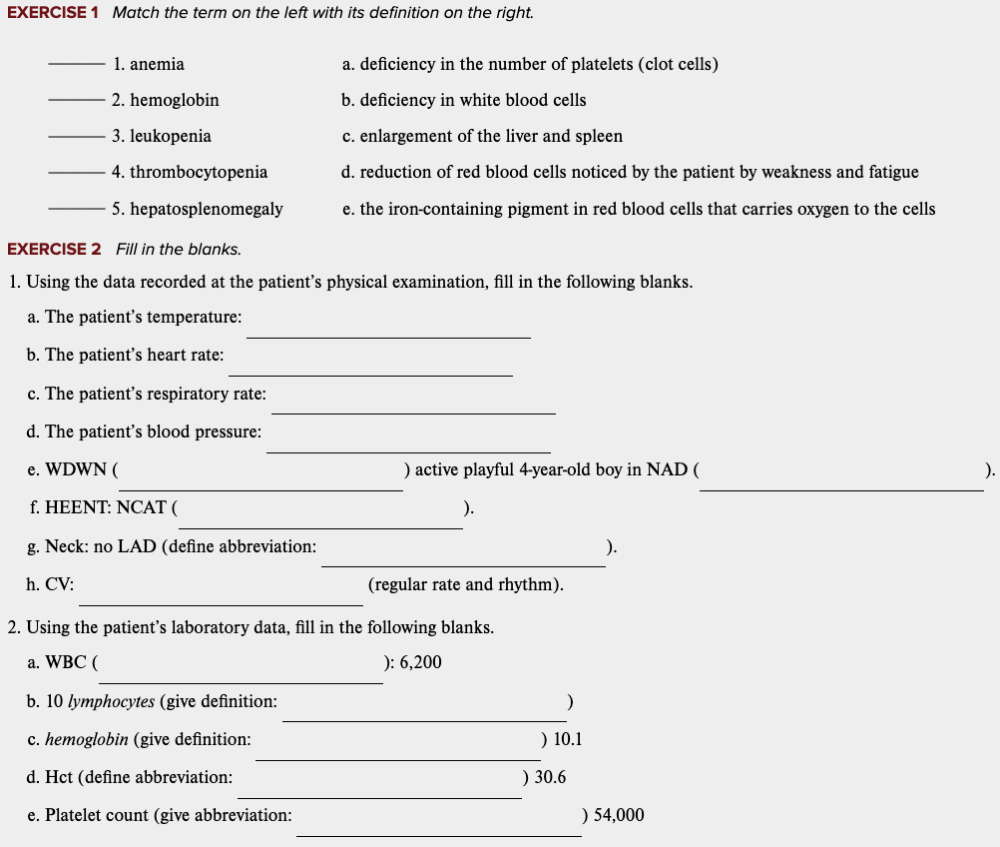
Learning Outcome 8.7 Exercises: Exercise 1, 2.
...
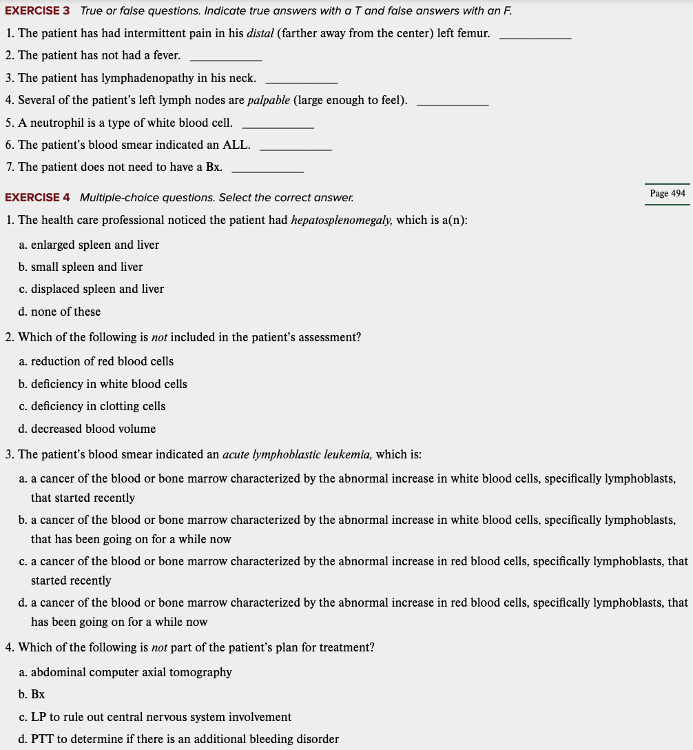
Learning Outcome 8.7 Exercises: Exercise 3, 4.
...
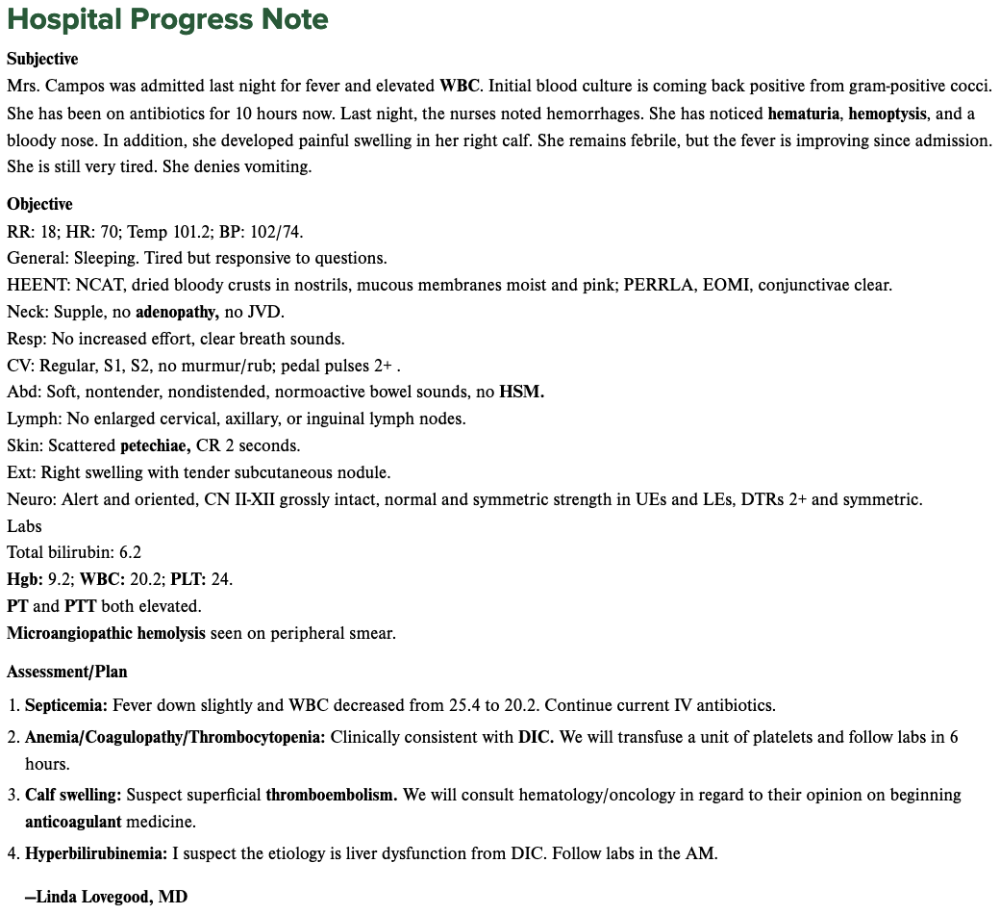
Chapter 8.7 Electronic Health Records
Hospital Progress Note
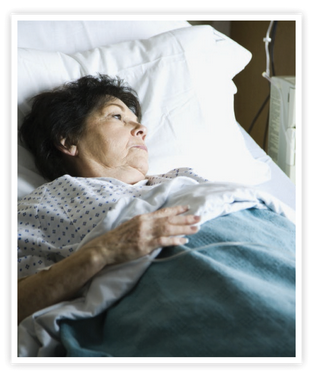
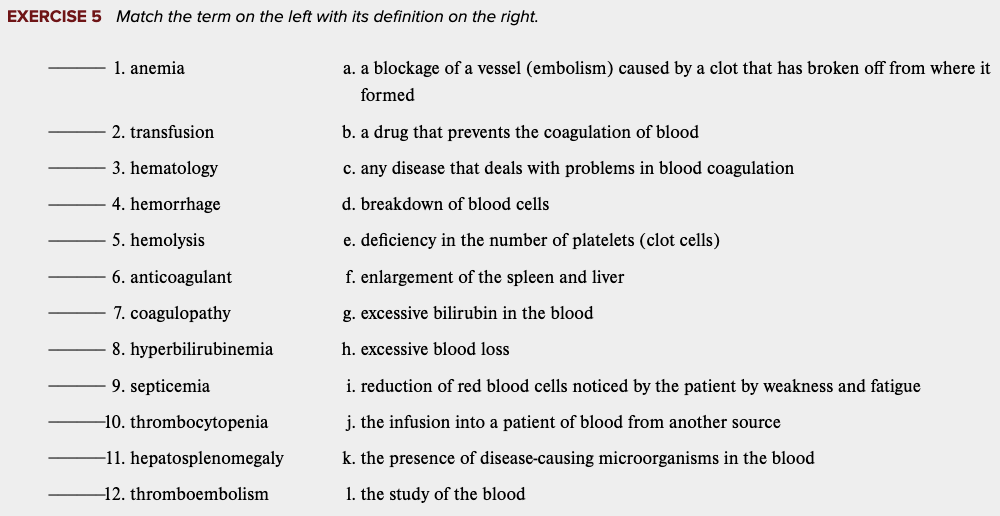
Learning Outcome 8.7 Exercises: Exercise 5.
...
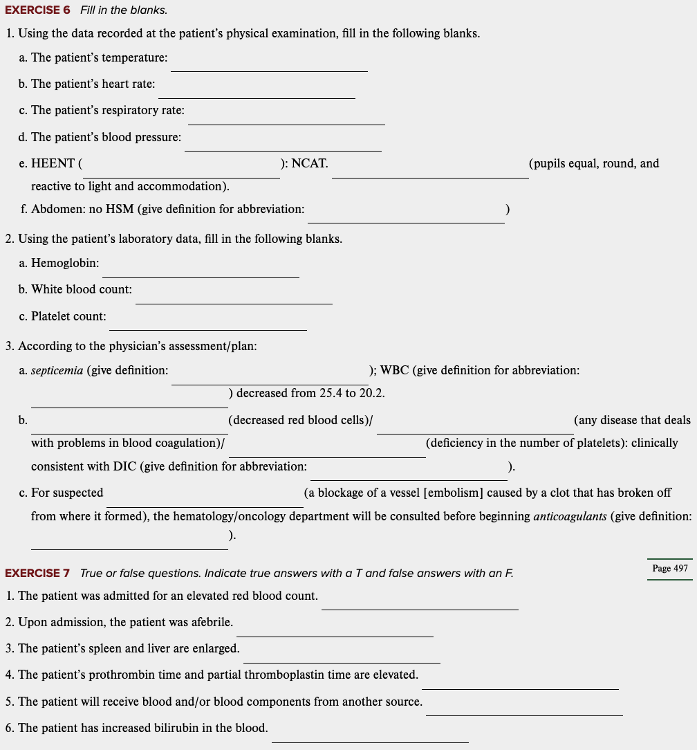
Learning Outcome 8.7 Exercises: Exercise 6, 7.
...
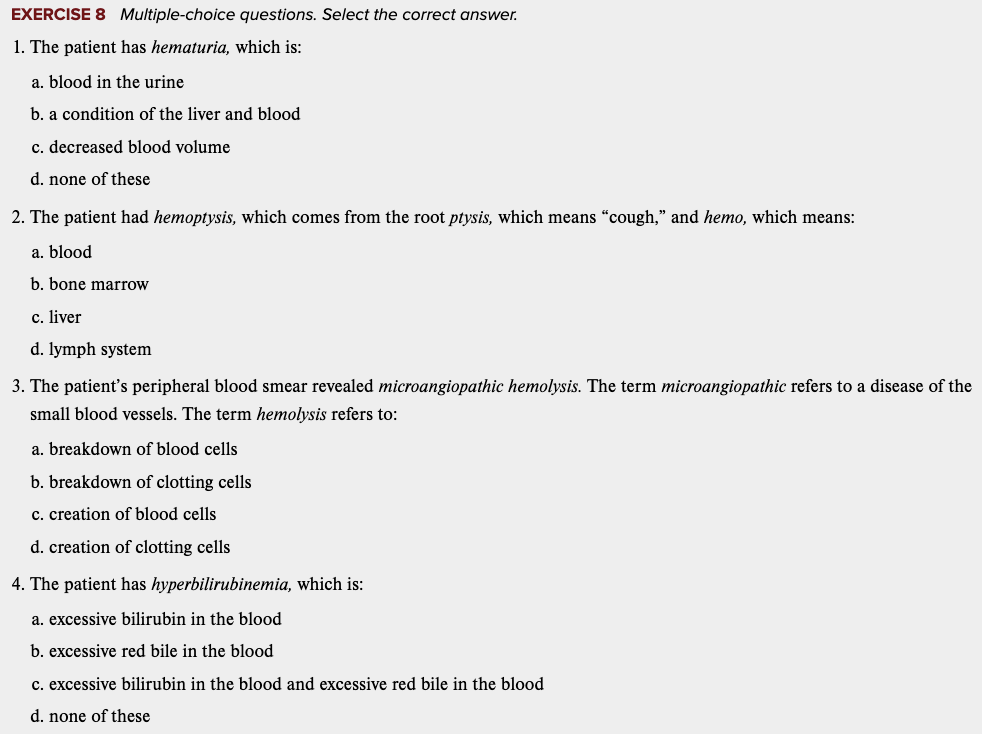
Learning Outcome 8.7 Exercises: Exercise 8.
...
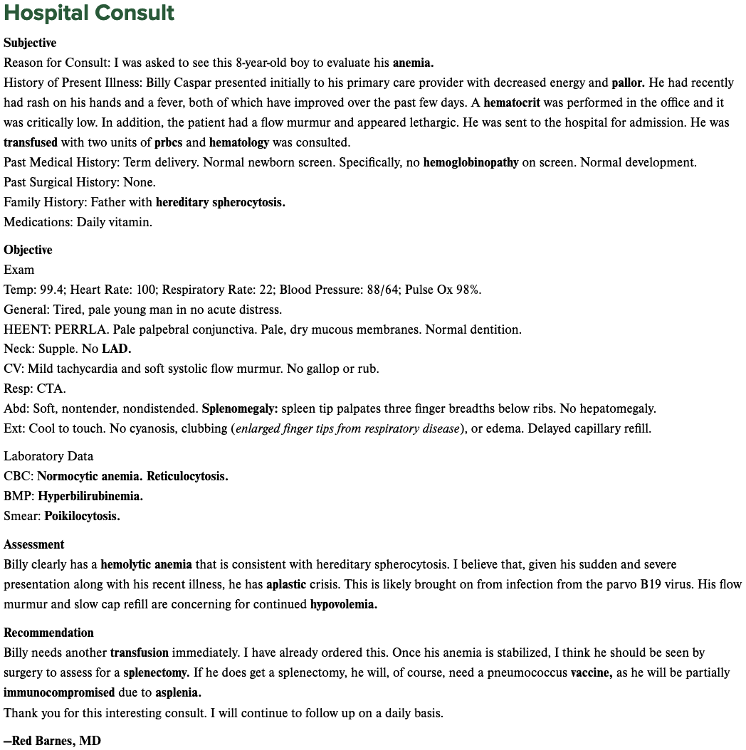
Chapter 8.7 Electronic Health Records
Hospital Consult
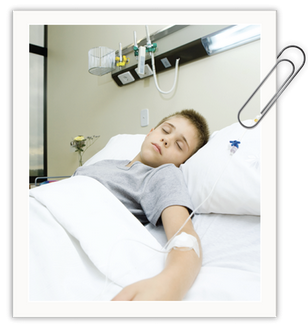
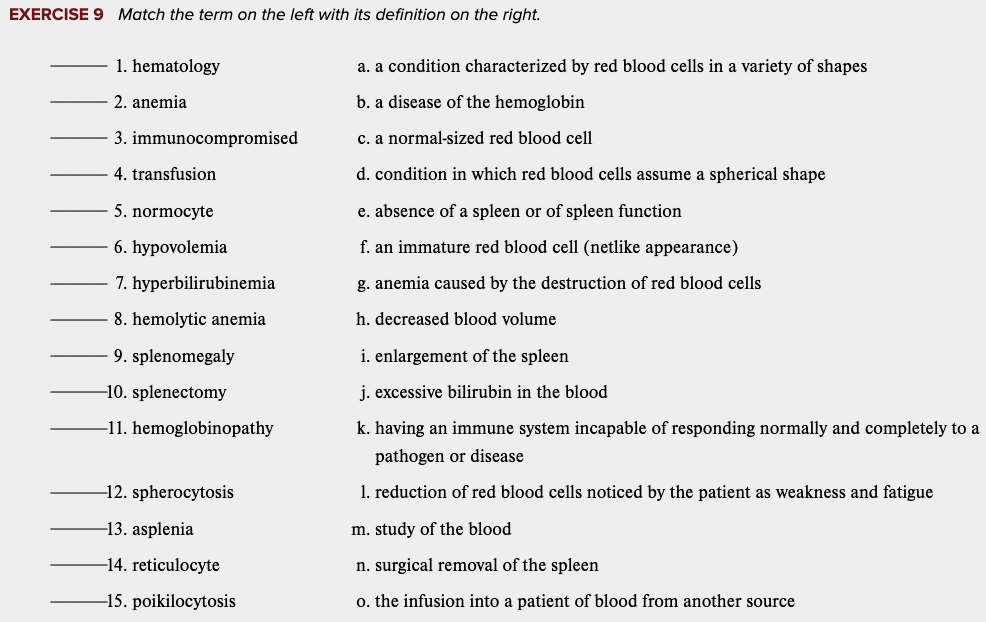
Learning Outcome 8.7 Exercises: Exercise 9.
...
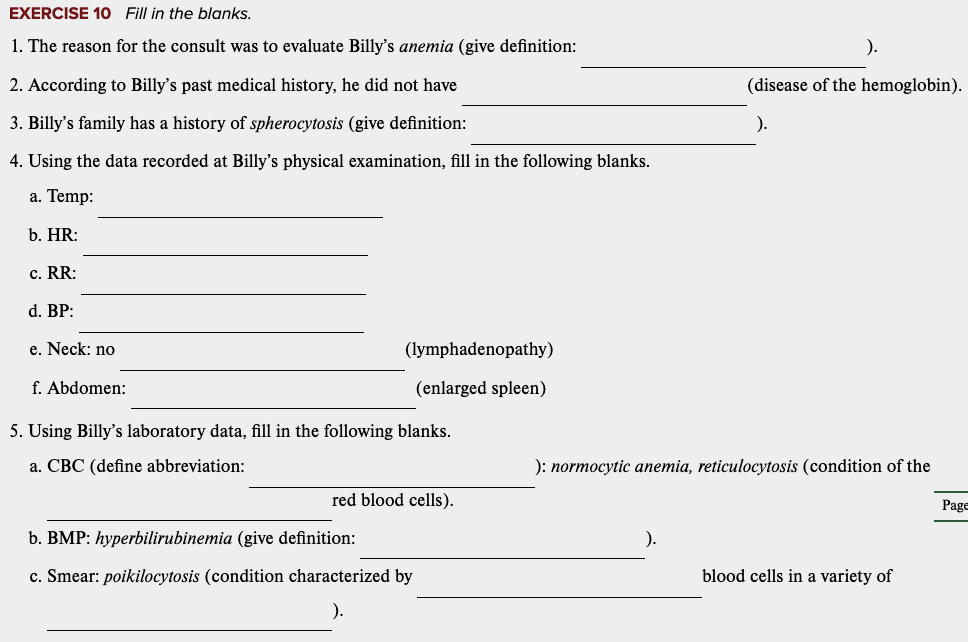
Learning Outcome 8.7 Exercises: Exercise 10.
...
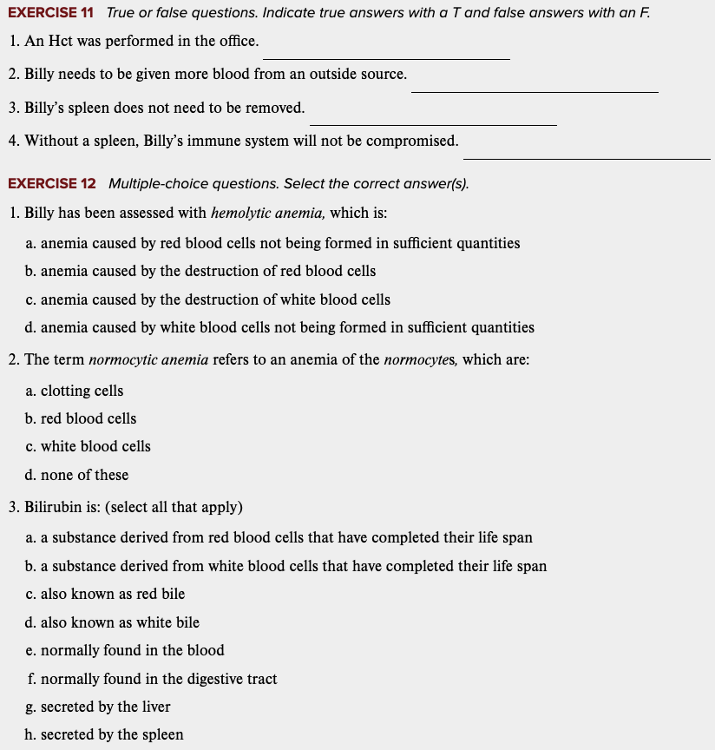
Learning Outcome 8.7 Exercises: Exercise 11, 12.
...
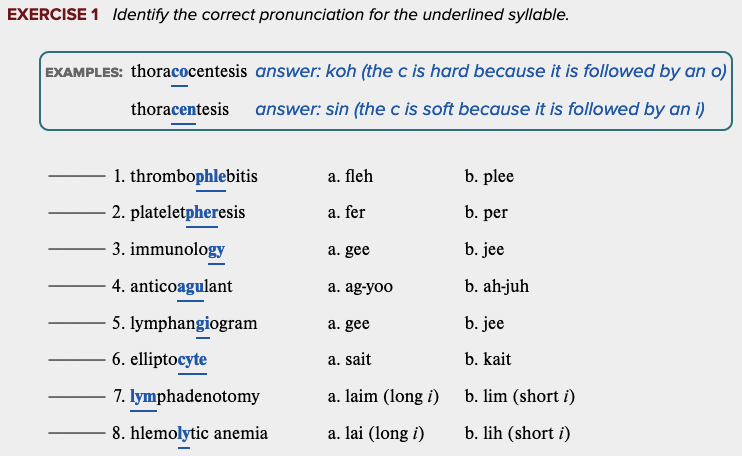
Chapter 8 Review Exercises: Exercise 1.
...
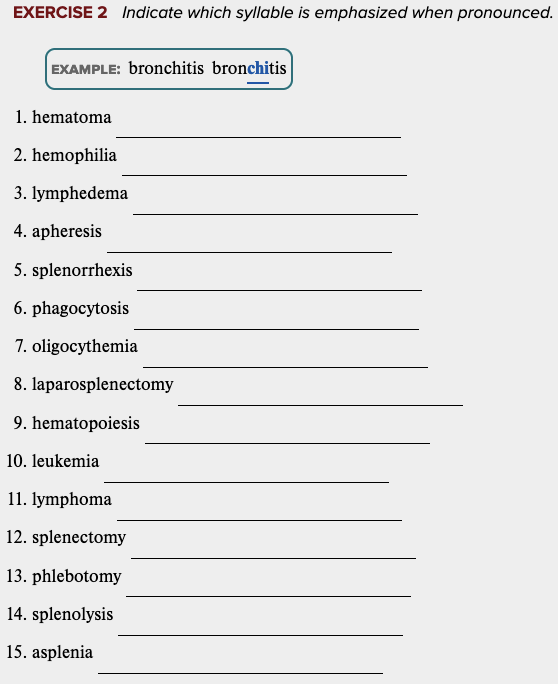
Chapter 8 Review Exercises: Exercise 2.
...
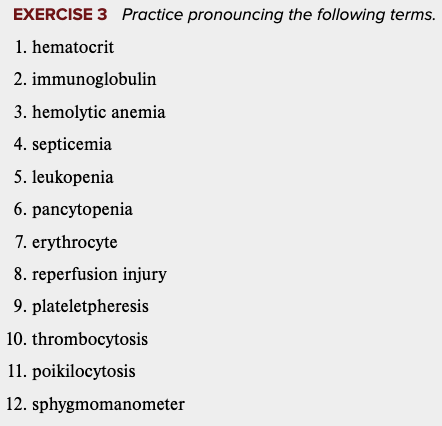
Chapter 8 Review Exercises: Exercise 3.
...
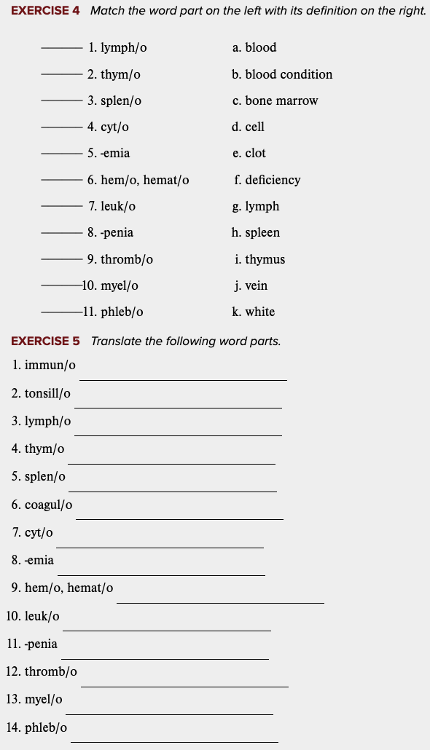
Chapter 8 Review Exercises: Exercise 4, 5.
...

Chapter 8 Review Exercises: Exercise 6.
...
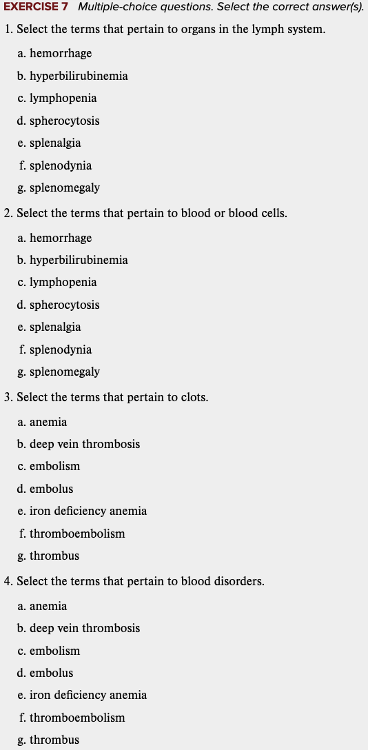
Chapter 8 Review Exercises: Exercise 7.
...
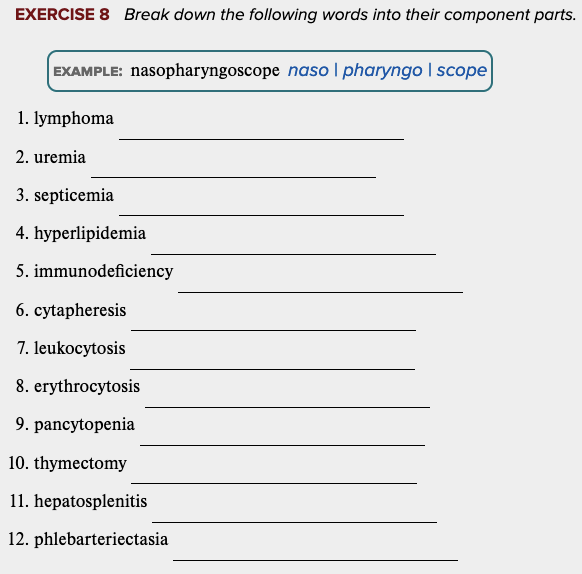
Chapter 8 Review Exercises: Exercise 8.
...
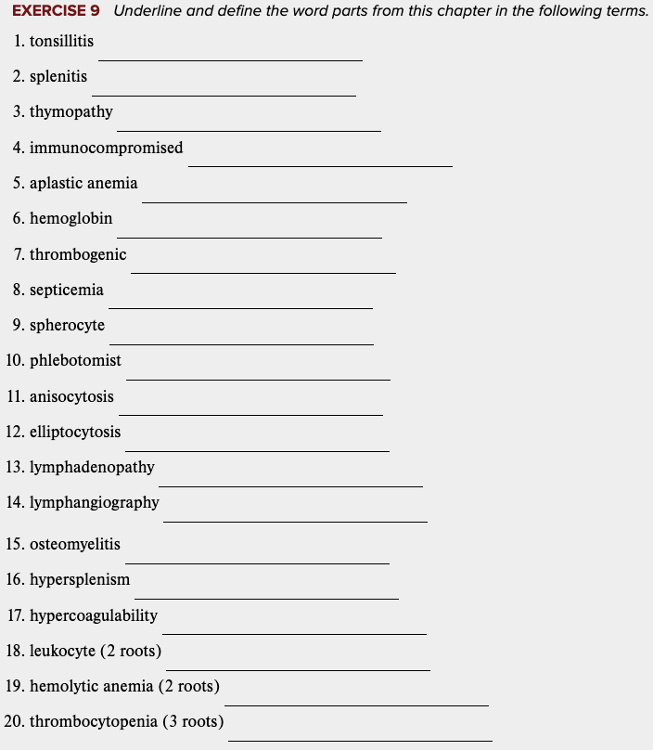
Chapter 8 Review Exercises: Exercise 9.
...
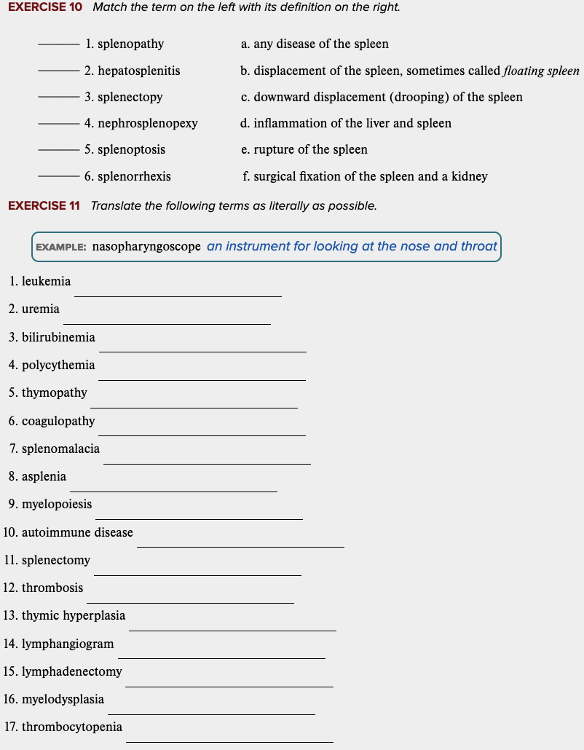
Chapter 8 Review Exercises: Exercise 10, 11.
...
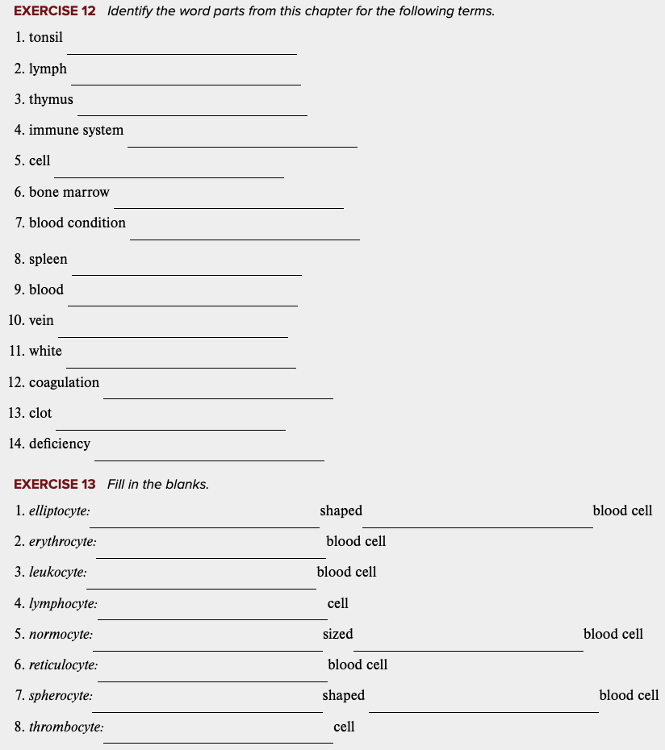
Chapter 8 Review Exercises: Exercise 12, 13.
...
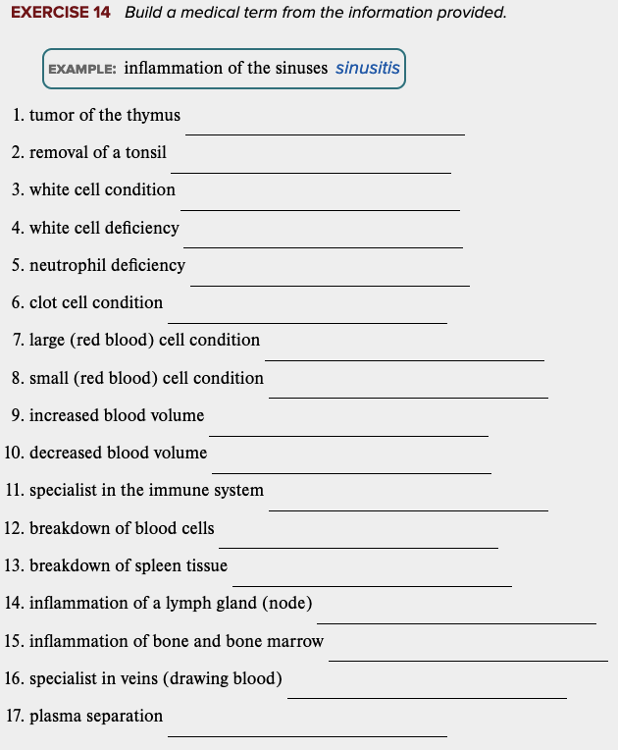
Chapter 8 Review Exercises: Exercise 14.
...
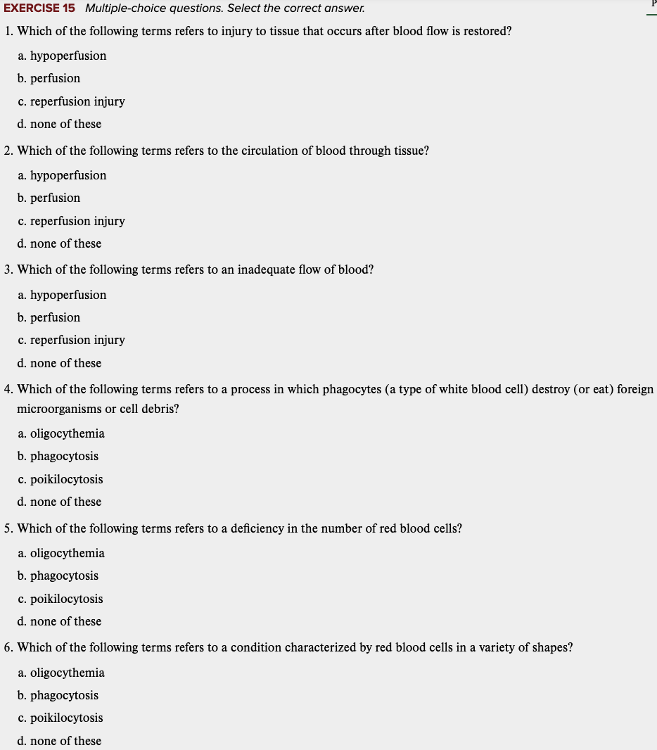
Chapter 8 Review Exercises: Exercise 15.
...
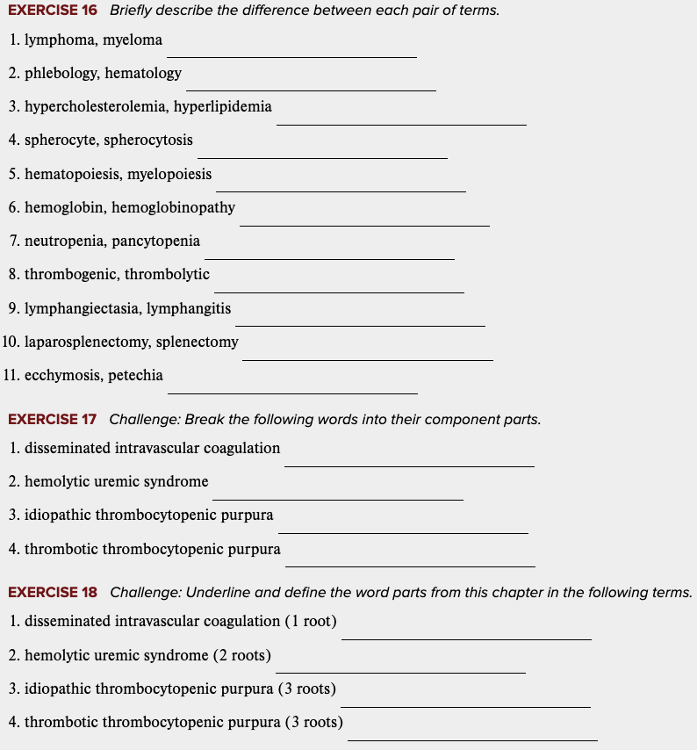
Chapter 8 Review Exercises: Exercise 16, 17, 18.
...
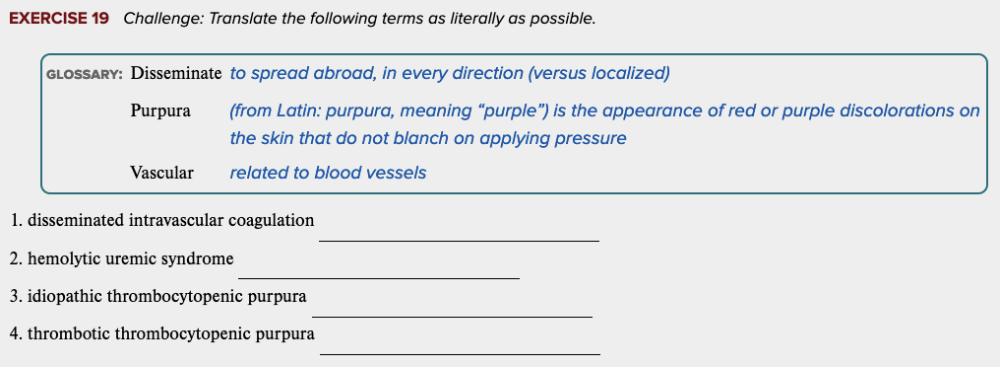
Chapter 8 Review Exercises: Exercise 19.
...
Select all that apply
Blood cells that patch up broken blood vessels are ______.
Multiple select question.
- platelets
- erythrocytes
- leukocytes
- thrombocytes
- platelets
- thrombocytes
The root hemo/hemato means ______.
Multiple choice question.
- cell
- platelet
- blood
- erythrocyte
blood
The type of blood cells in the body that include basophils, eosinophils, and neutrophils are ______ blood cells.
white or granular
When a blood vessel is injured, it attracts ______ that clump together to form a sticky patch.
platelets or thrombocytes
The root in the term anticoagulant means ______.
coagulation or clot
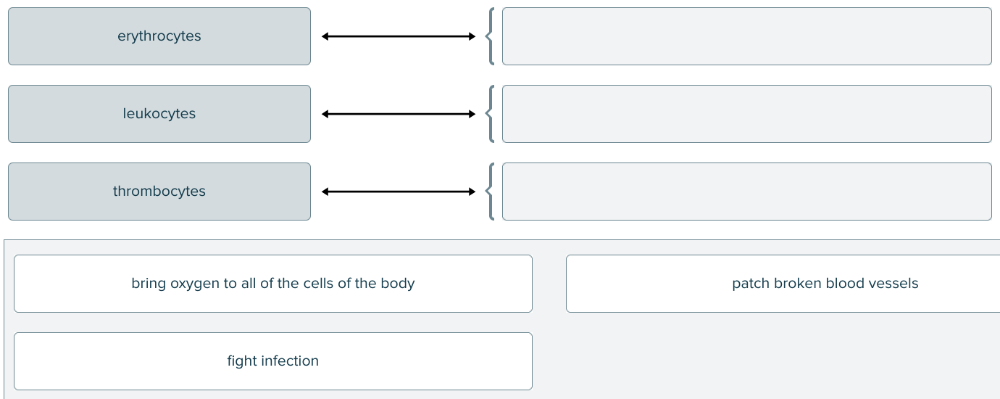
Match each blood cell with its function.

The root for clot is ______.
Multiple choice question.
- cyt/o
- coagul/o
- erythr/o
- thromb/o
thromb/o
Red blood cells contain a substance called ______.
Multiple choice question.
- neutrophils
- hemoglobin
- platelets
- immunoglobulins
hemoglobin
Select all that apply
The roots for blood are ______.
Multiple select question.
- cyt/o
- hemat/o
- hem/o
- thromb/o
- hemat/o
- hem/o
Select all that apply
Identify the types of white blood cells.
Multiple select question.
- basophils
- lymphocytes
- eosinophils
- neutrophils
- immunoglobulins
- Platelet
- basophils
- lymphocytes
- eosinophils
- neutrophils
Ex.
- immunoglobulins
Reason: The blood contains different types of white blood cells that fight different types of infections (neutrophils, lymphocytes, basophils, and eosinophils).
- Platelet
Reason: The blood contains different types of white blood cells that fight different types of infections (neutrophils, lymphocytes, basophils, and eosinophils).
The root cyt/o in the term thrombocytosis means ______.
cell
The function of platelets in the blood is to:
Multiple choice question.
- fight infection
- patch up broken vessels
- filter impurities from the blood
- carry hemoglobin
patch up broken vessels
A leukocyte is a ______ blood cell.
white
The ability for the blood to form clots is called ______.
Multiple choice question.
- thrombosis
- coagulation
- agglutination
- anticoagulant
coagulation
Deconstruct the term phlebotomy. Enter hyphens in the appropriate blanks.
______ ______ ______
Blank 1: phlebo
Blank 2: -
Blank 3: tomy
Hemophilia is a disease in which the blood does not clot well, potentially causing minor cuts to become life-threatening injuries. In the term "hemophilia", the root hemo- means ______.
blood
The lymph system includes lymph nodes, lymphatic vessels, the thymus, spleen and ______.
Multiple choice question.
- tonsils
- thyroid
- kidneys
- intestines
tonsils
Deconstruct the term hematology. Enter hyphens in the appropriate blanks.
______ ______ ______
Blank 1: hemato
Blank 2: -
Blank 3: logy
Select all that apply
The root myel/o means which of the following?
Multiple select question.
- Spine
- Bone marrow
- Spleen
- Lymphatic fluid
- Spine
- Bone marrow
The root for cell is ______.
Multiple choice question.
- ischem/o
- coagul/o
- cyt/o
- hem/o
cyt/o
The suffix -emia comes from a combination of the term hemo, meaning ______, and -ia, which means condition.
blood
The root for white is ______.
- Multiple choice question.
- erythr/o
- leuk/o
- lymph/o
- thromb/o
leuk/o
The masses of lymphoid tissue located at the back of the mouth at the top of the throat are the ______.
Multiple choice question.
- hormones
- vena cavae
- tonsils
- lymph nodes
tonsils
Select all that apply
The roots for vein are ______.
Multiple select question.
- ven/o
- hem/o
- thromb/o
- phleb/o
- ven/o
- phleb/o
The root splen/o means ______.
spleen
Select all that apply
Which of the following are true regarding the lymphatic system?
Multiple select question.
- It contains hemoglobin.
- It includes the spleen.
- It patches broken blood vessels.
- It plays a large part in the body's immune system.
- It includes the spleen.
- It plays a large part in the body's immune system.
The suffix -oma means tumor. A thymoma is a tumor in the ______.
Multiple choice question.
- lymph nodes
- thymus
- thyroid
- tonsils
thymus
The root lymph/o means ______.
lymph
The suffix -logy means study of. Immunology means the study of the ______.
Multiple choice question.
- immune system
- nervous system
- lymphatic system
- blood system
immune system
The suffix -emia refers to ______.
Multiple choice question.
- hemoglobin
- red blood cells
- blood condition
- platelets
blood condition
The tonsils are masses of ______.
Multiple choice question.
- platelets
- interstitial fluid
- lymphoid tissue
- red blood cells
lymphoid tissue
Deconstruct the term cytopenia. Enter hyphens in the appropriate blanks.
______ ______ ______
Blank 1: cyto
Blank 2: -
Blank 3: penia
The lymphatic organ that filters old red blood cells out of the blood is the ______.
Multiple choice question.
- tonsils
- lymph nodes
- spleen
- thymus
spleen
The medical term used for small, flat, red spots on the body is ______.
Multiple choice question.
- petechia
- ecchymosis
- keloid
- cicatrix
petechia
The root thym/o means ______.
thymus
Swelling caused by an abnormal accumulation of lymph, usually in the extremities, is ______.
Multiple choice question.
- lymphocyte
- lymphoma
- lymphedema
- lymphadenopathy
lymphedema
The ______ system is the body's defensive system against foreign invaders.
immune
Select all that apply
Which of the following describe anemia?
Multiple select question.
- It is a mass of blood within an organ.
- It is an excessive number of platelets.
- It is a reduction of red blood cells.
- The patient notices weakness and fatigue.
...
Deconstruct the term anemia. Enter hyphens in the appropriate blanks.
______ ______ ______
Blank 1: an
Blank 2: -
Blank 3: emia
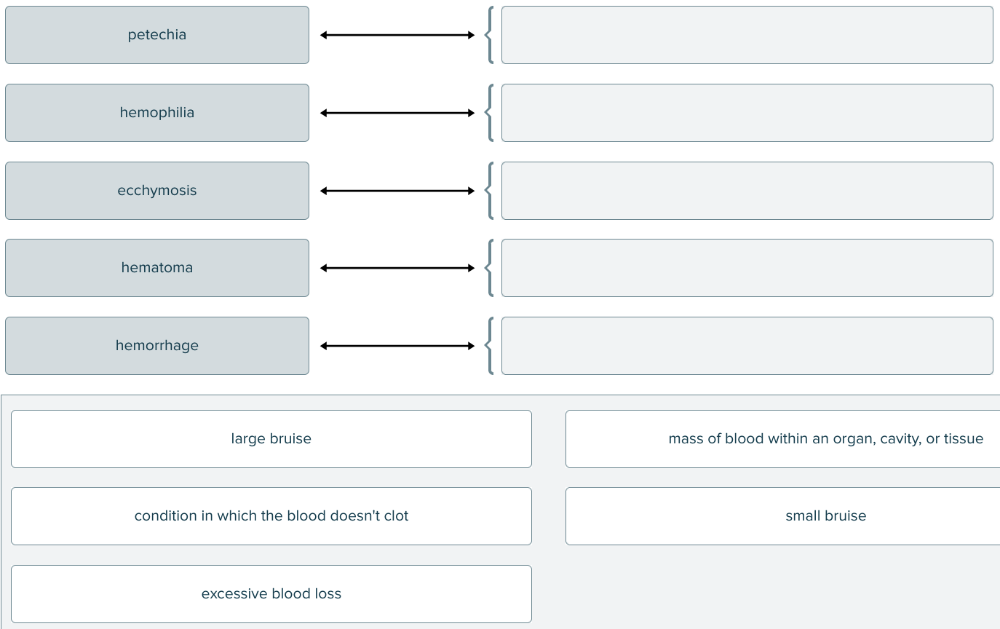
Match each blood disorder with its description.
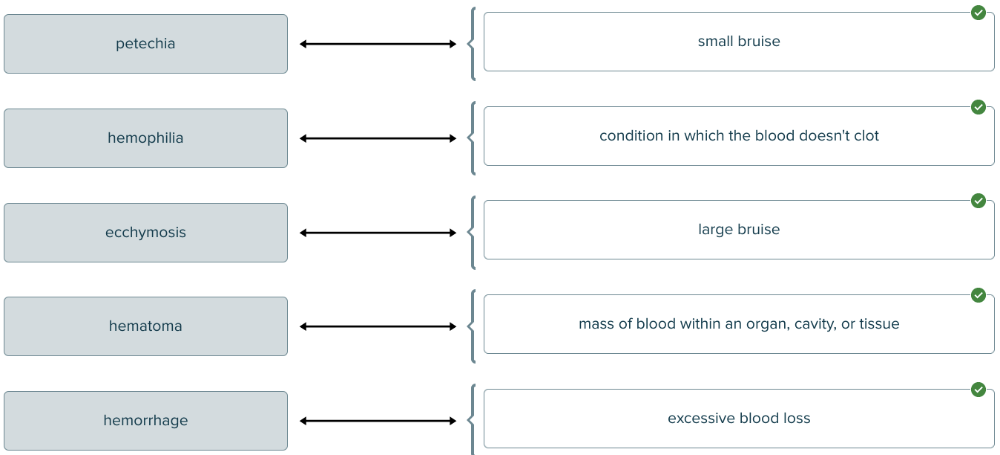
The suffix -penia refers to ______.
Multiple choice question.
- dilation
- deficiency
- blockage
- excessive
deficiency
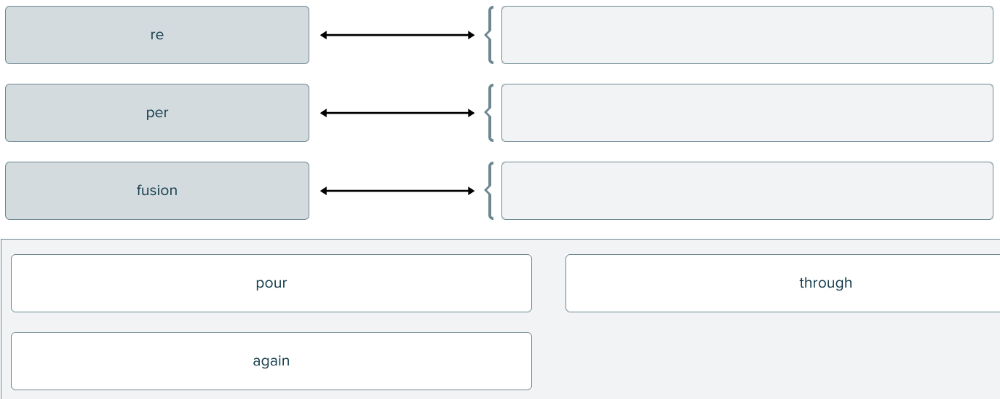
Match the word parts of the term "reperfusion" with their meanings.

Select all that apply
Which of the following are blood disorders?
Multiple select question.
- petechia
- hemophilia
- ecchymosis
- lymphedema
- splenalgia
- petechia
- hemophilia
- ecchymosis
Any disease of a lymph gland (node) is a ______.
Multiple choice question.
- lymphoma
- lymphadenitis
- lymphedema
- lympadenopathy
lympadenopathy
The term used to refer to noticeably swollen lymph nodes, especially in the neck, is ______.
Multiple choice question.
- lymphedema
- lymphadenopathy
- lymphocyte
- lymphoma
lymphadenopathy
A reduction in red blood cells can cause ______.
- Multiple choice question.
- anemia
- leukocytosis
- ecchymosis
- neutropenia
anemia
Lymphedema is swelling caused by an abnormal accumulation of lymph, usually in the ______.
Multiple choice question.
- pelvic region
- neck
- extremities
- axilla
extremities
The medical term for a large bruise is ______.
Multiple choice question.
- petechia
- ecchymosis
- hematoma
- hemorrhage
ecchymosis
Splenalgia is ______.
Multiple choice question.
- inflammation in the spleen
- pain in the spleen
- a tumor in the spleen
- enlargement of the spleen
pain in the spleen
An injury to tissue that occurs after blood flow is restored is a ______.
Multiple choice question.
- hemorrhagic episode
- reperfusion injury
- lymphoma
- lymphedema
reperfusion injury
The abbreviation for the laboratory test "complete blood count" is ______.
CBC
Select all that apply
Which of the following describe lymphadenopathy?
Multiple select question.
- Any disease of a lymph gland (node)
- Swelling usually caused by abnormal accumulation of lymph
- Inflammation of lymph vessels
- Noticeably swollen lymph nodes, especially in the neck
- Any disease of a lymph gland (node)
- Noticeably swollen lymph nodes, especially in the neck
A higher-than-normal number of red blood cells is known as ______.
polycythemia or erythrocytosis
Swelling caused by an abnormal accumulation of lymph, usually in the extremities, is ______.
Multiple choice question.
- lymphocyte
- lymphedema
- lymphadenopathy
- lymphoma
lymphedema
Leukopenia is a low number of ______ ______ cells.
Blank 1: white
Blank 2: blood
Select all that apply
Which of the following describe lymphedema?
Multiple select question.
- Swelling caused by abnormal accumulation of lymph
- Swollen lymph nodes in the neck
- Any disease of a lymph node
- Usually occurs in the extremities
- Swelling caused by abnormal accumulation of lymph
- Usually occurs in the extremities
The term used to describe a condition with abnormal blood clotting and forming a floating clot is ______.
thromboembolism
Select all that apply
The suffixes that mean "pain" are ______.
Multiple select question.
- -dynia
- -algia
- -megaly
- -edema
- -dynia
- -algia
Select all that apply
Anemias with enlarged blood cells (macrocytosis) can be a result of ______.
Multiple select question.
- B12 deficiency
- folate deficiency
- bleeding
- iron deficiency
- B12 deficiency
- folate deficiency
Select all that apply
Which of the following are true of a complete blood count test?
Multiple select question.
- It can be abbreviated BBC.
- It only looks at white blood cell counts.
- It is a diagnostic laboratory test.
- It is one of the most common tests in medicine.
- A machine counts the number of each type of cell in the blood
- It is a diagnostic laboratory test.
- It is one of the most common tests in medicine.
- A machine counts the number of each type of cell in the blood
Enlargement of the spleen is ______.
Multiple choice question.
- splenoptosis
- splenomegaly
- splenomalacia
- splenectomy
splenomegaly
Select all that apply
Which of the following describe anemia?
Multiple select question.
- It is the most common blood problem.
- It is an excessive amount of red blood cells.
- It has a variety of causes.
- It is the most common blood problem.
- It has a variety of causes.
A condition characterized by an increase in the number of oval-shaped red blood cells is ______.
elliptocytosis
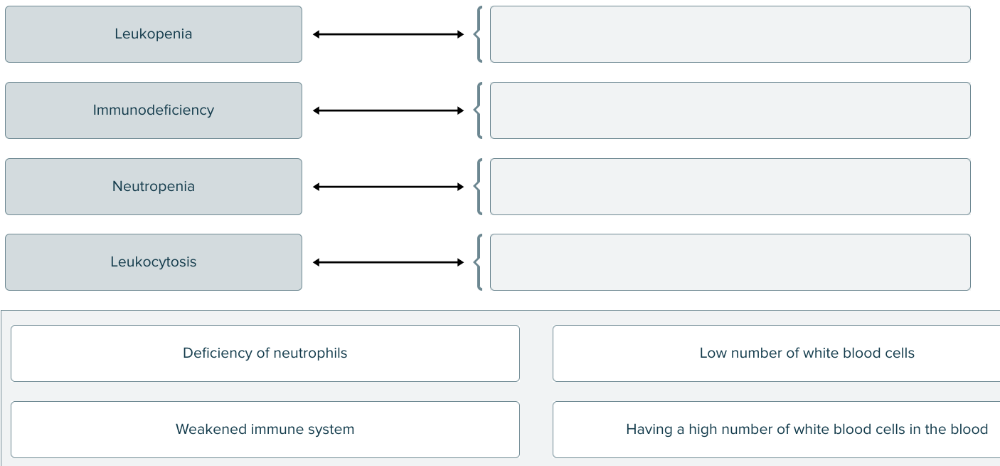
Match the terms related to white blood cells with their meanings.
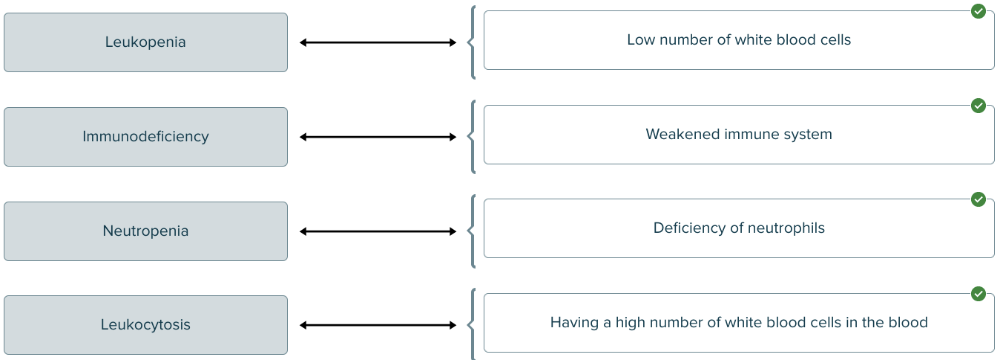
A mass of matter present in the blood is an ______.
Multiple choice question.
- embolism
- embolus
- ecchymosis
- erythrocyte
embolus
A deficiency in the number of platelets is ______.
Multiple choice question.
- thrombosis
- thrombocytopenia
- thromboembolism
- thrombus
thrombocytopenia
Select all that apply
Blood cells with abnormal shapes include
Multiple select question.
- elliptocyte.
- spherocyte.
- microcyte.
- macrocyte.
- normocyte.
- elliptocyte.
- spherocyte.
The root erythro in the term erythrocyte means ______.
red
The absence of a spleen is called ______.
asplenia
Deconstruct the term hematopoiesis. Enter hyphens in the appropriate blanks.
______ ______ ______
Blank 1: hemato
Blank 2: -
Blank 3: poiesis
An oval red blood cell is called a(n) ______.
elliptocyte
The breakdown of blood cells is ______.
Multiple choice question.
- erthrocytosis
- hematopoiesis
- leukopenia
- hemolysis
hemolysis
An embolism is a(n) ______.
Multiple choice question.
- blockage in a blood vessel caused by an embolus
- oval red blood cell
- mass of matter present in the blood
- breakdown of blood cells
blockage in a blood vessel caused by an embolus
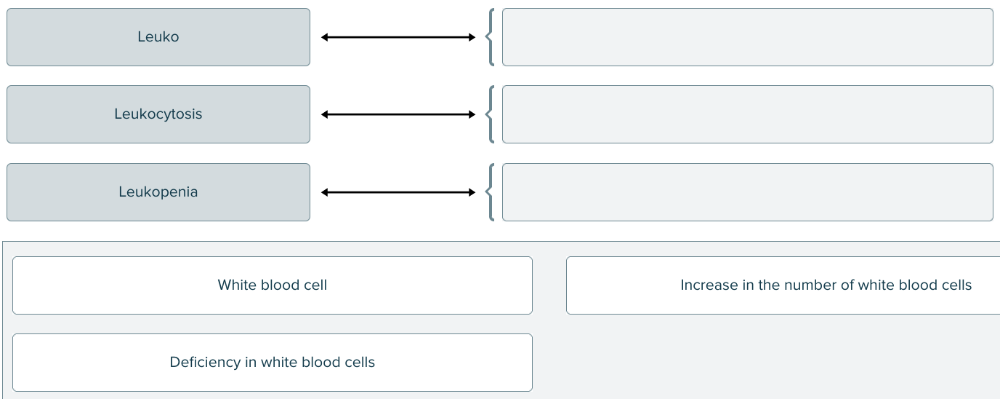
Match each term pertaining to white blood cells with its description.

The term used to describe a condition with abnormal blood clotting and forming a floating clot is ______.
thromboembolism
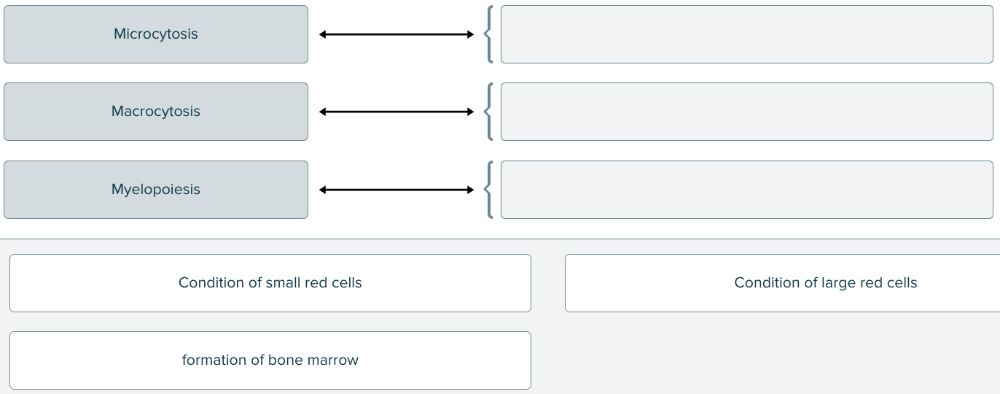
Match the terms related to cell condition and formation with their definitions.

An erythrocyte is a ______.
Multiple choice question.
- blood clot
- formation of blood cells
- white blood cell
- red blood cell
red blood cell
Neutropenia is a deficiency of neutrophils in the blood. Deconstruct the term neutropenia. Enter hyphens in the appropriate blanks.
______ ______ ______
Blank 1: neutro
Blank 2: -
Blank 3: penia
Hematopoiesis is the formation of red ______ cells.
blood
Select all that apply
Which of the following terms mean a higher than normal number of red blood cells?
Multiple select question.
- Polycythemia
- Anemia
- Erythrocytosis
- Leukocytosis
- Polycythemia
- Erythrocytosis
Ex.
- Anemia
Reason: Anemia is a lower than normal number of red cells.
- Leukocytosis
Reason: Leukocytes are white cells.
Spell the term that means the breakdown of blood cells ______.
hemolysis
A spherical red blood cell is called ______.
spherocyte
An increase in the number of white blood cells is termed ______.
- Multiple choice question.
- thrombocytopenia
- leukocytosis
- erythrocytosis
- leukopenia
leukocytosis
An increase in the number of platelets is called ______.
thrombocytosis
Deconstruct the term macrocytosis. Enter hyphens in the appropriate blanks.
______ ______ ______ ______ ______
Blank 1: macro
Blank 2: -
Blank 3: cyt
Blank 4: -
Blank 5: osis
The blockage of a vessel caused by a clot that has broken off from where it formed is a thromboembolism. Deconstruct the term thromboembolism. Enter hyphens in the appropriate blanks.
______ ______ ______ ______ ______
Blank 1: thrombo
Blank 2: -
Blank 3: embol
Blank 4: -
Blank 5: ism
During phagocytosis, phagocytes destroy foreign microorganisms or cell debris. The root "phago" in this term means ______.
eat or eating
In asplenia, the organ that is absent or not functioning is the ______.
spleen
The root cyt- in the terms erythrocytosis and polycythemia means ______.
cell
Select all that apply
The organs that are affected in hepatosplenomegaly are ______.
Multiple select question.
- bone marrow
- liver
- spleen
- lymph nodes
- liver
- spleen
A reticulocyte is a(n) ______.
Multiple choice question.
- red blood cell
- white blood cell
- platelet
red blood cell
A lymphocyte is a ______.
- Multiple choice question.
- lymphatic tumor
- lymph node
- lymph cell
- lymph vessel
lymph cell
Select all that apply
Thrombocytes ______.
Multiple select question.
- transport hemoglobin
- are also known as platelets
- help blood clot
- fight infection
- are also known as platelets
- help blood clot
An abnormal deficiency in lymph is called ______.
Multiple choice question.
- lymphopenia
- pancytopenia
- thrombocytopenia
- leukopenia
lymphopenia
The formation of a blood clot is ______.
Multiple choice question.
- thrombogenic
- thrombosis
- thrombocytopenia
- thromboembolism
thrombosis
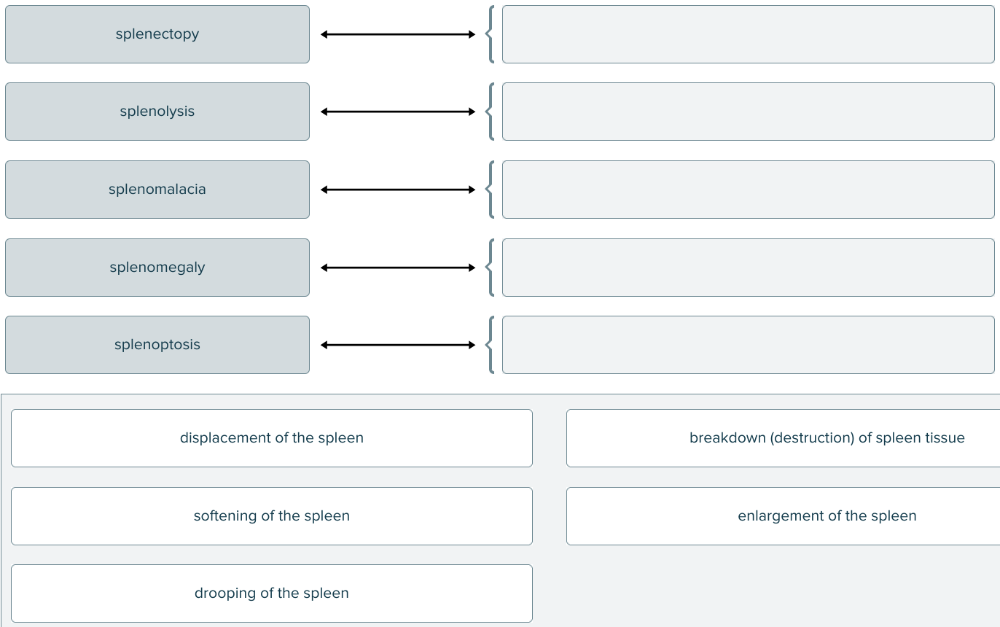
Match the disorder associated with the spleen to its definition.
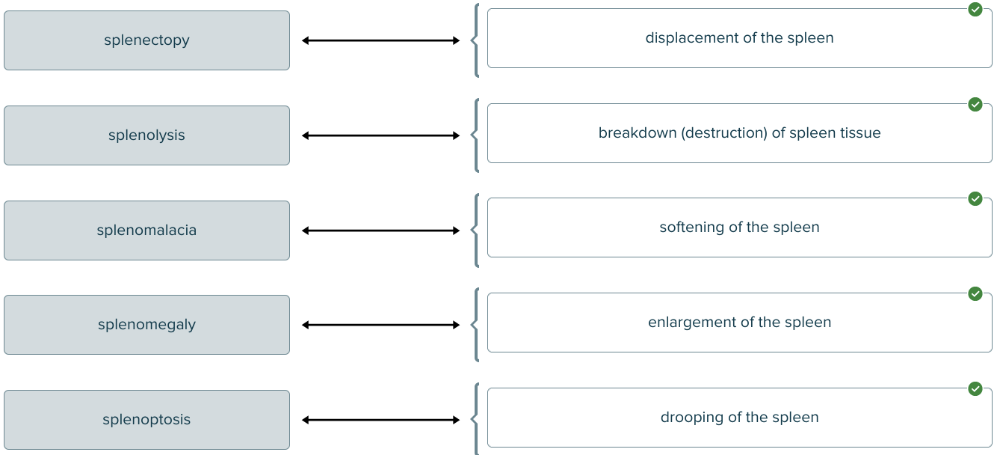
The prefix in the term asplenia means ______.
no, without, or absence
Overdevelopment of the thymus is ______.
Multiple choice question.
- thymic hypoplasia
- thymic hypertrophy
- thymoma
- thymic hyperplasia
thymic hyperplasia
An enlargement of the spleen and liver is called ______.
hepatosplenomegaly
A hematocrit test is used to determine the ratio of red blood cells to ______.
Multiple choice question.
- platelets
- total blood volume
- hemoglobin
- white blood cells
total blood volume
Deconstruct the term lymphocyte. Enter hyphens in the appropriate blanks.
______ ______ ______
Blank 1: lympho
Blank 2: -
Blank 3: cyte
Deconstruct the term hemoglobin. Enter hyphens in the appropriate blanks.
______ ______ ______
Blank 1: hemo
Blank 2: -
Blank 3: globin
In the term lymphopenia, the suffix means ______.
deficiency or deficient
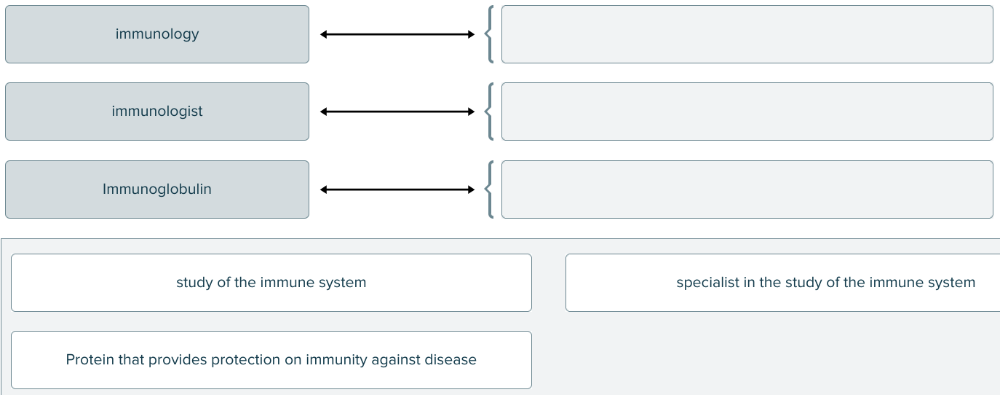
Match each immune system term with its description.

Splenomalacia is ______.
Multiple choice question.
- drooping of the spleen
- softening of the spleen
- breakdown of the spleen
- enlargement of the spleen
softening of the spleen
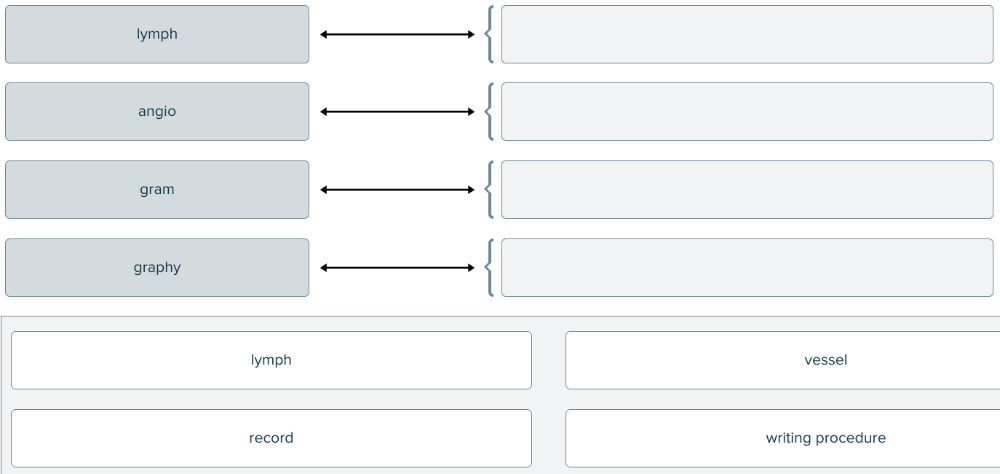
Match the word parts of the terms lymphangiogram and lymphangiography with their meanings.
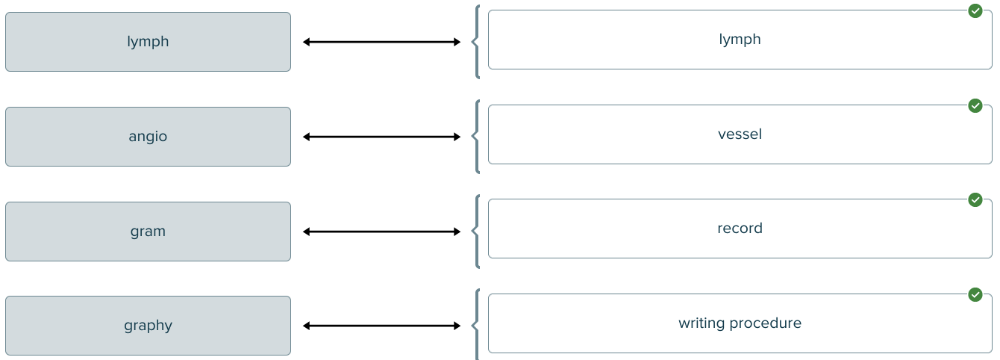
Thymic hyperplasia is a(n) ______.
Multiple choice question.
- overdevelopment of the thymus
- underdevelopment of the thymus
- tumor of the thymus
- absence of the thymus
overdevelopment of the thymus
A device used to measure blood pressure is a ______.
Multiple choice question.
- phlebotomist
- hematometer
- sphygmomanometer
- perfusion
sphygmomanometer
Select all that apply
In a hematocrit test, blood is separated into formed and non-formed elements, including ______.
Multiple select question.
- centrifuge
- plasma
- erythrocytes
- platelets
- leukocytes
- plasma
- erythrocytes
- platelets
- leukocytes
Ex.
- centrifuge
Reason: a centrifuge is a machine used to separate the blood
The prefix anti- in the terms antibody and antigen means ______.
against
Match the word parts related to the blood with their meanings.
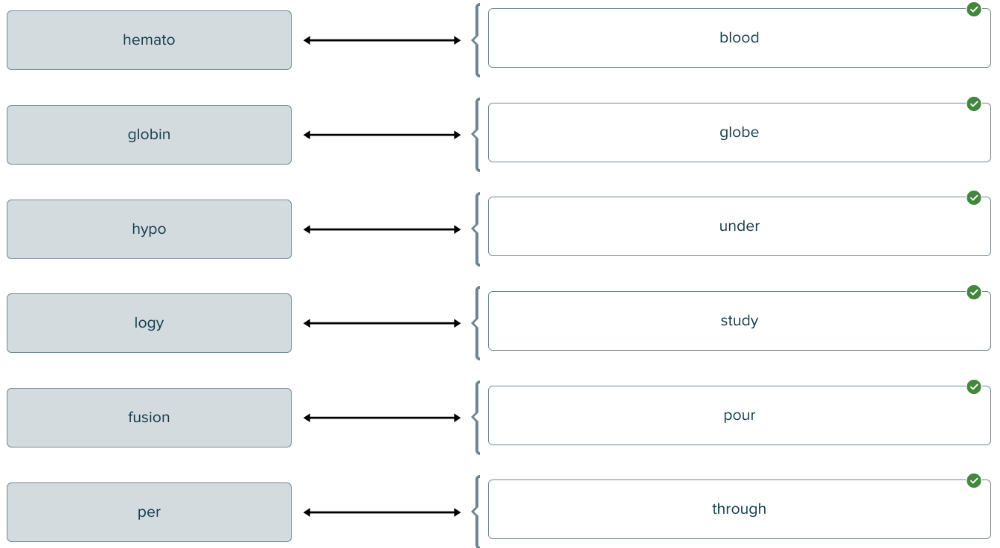
The study of the immune system is called ______.
immunology
A protein that provides protection against disease is a(n) ______.
Multiple choice question.
- immunoglobulin
- immunity
- immunologist
- immunology
immunoglobulin
Hemolytic anemia is characterized by ______.
Multiple choice question.
- production of too many red blood cells
- a destruction of red blood cells
- inadequate production of red blood cells
a destruction of red blood cells
A lymphangiogram is a record of the study of ______.
Multiple choice question.
- lymph glands
- lymph pathways
- lymph vessels
- lymph
lymph vessels
When a deficiency of white blood cells causes the patient to be more vulnerable to infections, it is called a(n) ______.
Multiple choice question.
- immunosuppression
- autoimmune disease
- immunology
- immune deficiency
immune deficiency
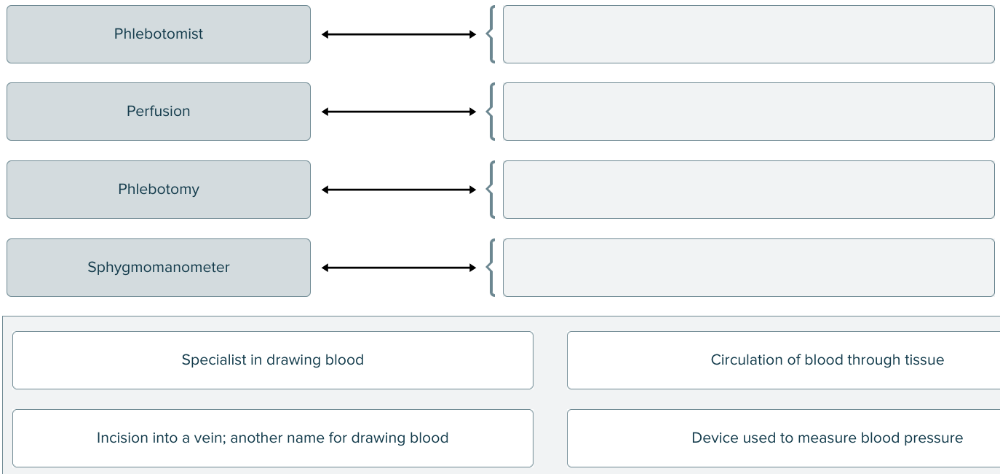
Match each professional term related to blood with its description.
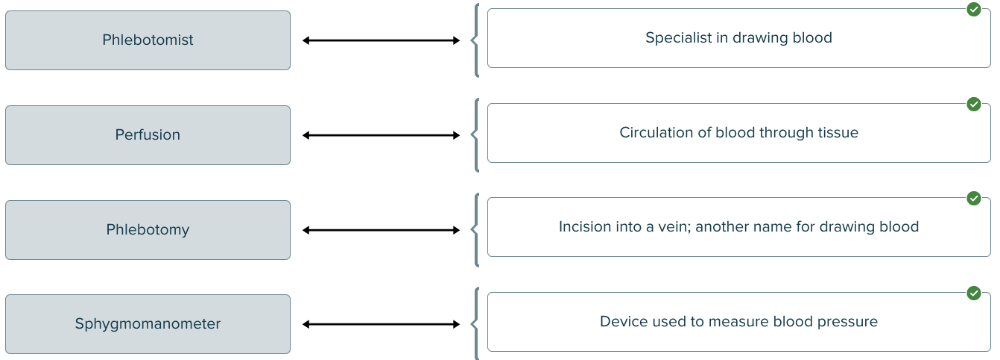
An increased ability of the blood to coagulate is ______.
Multiple choice question.
- hypocoagulability
- spherocytosis
- phlebarteriectasia
- hypercoagulability
hypercoagulability
Spell the term that means "a substance produced by the body in response to an antigen". ______.
antibody
An antibody is a substance produced by the body in response to a(n) ______.
Multiple choice question.
- antigen
- erythrocyte
- platelet
- splenoptosis
antigen
The root in the term hyperlipidemia means ______.
fat
Deconstruct the term immunology. Enter hyphens in the appropriate blanks.
______ ______ ______
Blank 1: immuno
Blank 2: - or /
Blank 3: logy
The most common type of red blood cell problem associated with not having enough of them is ______.
Multiple choice question.
- erythrocytosis
- anemia
- polycythemia
- hemolysis
anemia
The most common infection that affects the spleen is ______.
Multiple choice question.
- leukemia
- lymphadenitis
- mononucleosis
- osteomyelitis
mononucleosis
______ occurs when medication or illness causes a deficiency of white blood cells.
Multiple choice question.
- Mononucleosis
- Immunocompromised
- Autoimmune disease
- Immunosuppression
Immunosuppression
The prefix auto- in the term "autoimmune" means ______.
self
Define thrombocytopenia.
Multiple choice question.
- Increased platelet count
- Decreased fibrinogen content
- Increased fibrinogen content
- Decreased platelet count
Decreased platelet count
The term for a disease that deals with problems in blood coagulation is ______.
Multiple choice question.
- immunosuppression
- coagulopathy
- autoimmune disease
- ischemia
coagulopathy
The presence of disease-causing microorganisms in the blood is ______.
Multiple choice question.
- uremia
- hypervolemia
- septicemia
- leukemia
septicemia
An immune system with decreased or compromised response to disease-causing organisms is termed ______.
Multiple choice question.
- immunodeficiency
- autoimmune disease
- immunosuppression
- immunology
immunodeficiency
Deconstruct the term ischemia. Enter hyphens in the appropriate blanks.
______ ______ ______
Blank 1: isch
Blank 2: -
Blank 3: emia
Match the term related to disorders of the lymphatic system with its definition.
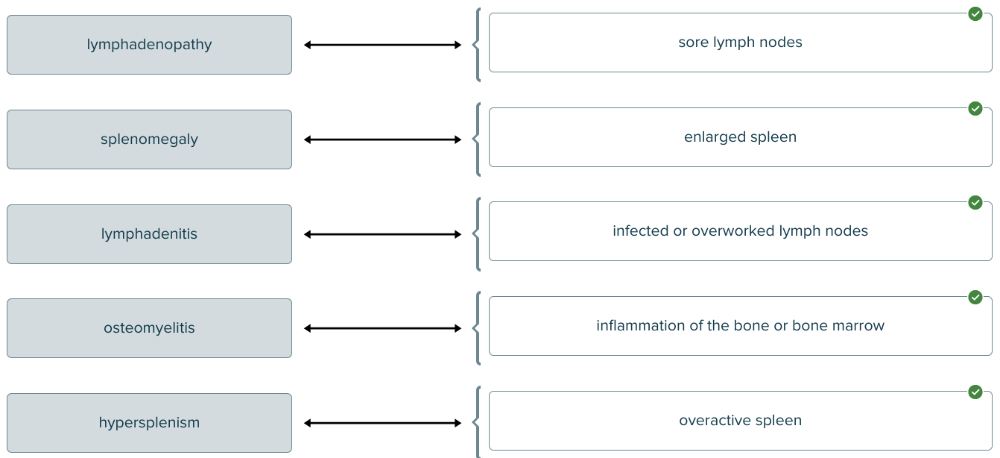
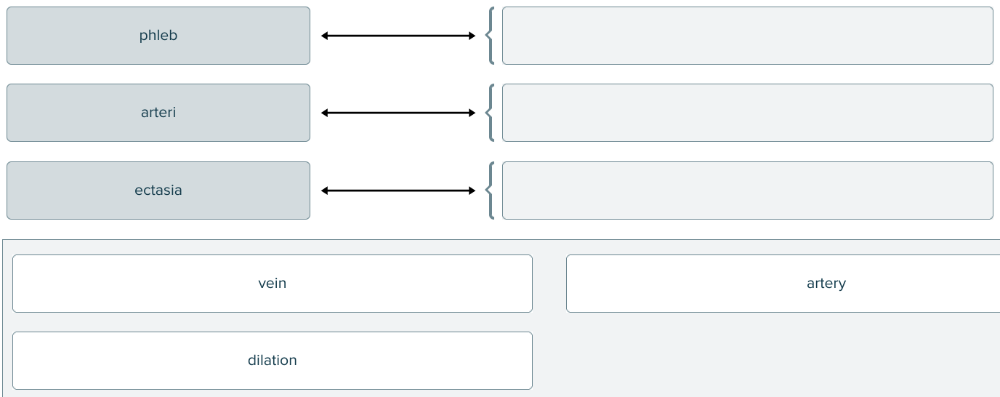
Match the word parts of the term phlebarteriectasia with their meanings.

A disease caused by the body's immune system attacking the body's own healthy tissue is ______.
Multiple choice question.
- immunodeficiency
- immunosuppression
- autoimmune disease
- immunocompromised
autoimmune disease
The suffix in the term spherocytosis means ______.
Multiple choice question.
- condition
- inflammation
- disease
- tumor
condition
Select all that apply
Deep vein thrombosis ______.
Multiple select question.
- is the formation of a blood clot in a vein deep in the body
- occurs most commonly in the leg
- is the dilation of a vein
- is the inflammation of a vein caused by a blood clot
- is the formation of a blood clot in a vein deep in the body
- occurs most commonly in the leg
Deconstruct the term thrombophlebitis. Enter hyphens in the appropriate blanks.
______ ______ ______ ______ ______
Blank 1: thrombo
Blank 2: -
Blank 3: phleb
Blank 4: -
Blank 5: itis

Match each term regarding the immune system with its description.

The correct pronunciation of hemolytic is ______.
Multiple choice question.
- HIGH-mol-eye-TECH
- hEE-moh-LIH-tik
- hIGH-molly-tic
- hee-MOLLY-tic
hEE-moh-LIH-tik
The blockage of blood flow to an organ is ______.
Multiple choice question.
- coagulopathy
- perfusion
- ischemia
- thrombophlebitis
ischemia
Deconstruct the term bilirubinemia. Enter hyphens in the appropriate blanks.
______ ______ ______ ______ ______
Blank 1: bili
Blank 2: - or /
Blank 3: rubin
Blank 4: - or /
Blank 5: emia
Dilation of blood vessels is ______.
Multiple choice question.
- thrombophlebitis
- immunosuppression
- phlebotomy
- phlebarteriectasia
phlebarteriectasia
Decreased blood volume is ______.
Multiple choice question.
- hyperlipidemia
- aplastic anemia
- hypervolemia
- hypovolemia
hypovolemia
A condition in which red blood cells assume a spherical shape is called ______.
spherocytosis
Deconstruct the term septicemia. Enter hyphens in the appropriate blanks.
______ ______ ______
Blank 1: septic
Blank 2: -
Blank 3: emia
Thrombophlebitis is inflammation of a vein caused by a(n) ______.
Multiple choice question.
- platelet
- autoimmune disease
- erythrocyte
- clot
clot
The presence of urine in the blood is called ______.
uremia
The prefix in the term anemia means ______.
no, without, or absence
Hepatosplenitis refers to ______.
Multiple choice question.
- inflammation of the liver and spleen
- infection of the kidneys and spleen
- enlargement of the liver and spleen
- underdevelopment of the liver and and spleen
inflammation of the liver and spleen
Hyperbilirubinemia is ______.
Multiple choice question.
- increased blood volume
- excessive bilirubin in the blood
- deficient bilirubin in the blood
- presence of bilirubin in the blood
excessive bilirubin in the blood
Deconstruct the term hypersplenism. Enter hyphens in the appropriate blanks.
______ ______ ______ ______ ______
Blank 1: hyper
Blank 2: -
Blank 3: splen
Blank 4: -
Blank 5: ism
Hyperlipidemia is ______.
Multiple choice question.
- excessive fat in the blood
- excessive cholesterol in the blood
- increased blood volume
- excessive bilirubin in the blood
excessive fat in the blood
Deconstruct the term lymphangiectasia by separating the roots and the suffix with hyphens. Enter hyphens in the appropriate blanks.
______ ______ ______ ______ ______
Blank 1: lymph
Blank 2: -
Blank 3: angi
Blank 4: -
Blank 5: ectasia
Septicemia is the presence of disease-causing microorganisms in the ______.
Multiple choice question.
- blood
- spleen
- heart
- lymph
blood
A disease characterized by poor production of blood cells by the bone marrow is ______.
Multiple choice question.
- osteomyelitis
- lymphadenitis
- myelodysplasia
- thymopathy
myelodysplasia
Deconstruct the term uremia. Enter hyphens in the appropriate blanks.
______ ______ ______
Blank 1: ur
Blank 2: -
Blank 3: emia
Splenorrhexis is ______.
Multiple choice question.
- enlargement of the spleen
- rupture of the spleen
- inflammation of the spleen
- any disease of the spleen
rupture of the spleen
Select all that apply
Hepatosplenitis is inflammation of the ______.
Multiple select question.
- stomach
- spleen
- liver
- pancreas
- spleen
- liver
The suffix in the term thymopathy means ______.
disease
An increased spleen activity is called ______.
Multiple choice question.
- splenitis
- splenopathy
- hepatosplenitis
- hypersplenism
hypersplenism
Deconstruct the term “tonsillitis” associated with the disorders of the lymphatic system. Enter hyphens in the appropriate blanks.
______ ______ ______
Blank 1: tonsill
Blank 2: -
Blank 3: itis
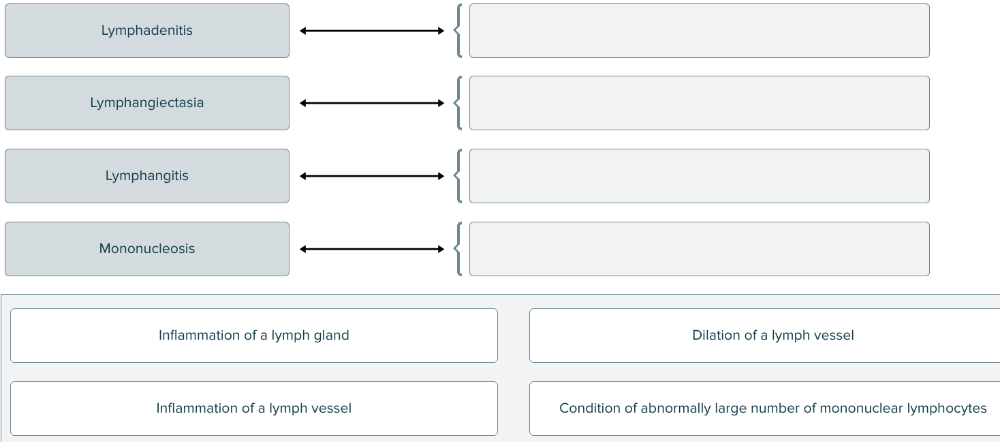
Match the terms related to the lymphatic system with their meanings.
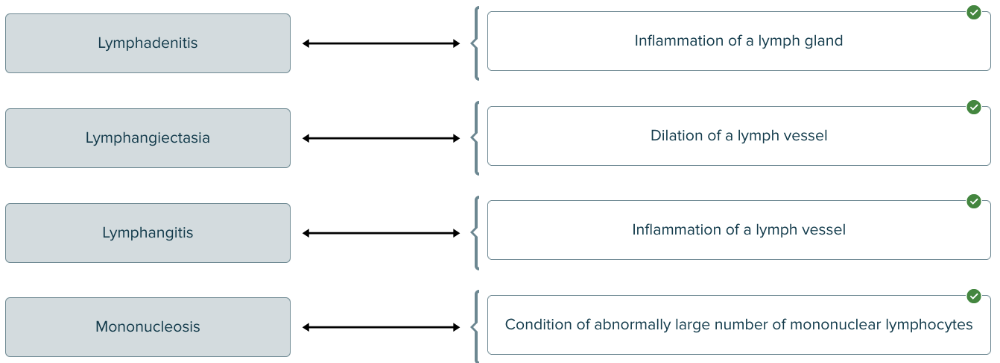
Select all that apply
Leukemia is ______.
Multiple select question.
- cancer of the lymphatic system and immune system
- characterized by the abnormal increase of white blood cells
- cancer of the blood or bone marrow
- increased blood volume
- characterized by the abnormal increase of white blood cells
- cancer of the blood or bone marrow
Match the terms related to bone marrow conditions with their meanings.
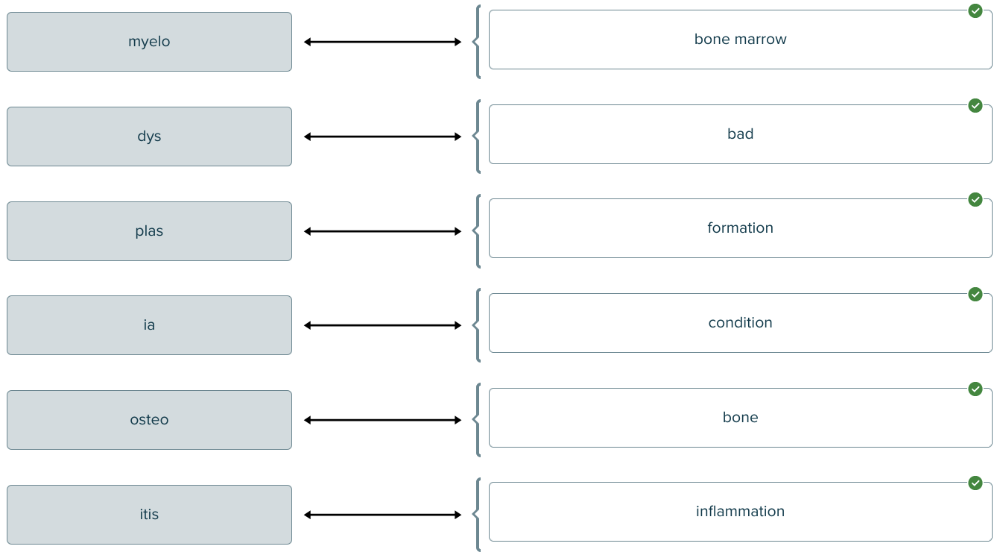
A cancerous tumor of the bone marrow is a ______.
Multiple choice question.
- lymphoma
- myeloma
- thymoma
- hematoma
myeloma
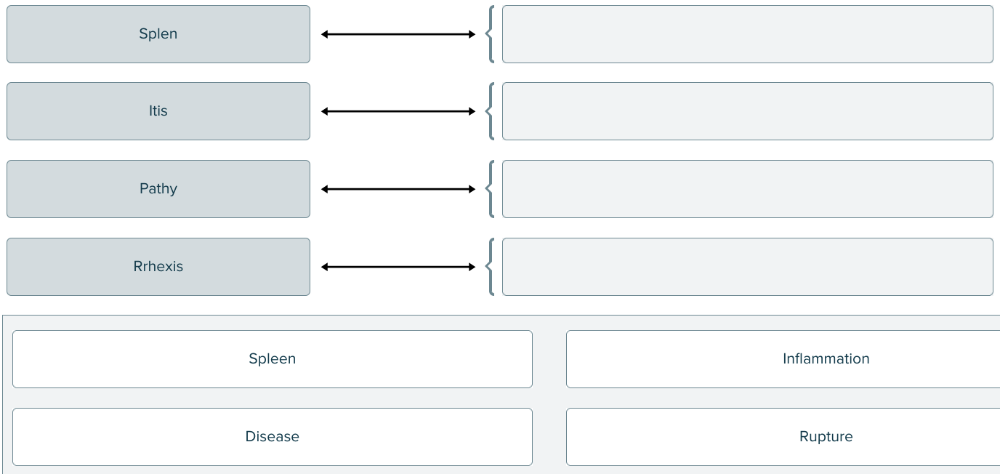
Match the words parts related to diseases of the spleen with their meanings.
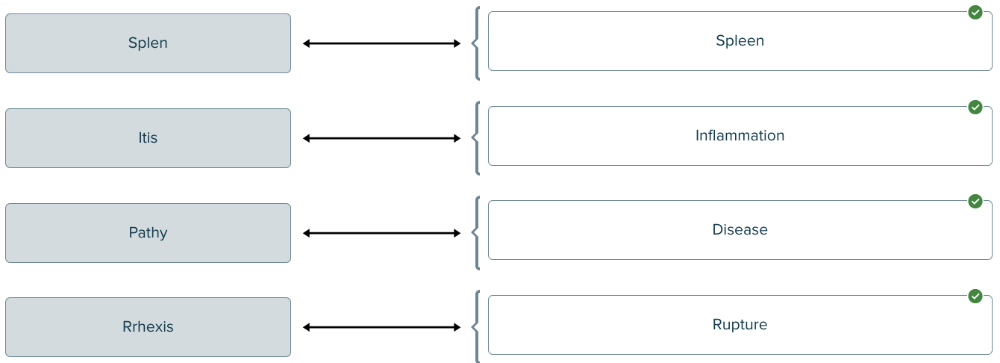
Deconstruct the term immunocompromised. Enter hyphens in the appropriate blanks.
______ ______ ______
Blank 1: immuno
Blank 2: -
Blank 3: compromised
Thymopathy means disease of the ______.
Multiple choice question.
- thyroid
- lymph node
- tonsil
- spleen
- thymus
thymus
A drug that prevents the coagulation of blood is a(n) ______.
Multiple choice question.
- hemostatic
- anticoagulant
- thrombolytic
- transfusion
anticoagulant
Tonsillitis means ______ of the tonsils.
inflammation
Surgical removal of the spleen is called ______.
splenectomy
Cancer of the blood or bone marrow characterized by the abnormal increase in white blood cells is ______.
Multiple choice question.
- hypervolemia
- osteomyelitis
- lymphoma
- leukemia
leukemia
A drug that breaks down blood clots is a(n) ______.
Multiple choice question.
- hemolytic
- thrombolytic
- hemostatic
- anticoagulant
thrombolytic
The root in the term myeloma means ______.
Multiple choice question.
- bone marrow
- muscle
- lymph vessel
- blood vessel
bone marrow
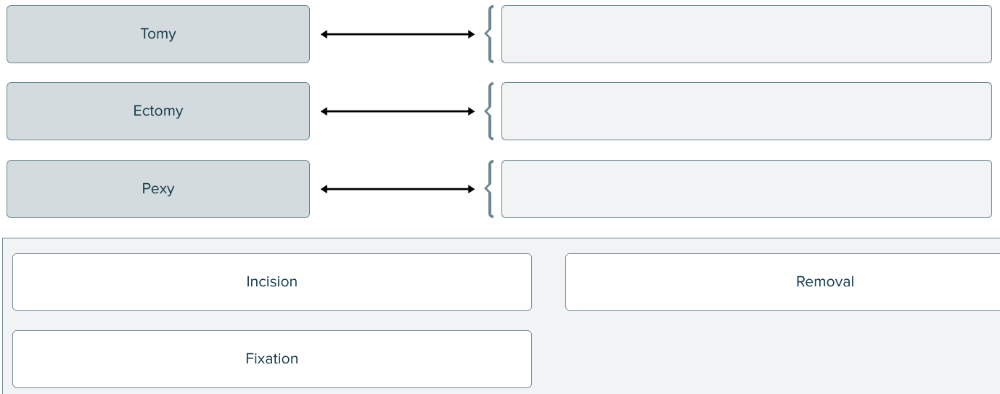
Match the suffixes related to lymph system surgical procedures to their meanings.

Having an immune system incapable of responding normally and completely to a pathogen or disease is the definition of ______.
- Multiple choice question.
- immunosuppression
- autoimmune disease
- immunodeficiency
- immunocompromised
immunocompromised
Match each term related to transfusions with its definition.
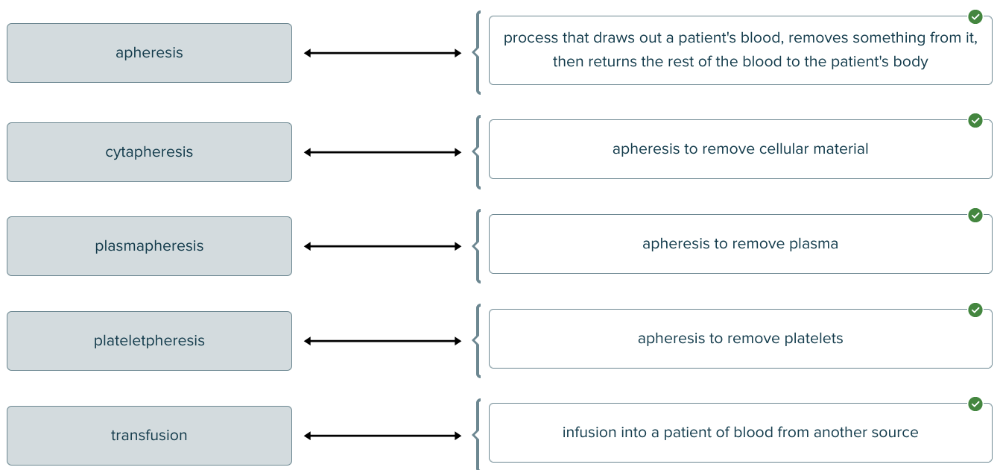
Select all that apply
Thrombolytics are medicines used to ______.
Multiple select question.
- prevent clots
- form clots
- fight infection
- breakdown clots
breakdown clots
A lymphadenectomy is the surgical removal of the ______.
Multiple choice question.
- lymphatic system
- lymph vessels
- lymph
- lymph nodes
lymph nodes
The V in the abbreviation EBV stands for ______.
virus
The suffix -static in the term hemostatic means ______.
Multiple choice question.
- breakdown
- clot
- standing
- coagulation
standing
Spell the term that is abbreviated IV ______.
intravenous
Deconstruct the term lymphadenotomy. Enter hyphens in the appropriate blanks.
______ ______ ______ ______ ______
Blank 1: lymph
Blank 2: -
Blank 3: adeno
Blank 4: -
Blank 5: tomy
Deconstruct the term cytapheresis. Enter hyphens in the appropriate blanks.
______ ______ ______
Blank 1: cyt
Blank 2: -
Blank 3: apheresis
A drug that prevents the coagulation of blood is a(n) ______.
Multiple choice question.
- hemostatic
- transfusion
- anticoagulant
- thrombolytic
anticoagulant
Select all that apply
Abbreviations for types of leukemia include ______.
Multiple select question.
- PLT
- AML
- LAD
- ALL
- AML
- ALL
PTT stands for ______.
Multiple choice question.
- platelet count
- partial thromboplastin time
- post thrombin time
- purpura thrombocytopenia
partial thromboplastin time